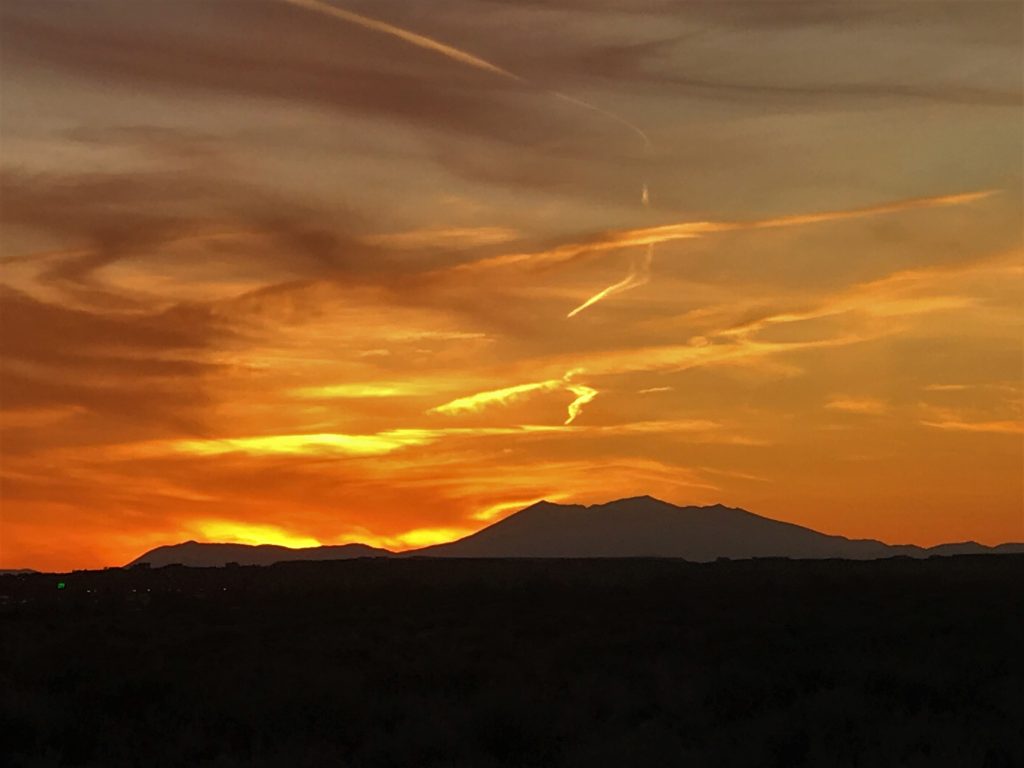Homolovi State Park, Winslow, Arizona
He who guards his mouth and his tongue keeps himself from calamity. ~ Proverbs 21:23
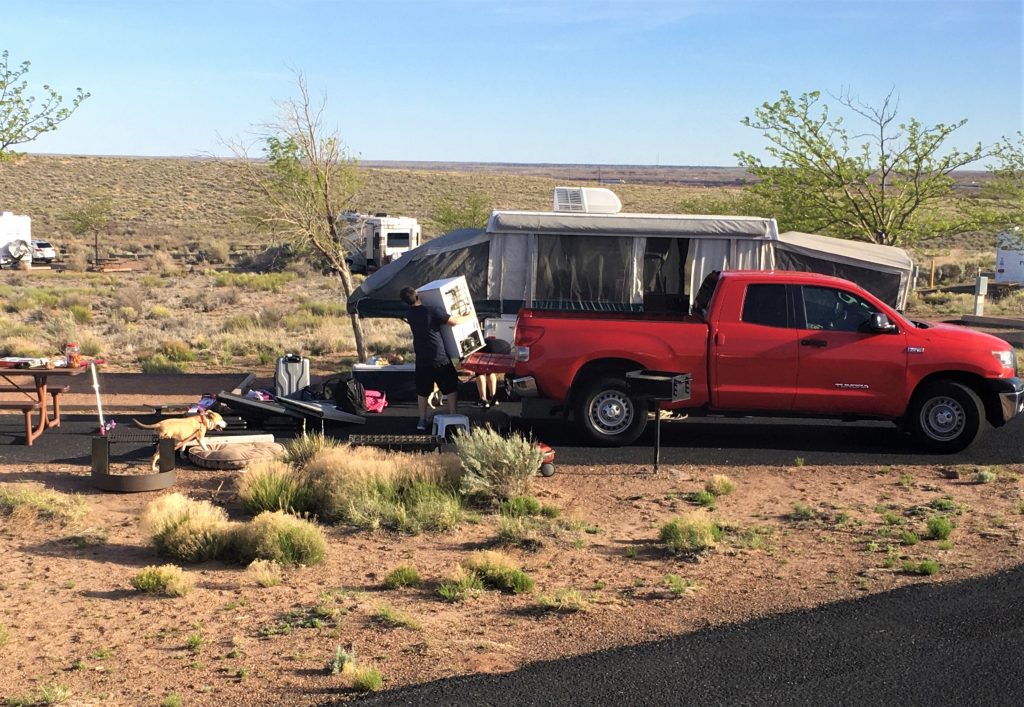
They even brought a refrigerator! : )
When you think of Winslow, Arizona, does anything spring to mind? Like maybe a song? Like maybe a song performed by the “Eagles”? Like maybe their first single that was released in May, 1972?
I was standin’ on a corner in Winslow, Arizona, such a fine sight to see . . . .
That’s just one of the many things we explored today! The town of Winslow actually made a Park in downtown, and they actually named it “Standin’ on the Corner Park! Can you believe it?!? And in 1998 the song, “Take it Easy”, was inducted into The Rock and Roll Hall of Fame’s 500 Songs that Shaped Rock and Roll; three years after the Rock Hall opened.
Below is a list of the things we experienced today. They have history included, so you can read and learn or skim, or ignore altogether. Although, since you’re isolated at home, what else have you got to do? 😊
We covered:
- The Worlds’ Smallest Church – – It’s called the Church of the Mother Road and measures 7’ x 4.5’ and is complete with two seats. Not sure this qualifies as a church, but that’s what the sign says. And the area where it was located was locked up tight, but you could still see it through the bars.
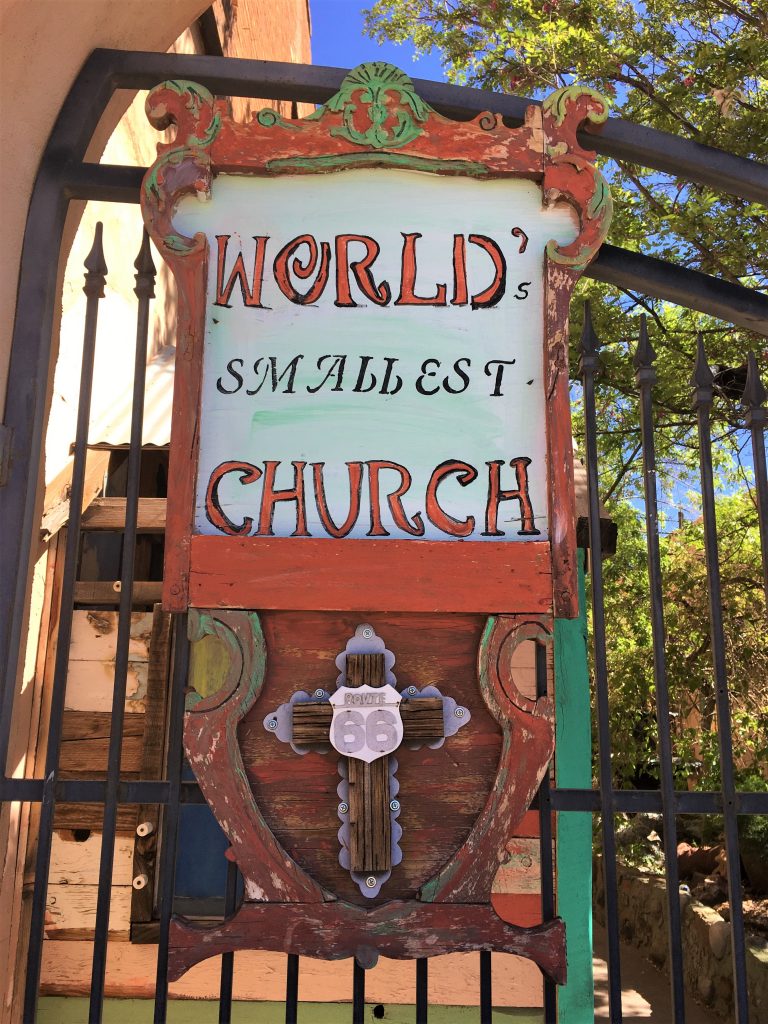
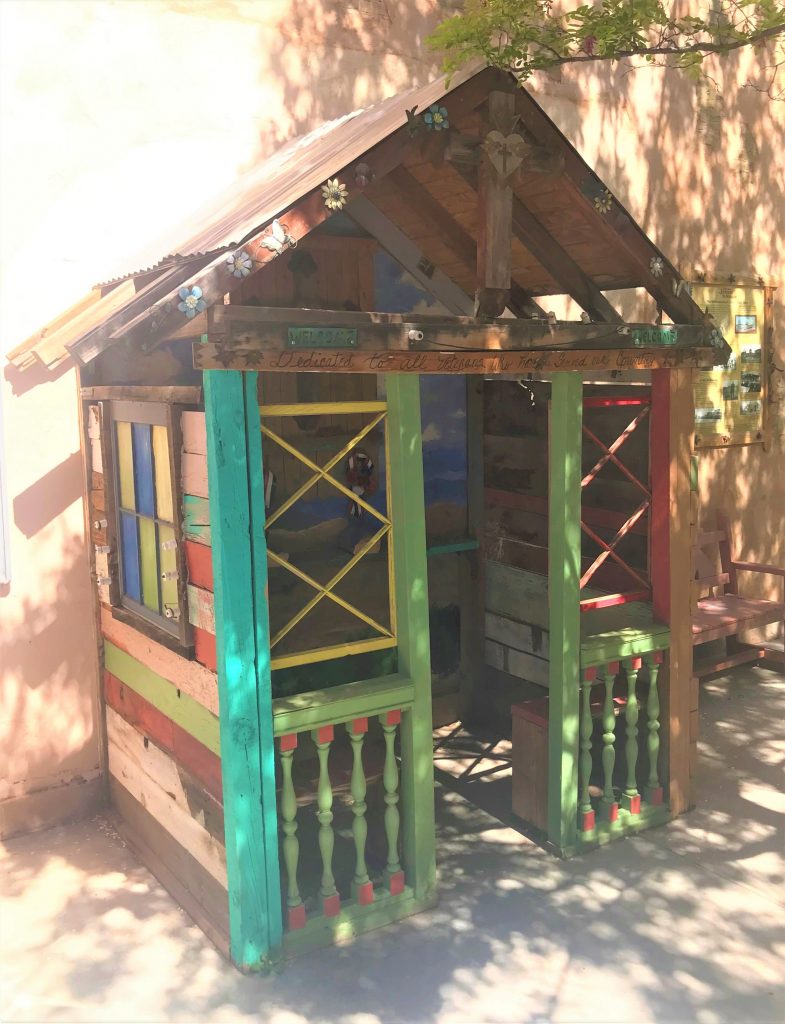
Above the door it says, “Dedicated to all veterans who have served our country”.
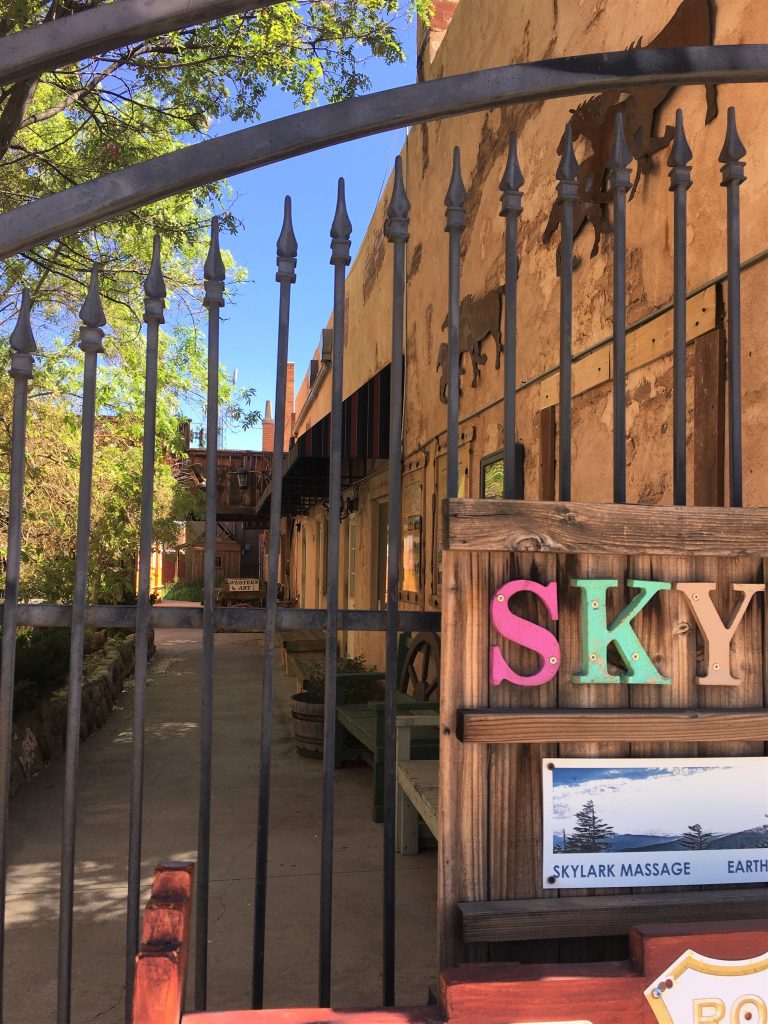
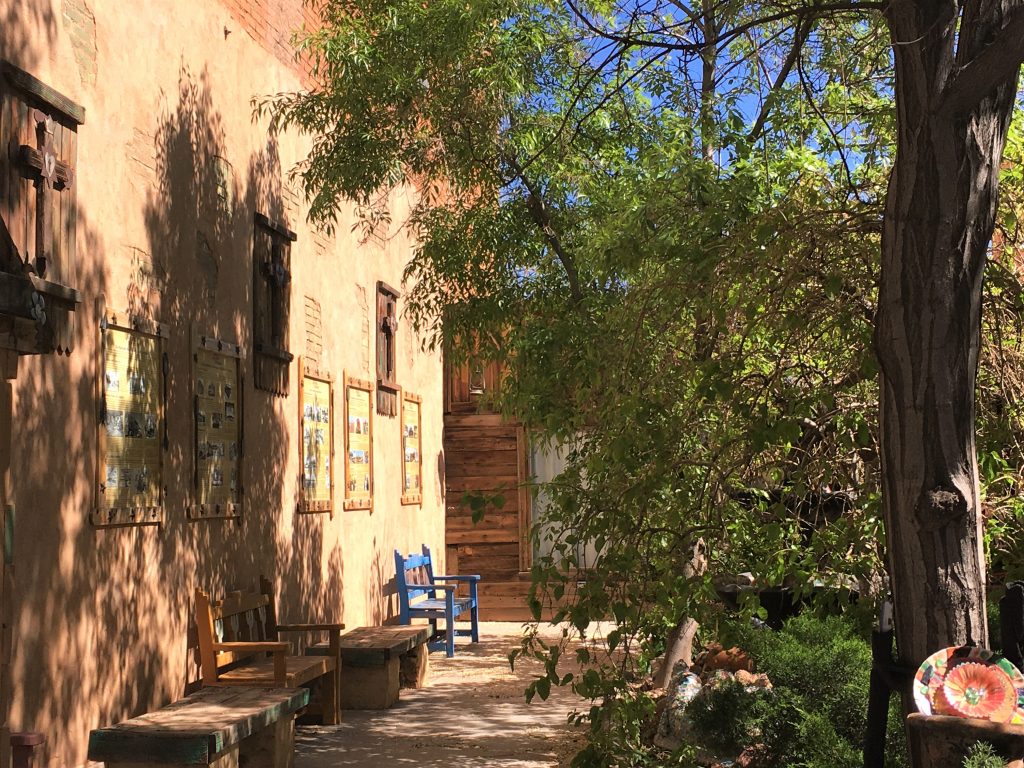
2. Standin’ On The Corner Park – – Many tourists come to Winslow purely to get themselves photographed beside the statue on the corner made famous in the Eagles song.
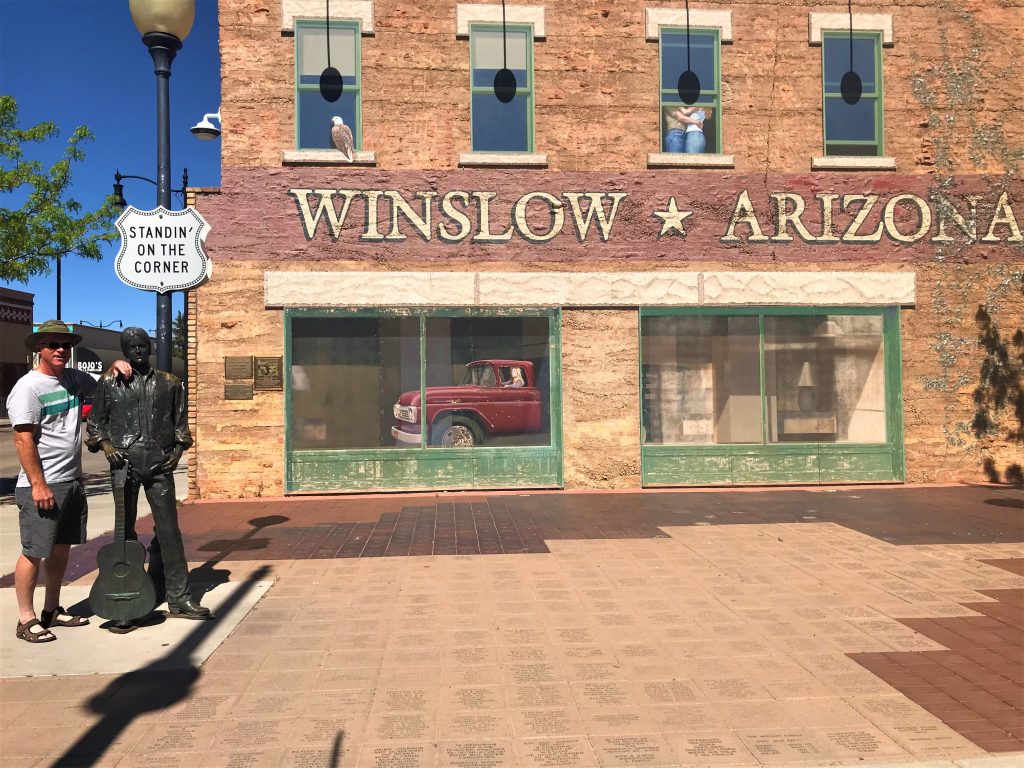
Here’s more information on the Park:
Is a passing mention in a 1970s rock song lyric cause for civic celebration? In Winslow it is. When the Eagles first decided to “Take it Easy” in a song (co-written by Glenn Frey and Jackson Browne), the reference to “standing on a corner in Winslow, Arizona” was just a catchy almost-rhyme.
But the song has endured on classic rock radio, a sleepytime anthem for aimless wandering.
During the heyday of tourism along America’s historic Route 66, Winslow was a well known spot among the arid Arizona expanse. So well known in fact that the band dads love, and everyone else loves to hate, the Eagles, mentioned the town in their classic rock staple, Take It Easy. Unfortunately things weren’t easy for very much longer in Winslow as the trans-national I-40 highway finally opened and their stretch of Route 66 was no longer the necessary thoroughfare it once was. Once the road closed, so did a number of businesses in the town, making the future look bleak.
Luckily a local group looking to reinvigorate the town remembered the reference in the Eagles song and had the idea to capitalize on it. Thus Standin’ On the Corner Park was born. Bringing the scene from the song to life. And in 1998 the town of Winslow put the finishing touches on their “Standin’ on the Corner” Park. The same year the song was inducted into the Hall of Fame. A bronze statue of a musician in 70’s garb stands on the corner with his instrument on his toe. Painted on the brick wall behind him is a tromp l’oeil mural of a woman in a pickup truck reflected in a storefront window. The entire effect is to bring the song’s easy breezy story to life.
The plan worked and Standin’ On the Corner Park is now a popular roadside attraction along the now historic Route 66 road, bringing new tourism to the area and allowing a number of local businesses to reopen. Winslow can once again, take it easy.
Winslow runs an annual Standin’ on the Corner Festival at the end of September featuring country rock and Eagles tribute bands, such as the band Hotel California. The town now estimates that 100,000 people stop by every year to stand on its corner. Jackson Browne finally made a pilgrimage here in 2013. We’re not sure if Glenn Frey ever did, although a statue of him was added to the plaza in 2016. He’s the one with the long hair.
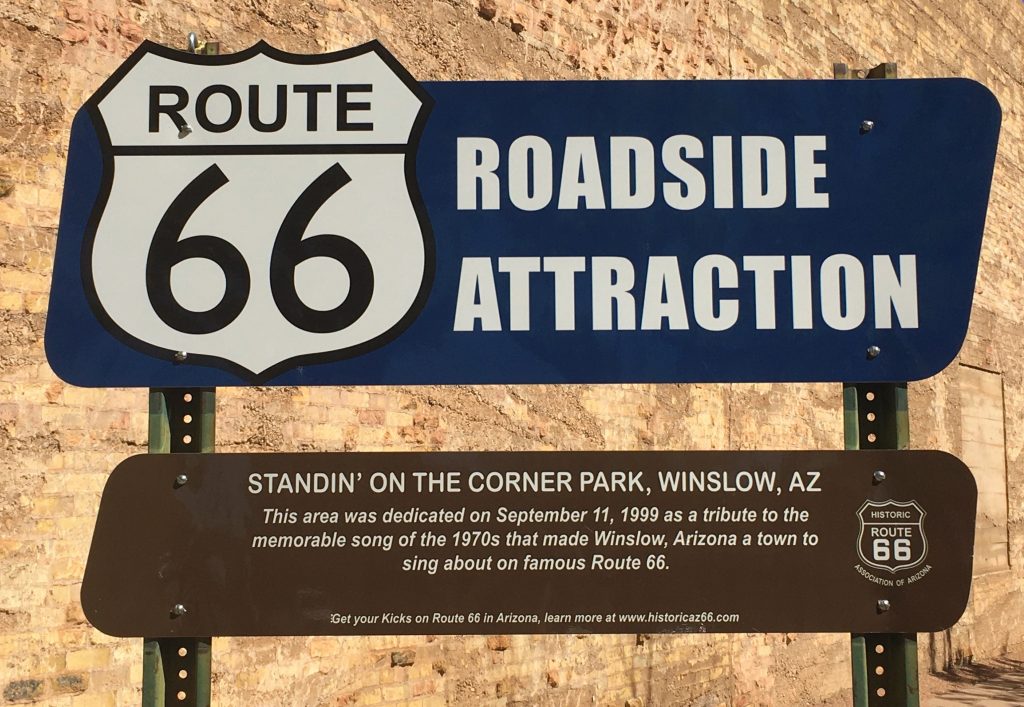
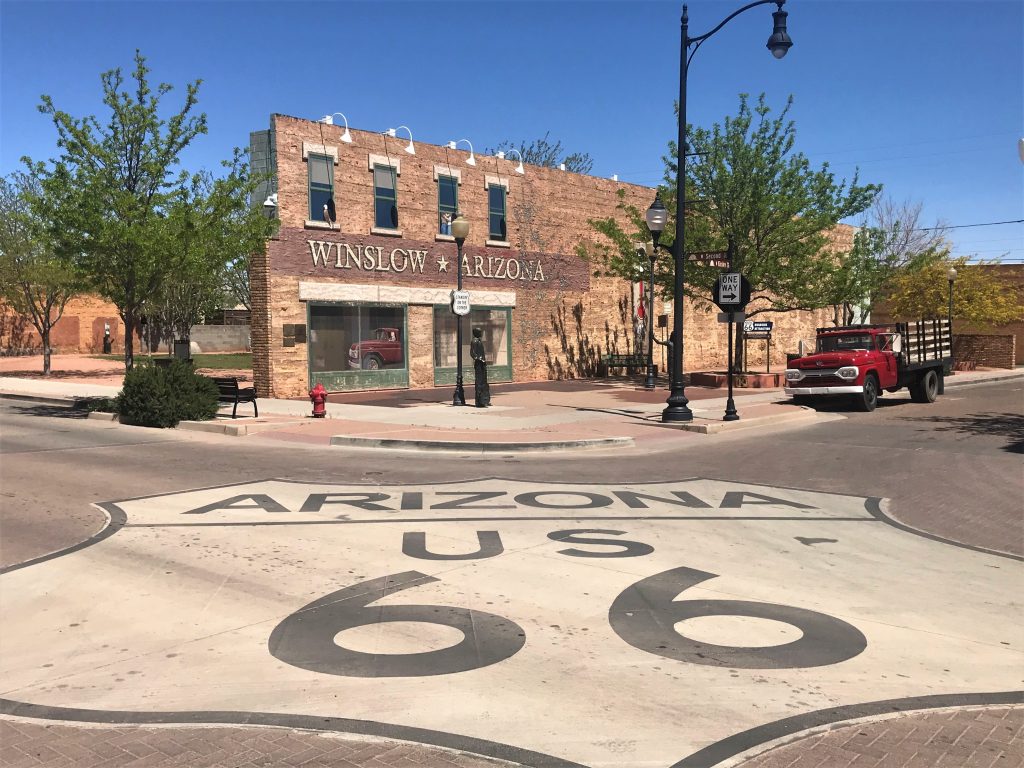
We thought they shoulda put a female mannequin in it. : )
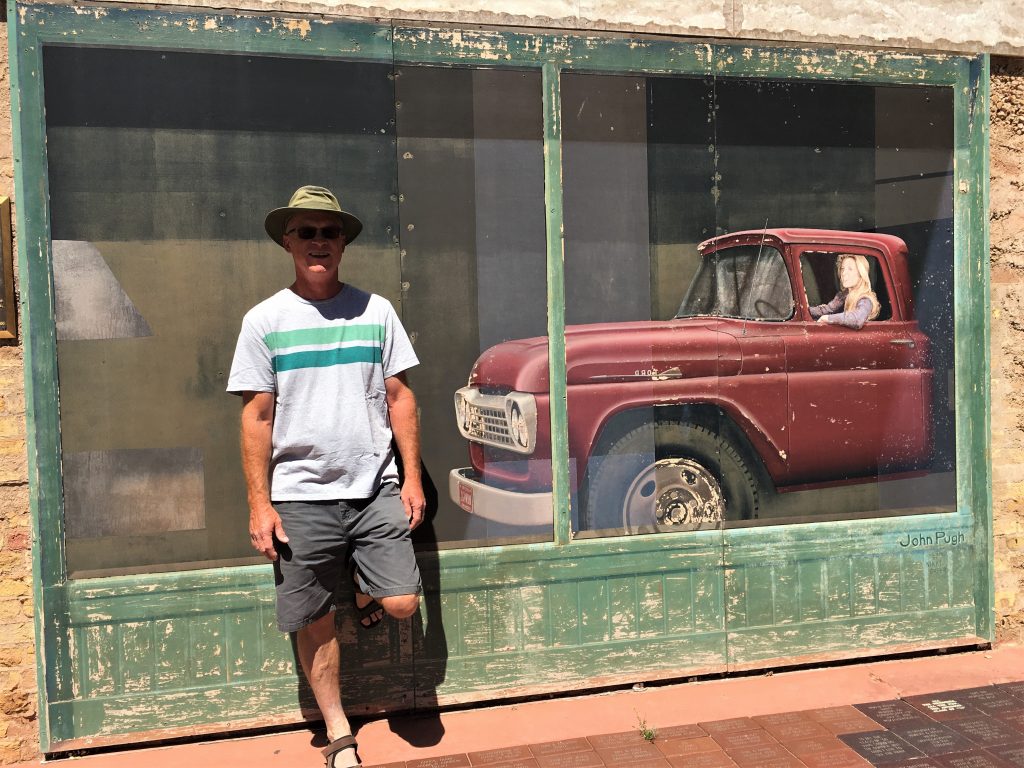
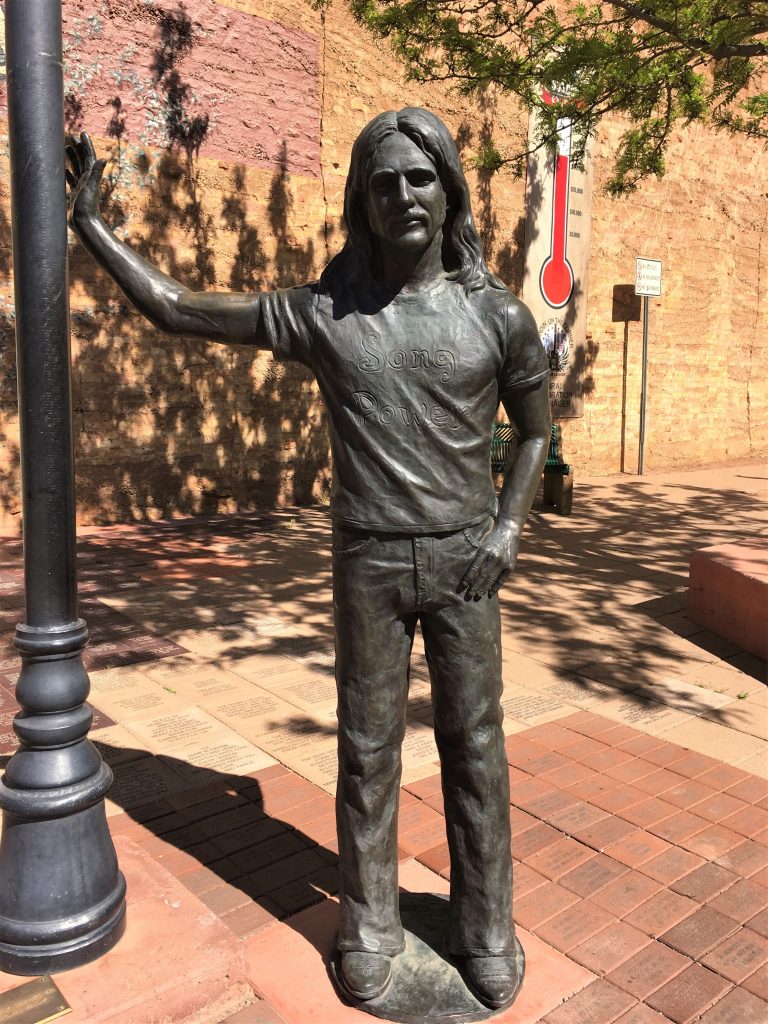
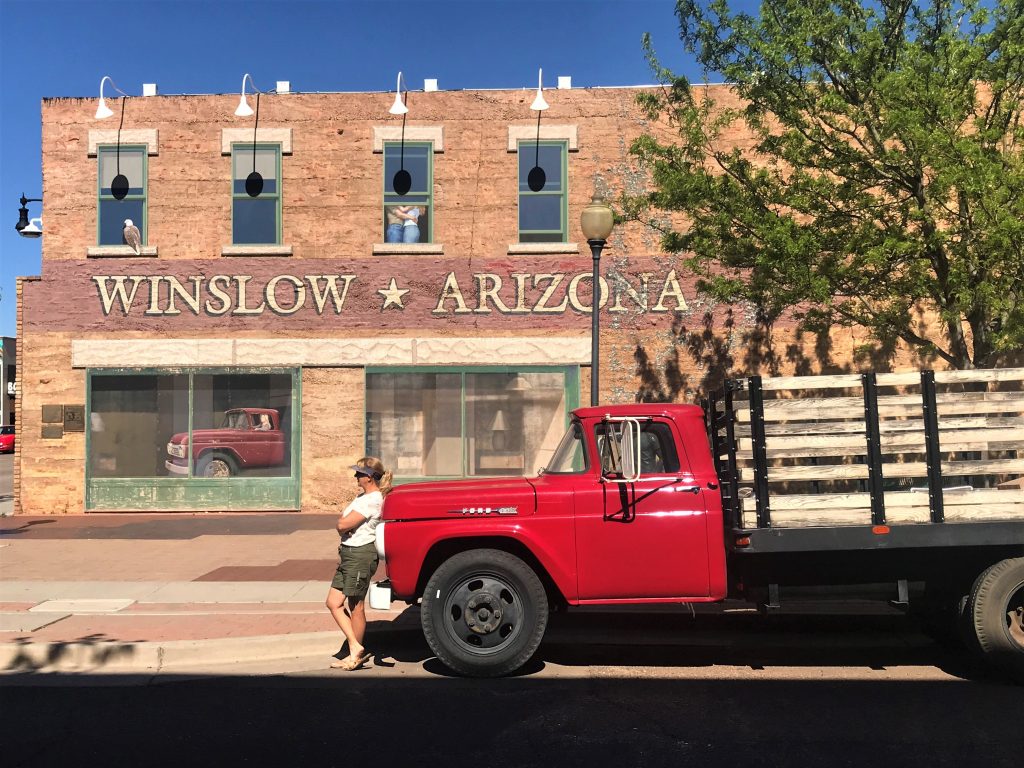
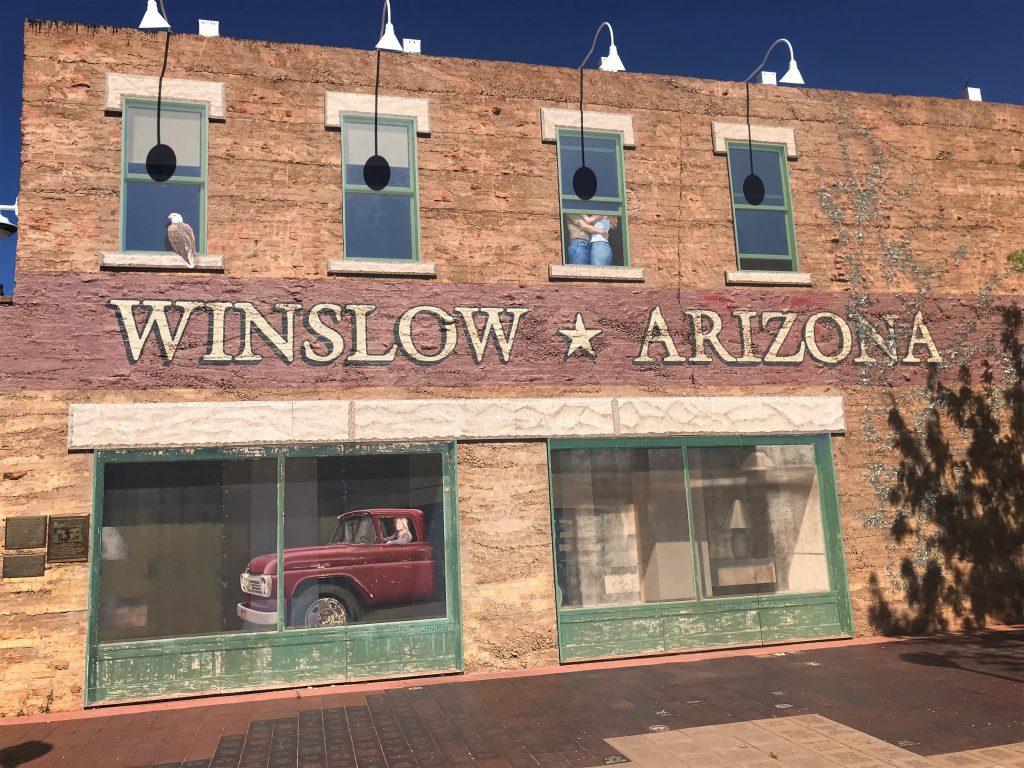
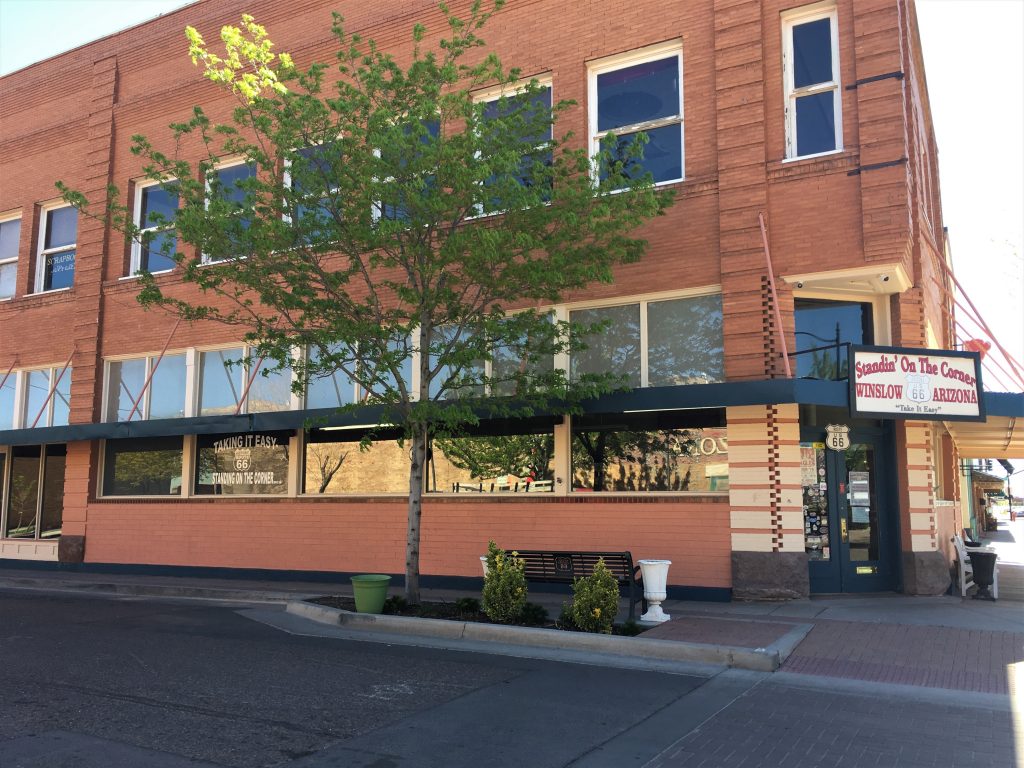
They had two really great signs on the door . . .
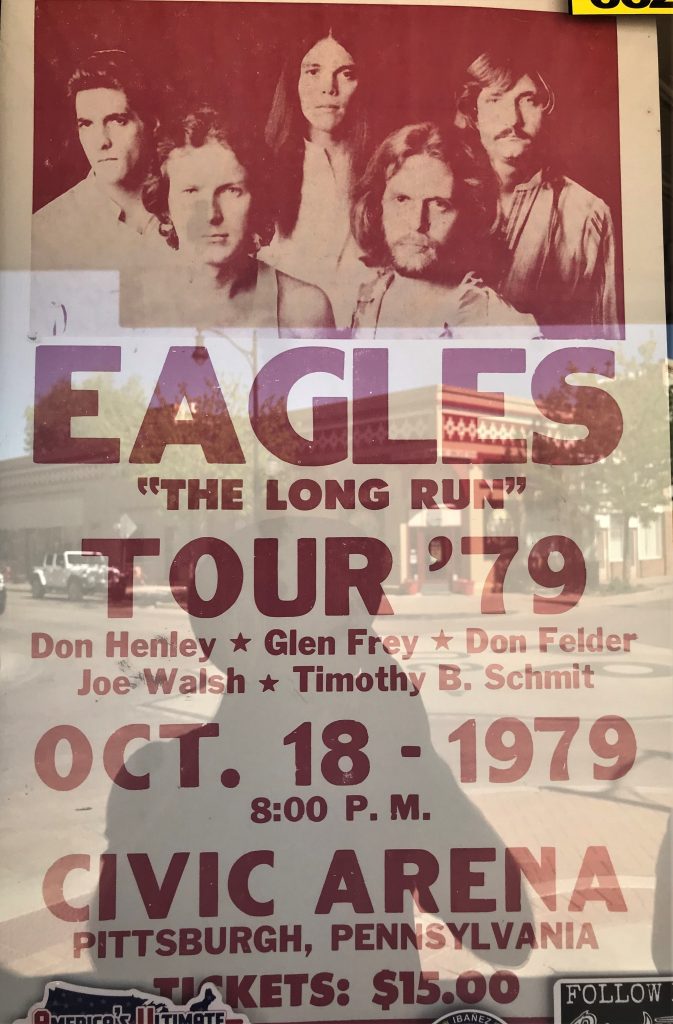
Obviously back before they became famous. : )
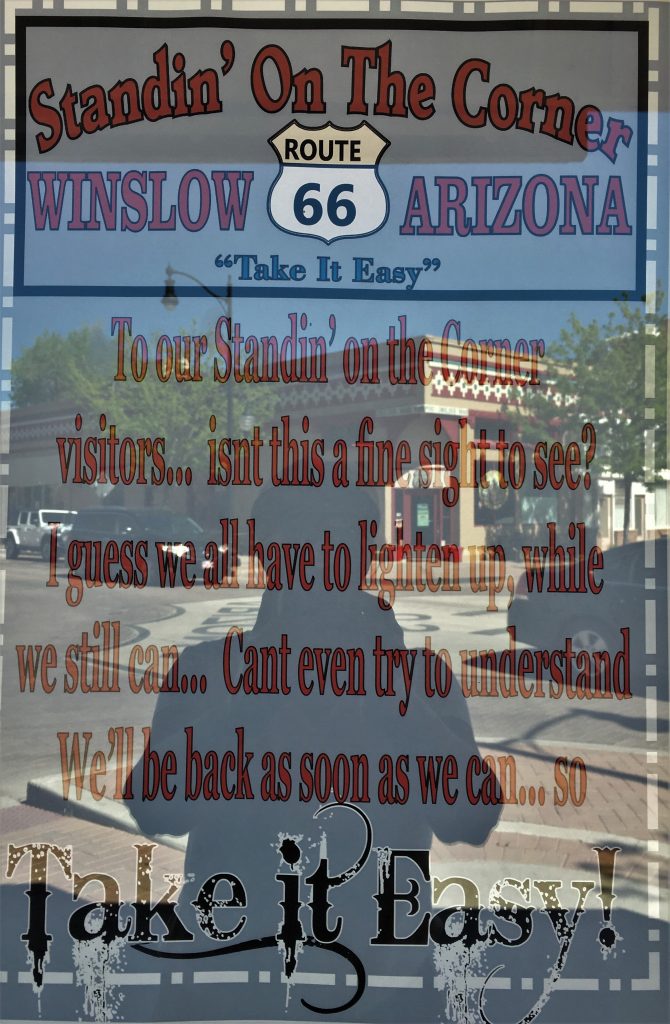
Love it!
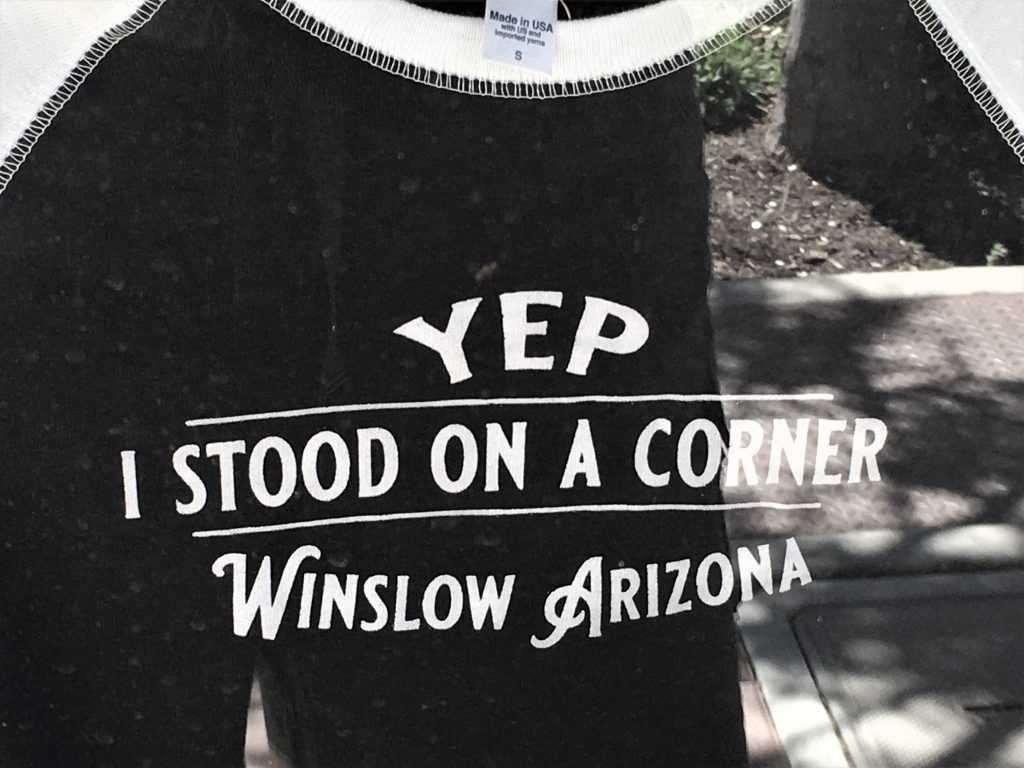
Had they been open, I might’ve bought one!
We saw the following as we walked around town a bit . . .
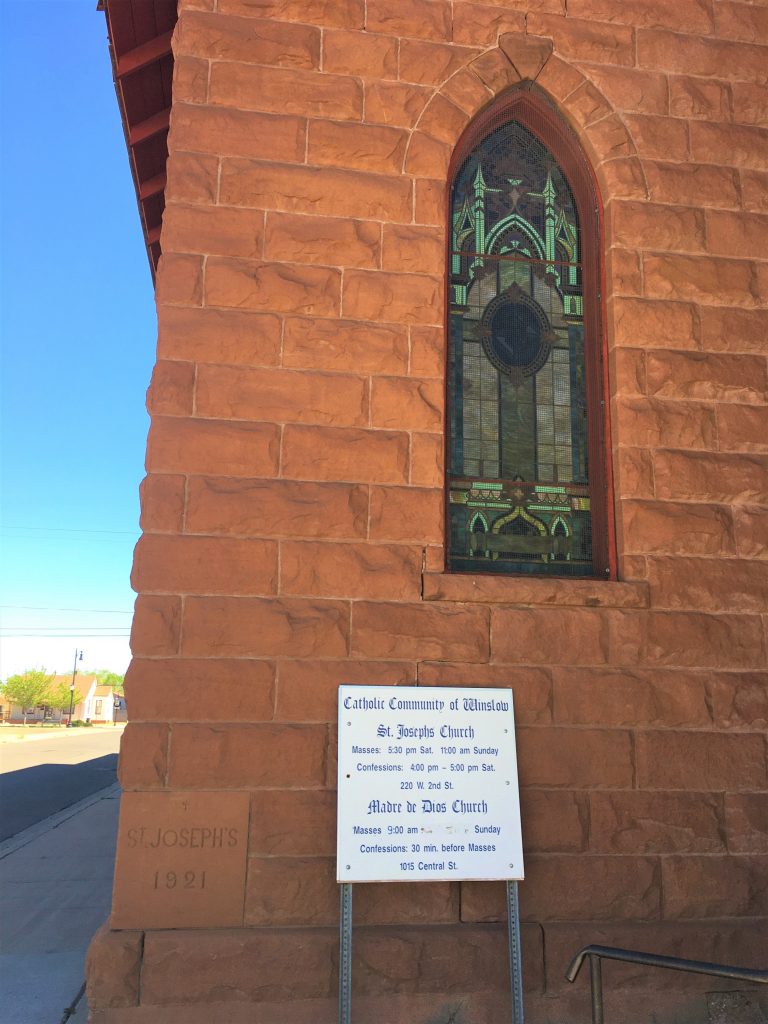
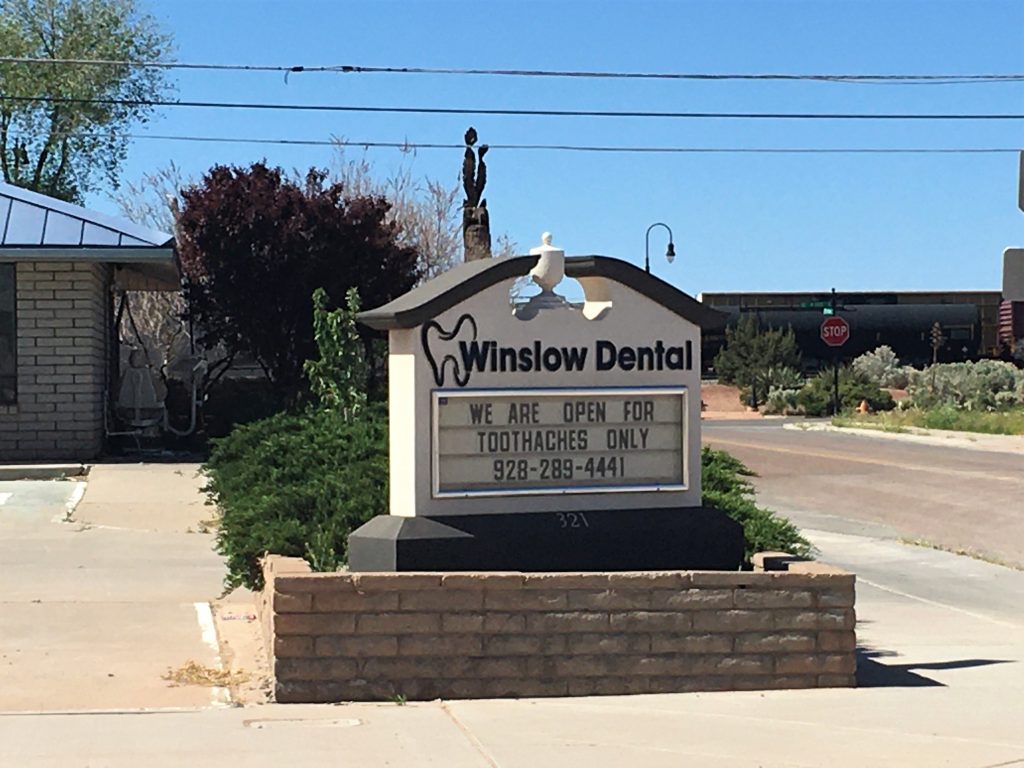
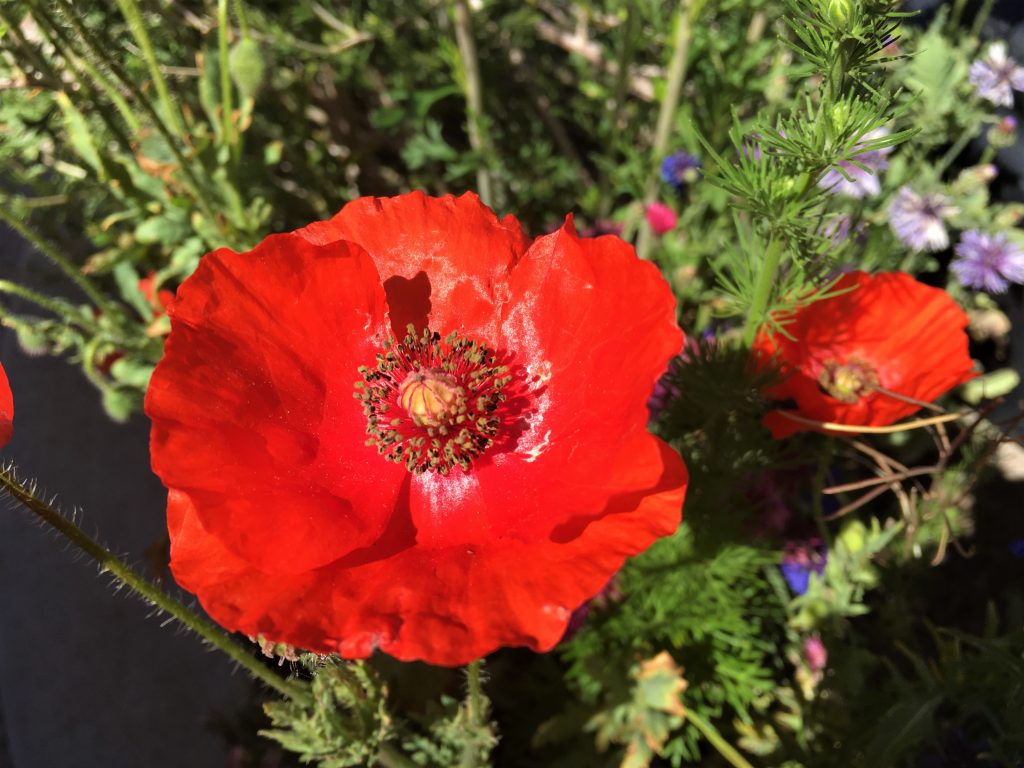
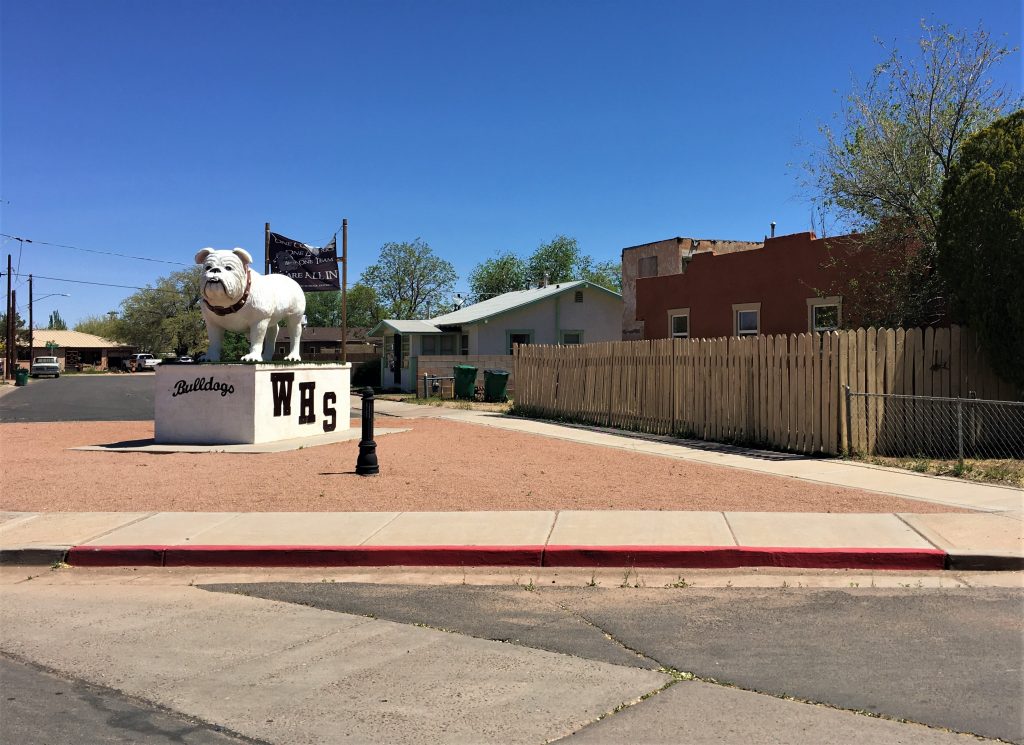
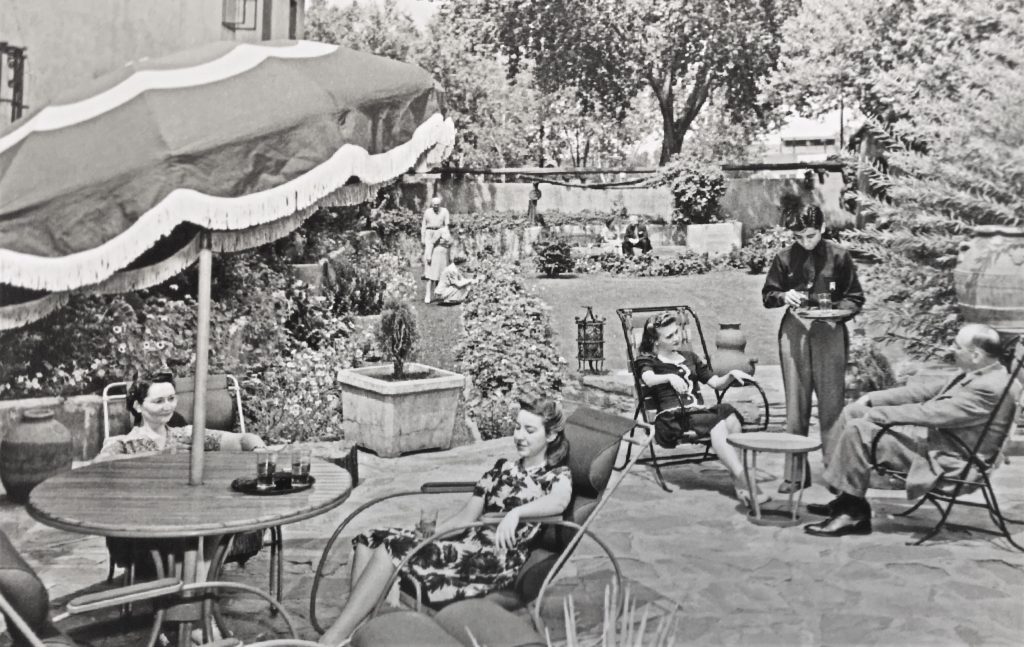
They’ve made a calendar about the hotel.
This one said:



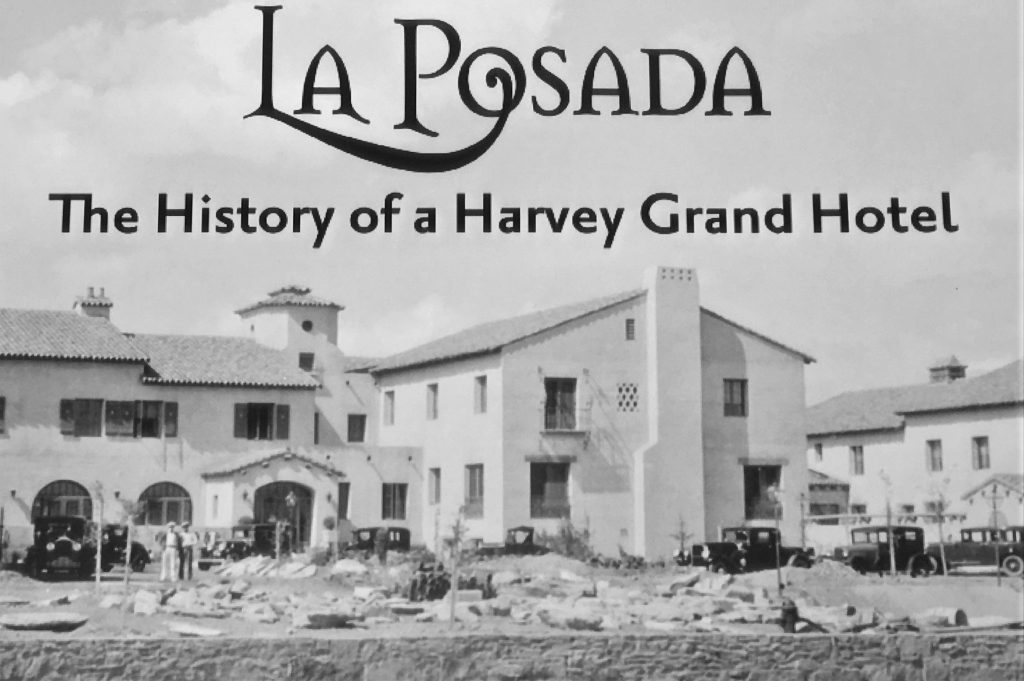
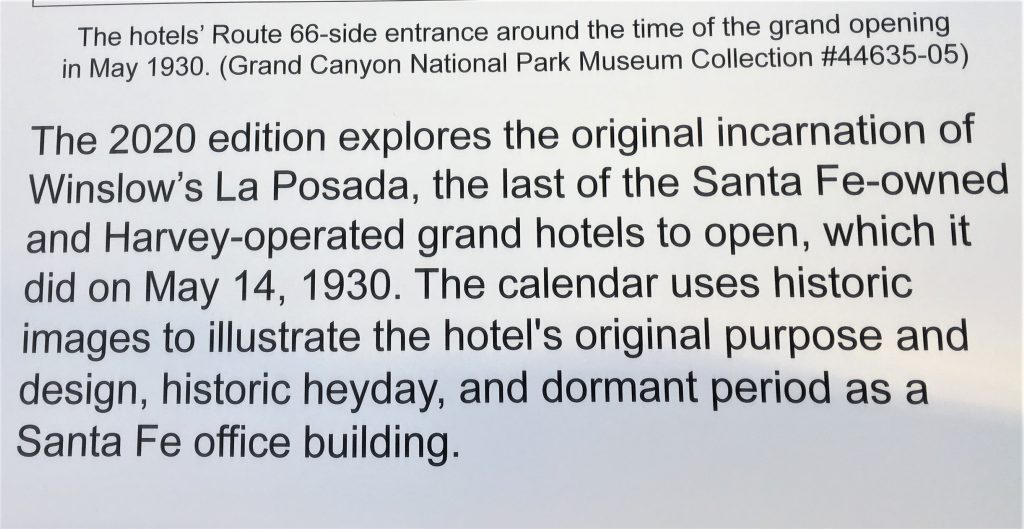


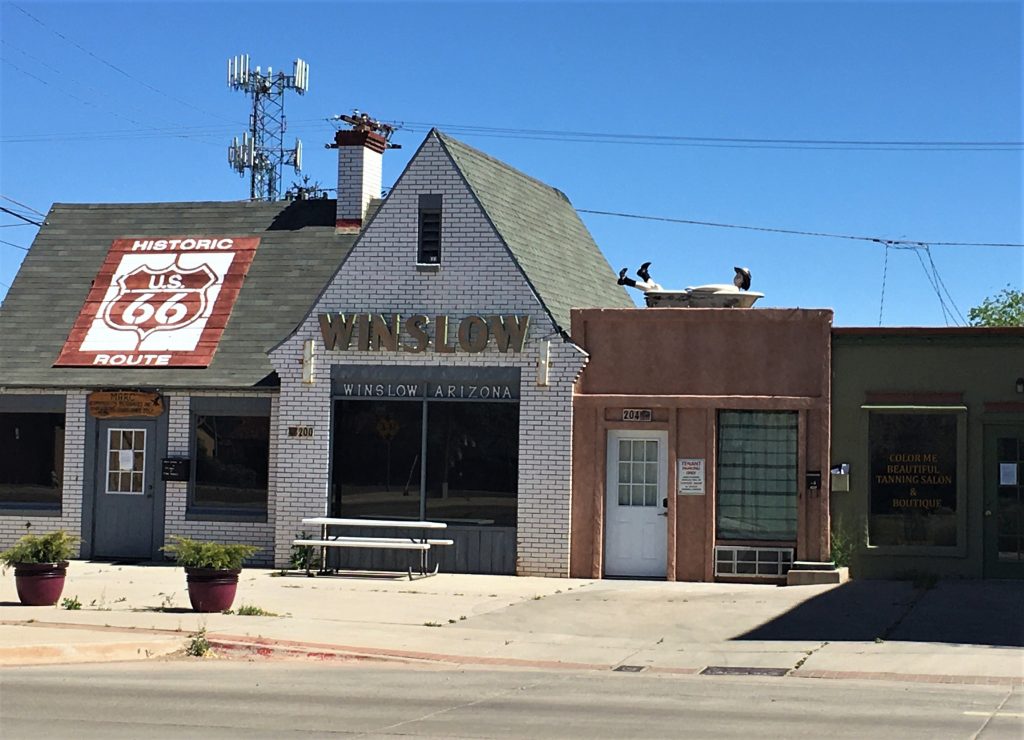
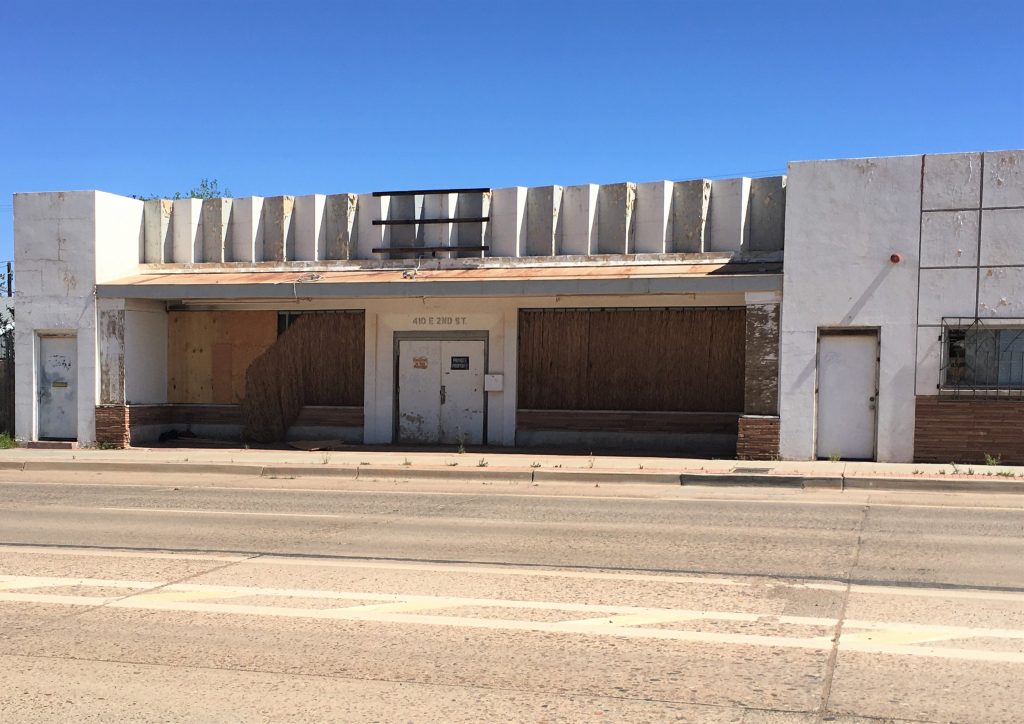
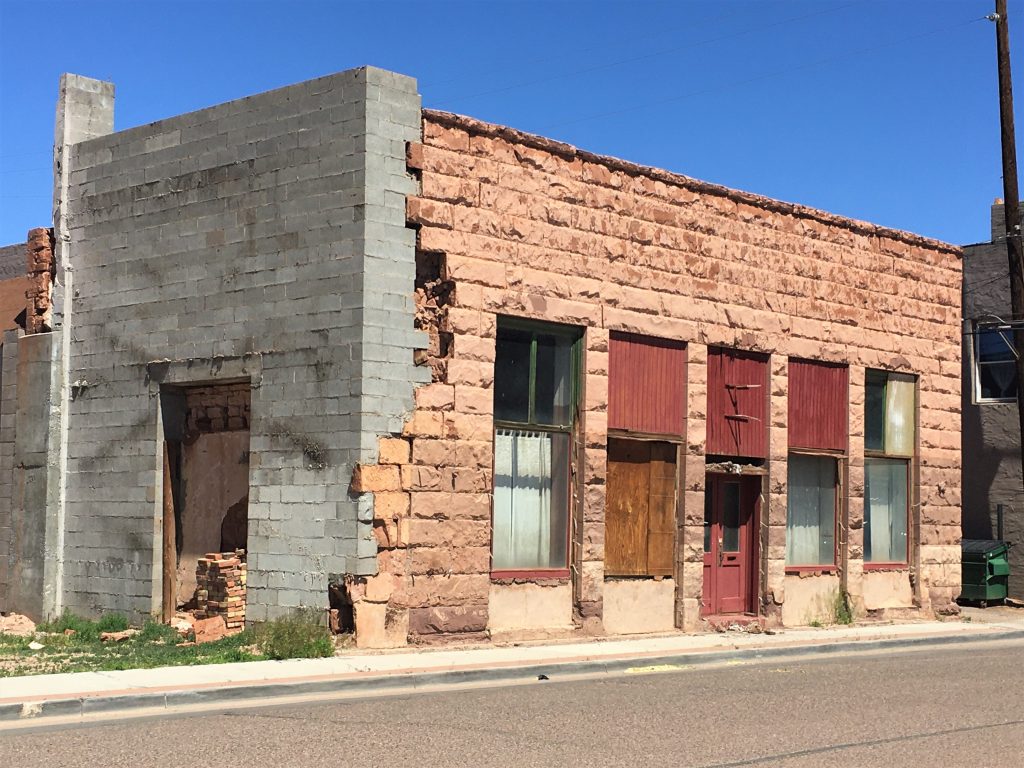
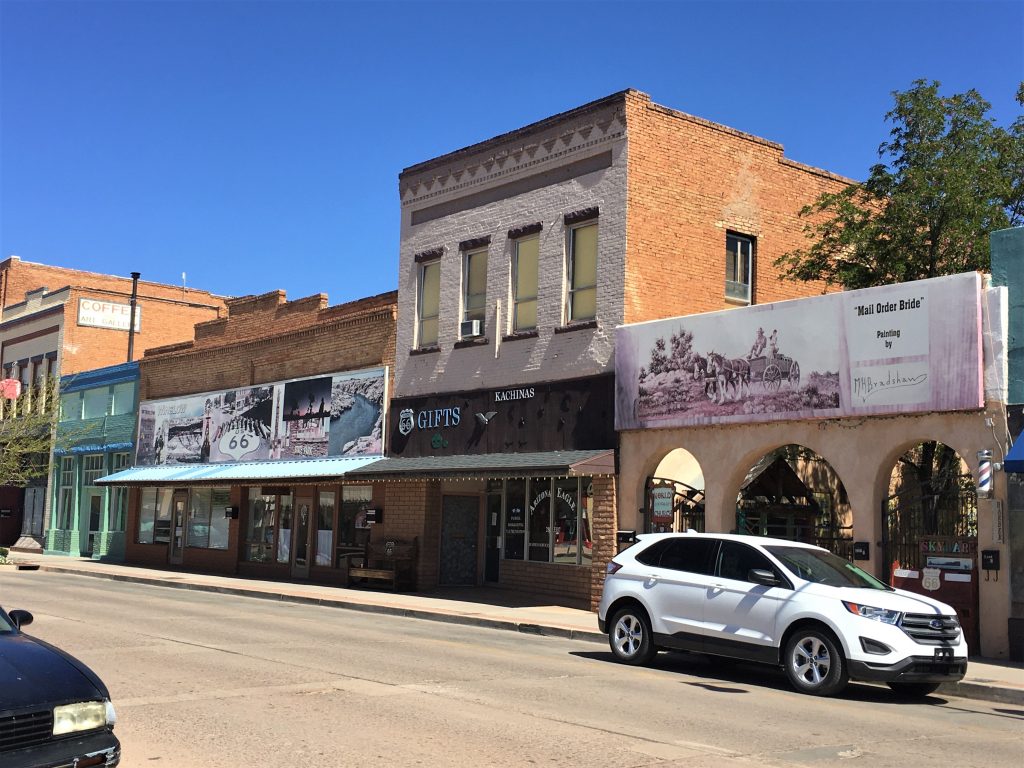
3. La Posada Historic Hotel – – Unfortunately, due to COVID-19, we were unable to visit this historic hotel. You aren’t even permitted on the property. There are vehicles parked across the two drives so as to make their statement very clear. No one. Period. We had to take pictures through or over the bushes alongside the road.
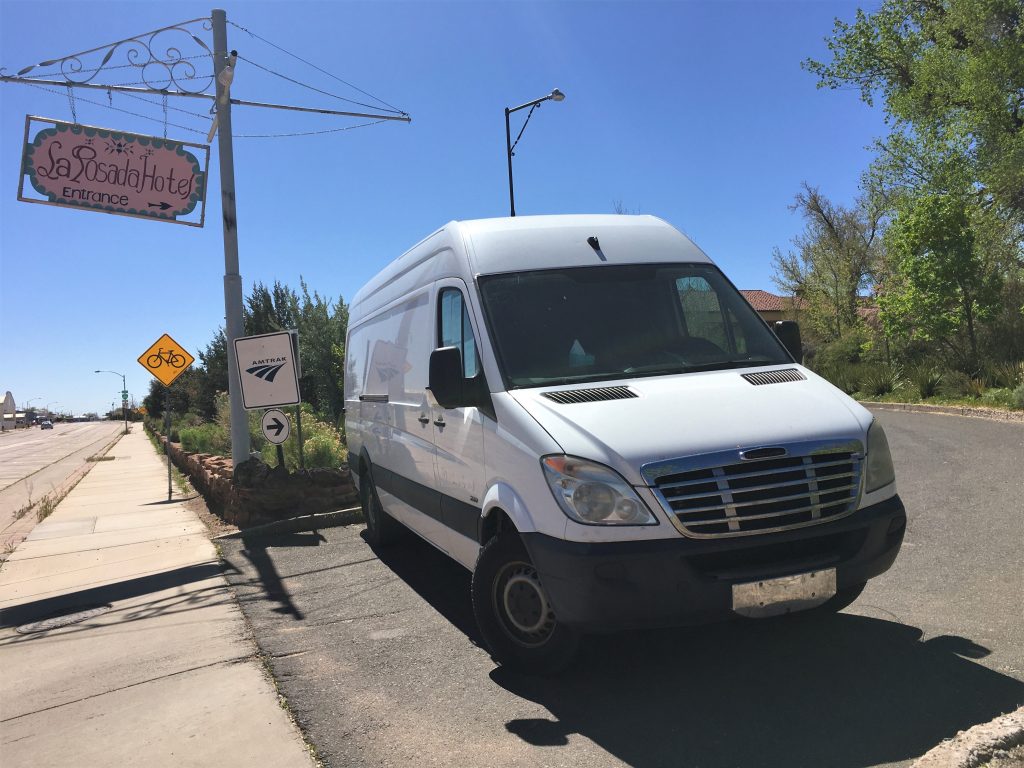
I think he just didn’t want to have to bail me out of jail. . .

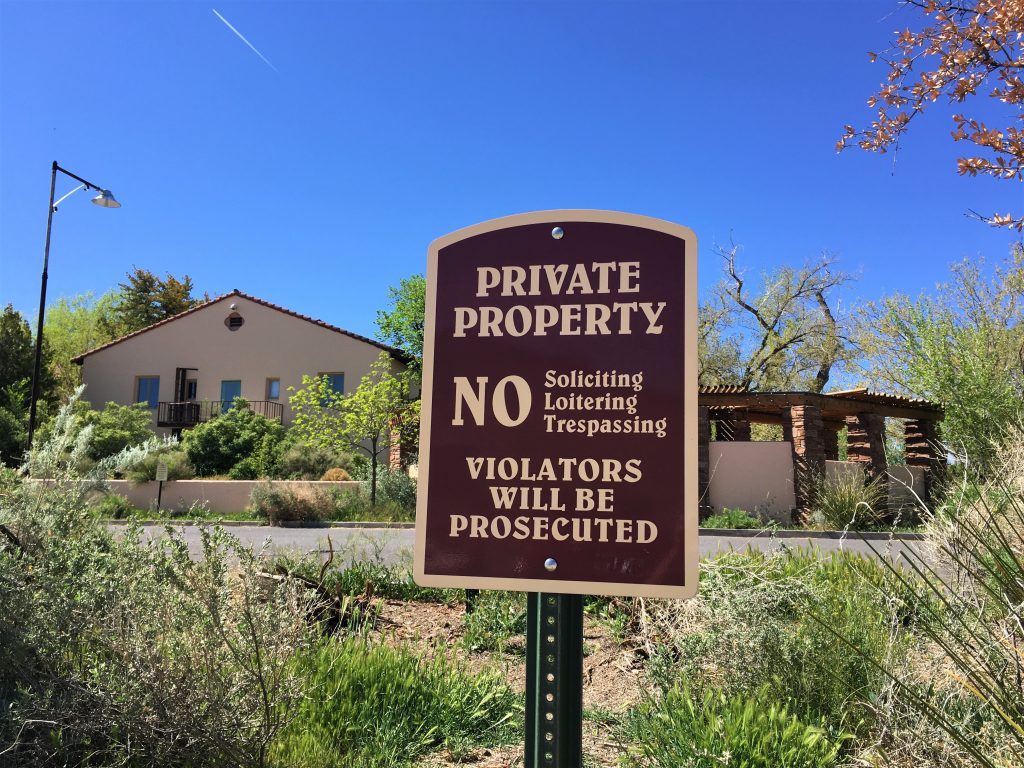
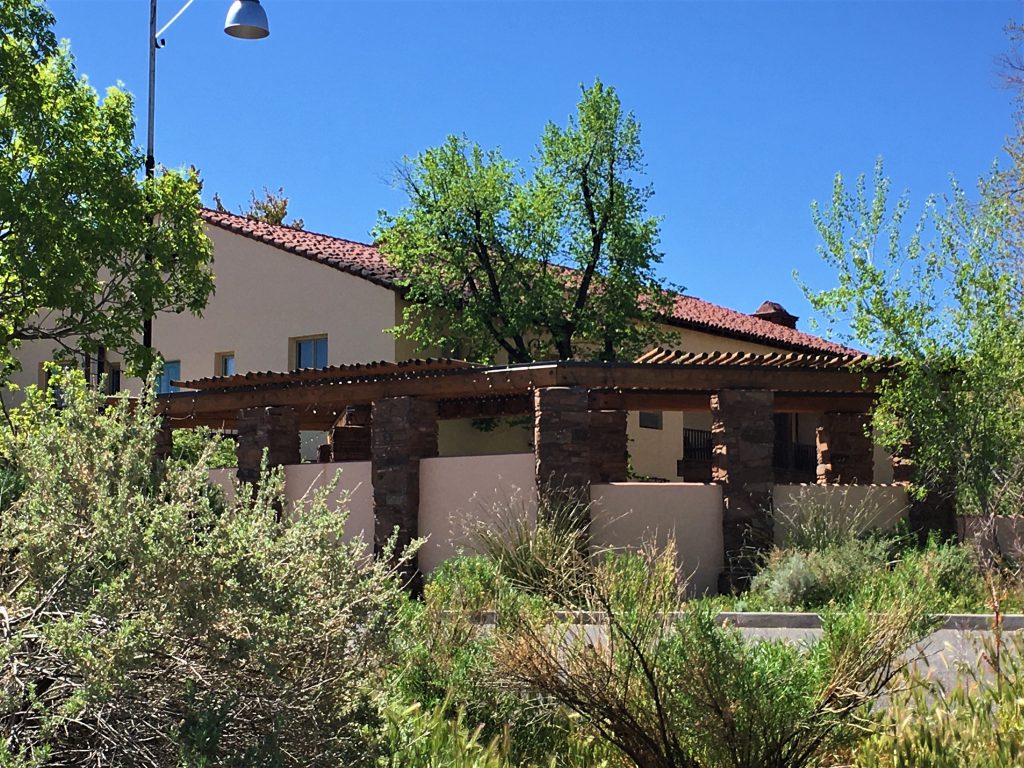
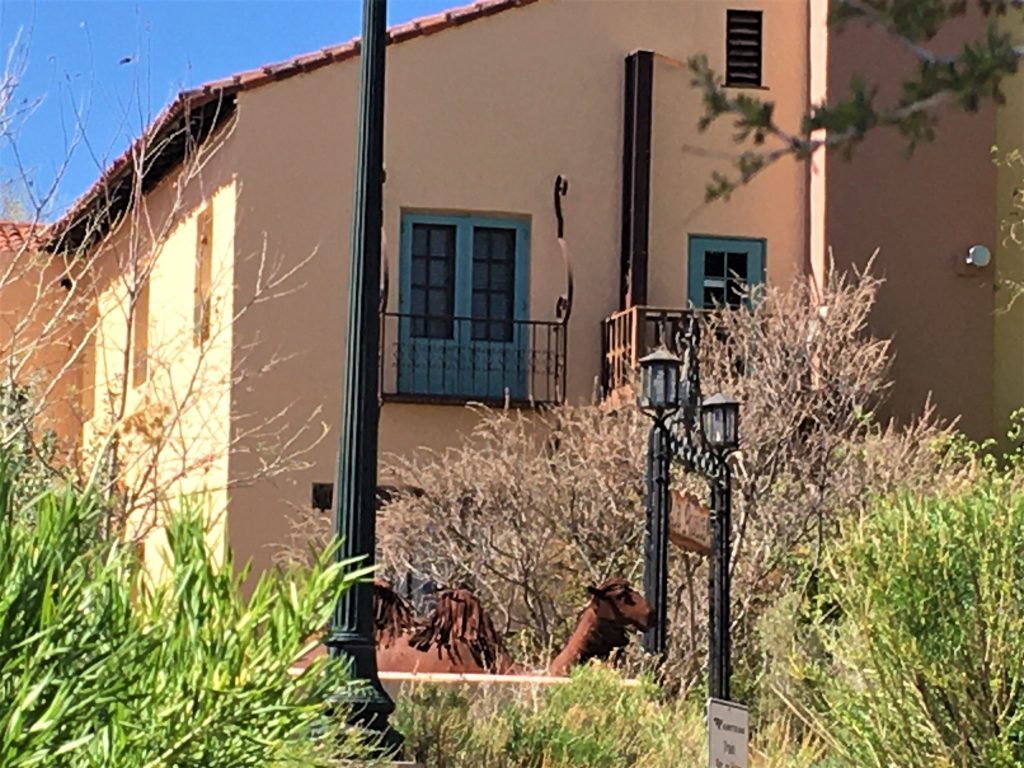
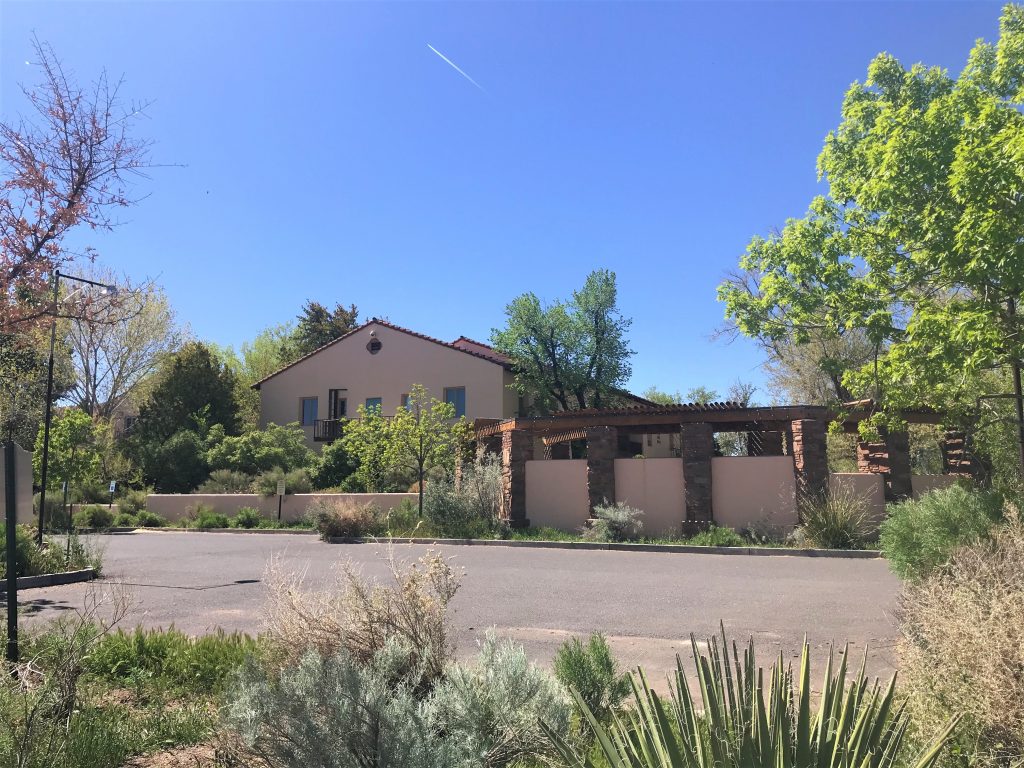
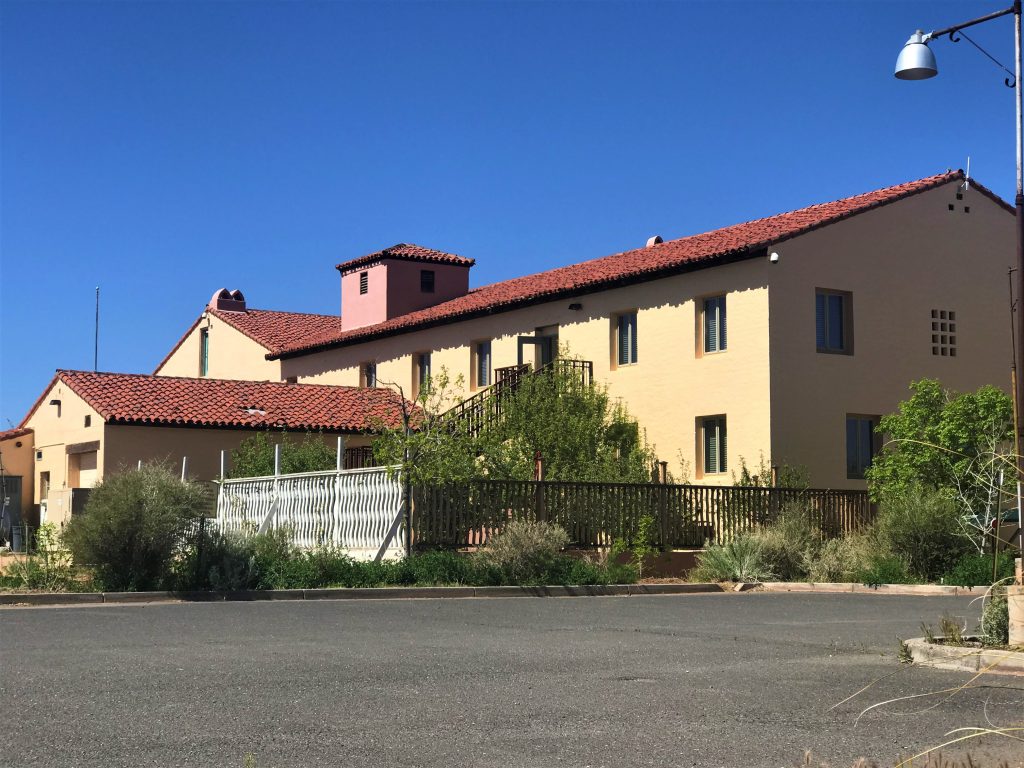
But it seems to have a grand history – especially if you want to indulge in the architect’s fantasy. 😊 If you want the full, novella history, you’ll have to visit the Hotel’s website. It’s pretty interesting, but I’m glad I ran across a Reader’s Digest condensed version. . . .
In order to design the La Posada complex, architect Mary Colter (commissioned by the Santa Fe Railway in 1929) made up a century and a half of history for the site. She imagined La Posada as a Spanish rancho of the early 1800s. Here lived a wealthy Spanish don. When the don and his family fell on hard times, the hacienda was renovated into a hotel with furnishings and grounds intact. In such an inaccessible location, Colter reasoned, materials would have been local, and the labor native. The complex would have been changed and added onto through generations. The hotel and gardens are now regarded as a historic monument.
There had been talk of demolishing it, but twenty years ago it was finally refurbished. You are welcome to visit even if you are not staying in the hotel where some interesting art is on display.
Each room is different, with several of them having the handmade Ponderosa pine beds from decades ago as well as bathrooms with mosaic tiles. If you are lucky, you will get a room with a whirlpool tub.
Famous people have stayed at this hotel, including the likes of Albert Einstein, Amelia Earhart, President FDR, Betty Grable and John Wayne, all of whom visited in the 1930s.
For 38 years, Colter served as chief architect and decorator for the Fred Harvey Company; the same company that employed the infamous “Harvey Girls” as waitresses and hospitality agents from the 1880s – 1960s. Colter completed 21 landmark hotels, commercial lodges, and public spaces – including many of the iconic buildings at the Grand Canyon. And she wasn’t limited to buildings. Colter was also known to design china and flatware for the Santa Fe. (Harvey and the Santa Fe worked closely together)


4. First Street Pathway Park – – In addition to the Standin’ on the Corner Park, Winslow has a Pathway Park that runs alongside the railway. This is the same railway that runs at least 25-30 very lengthy trains every day we’ve been here. There was supposedly signage about the history of rail along the path, but all we saw were the nods to the ‘Berma Shave’ signs that used to line Rt 66 back in the day. However, we did see a few train cars, a windmill, a totem pole and some guys “working on the railroad, all the live-long day”.
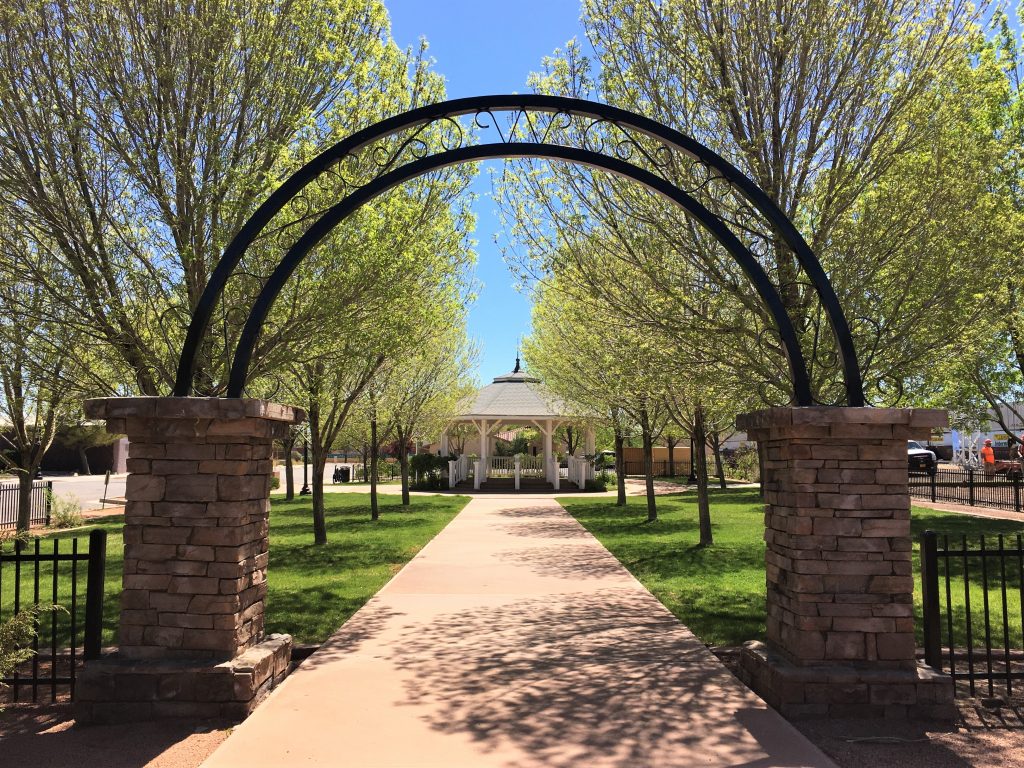


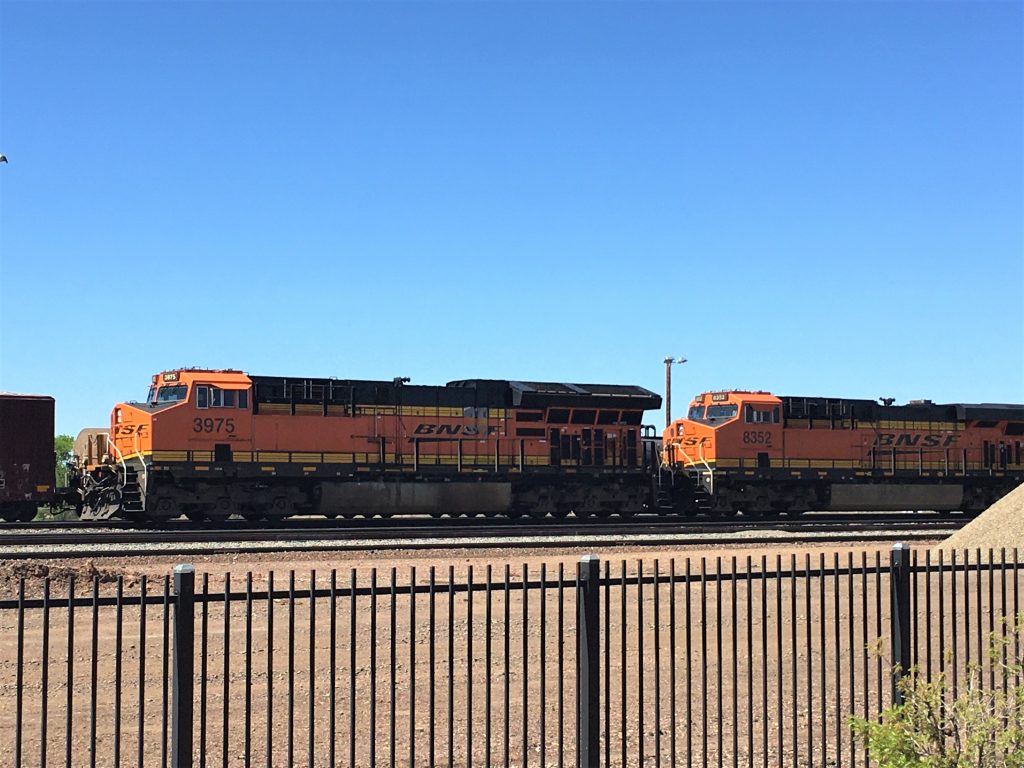
It was soooo quiet! We didn’t even have to raise our voices to talk! What a surprise!
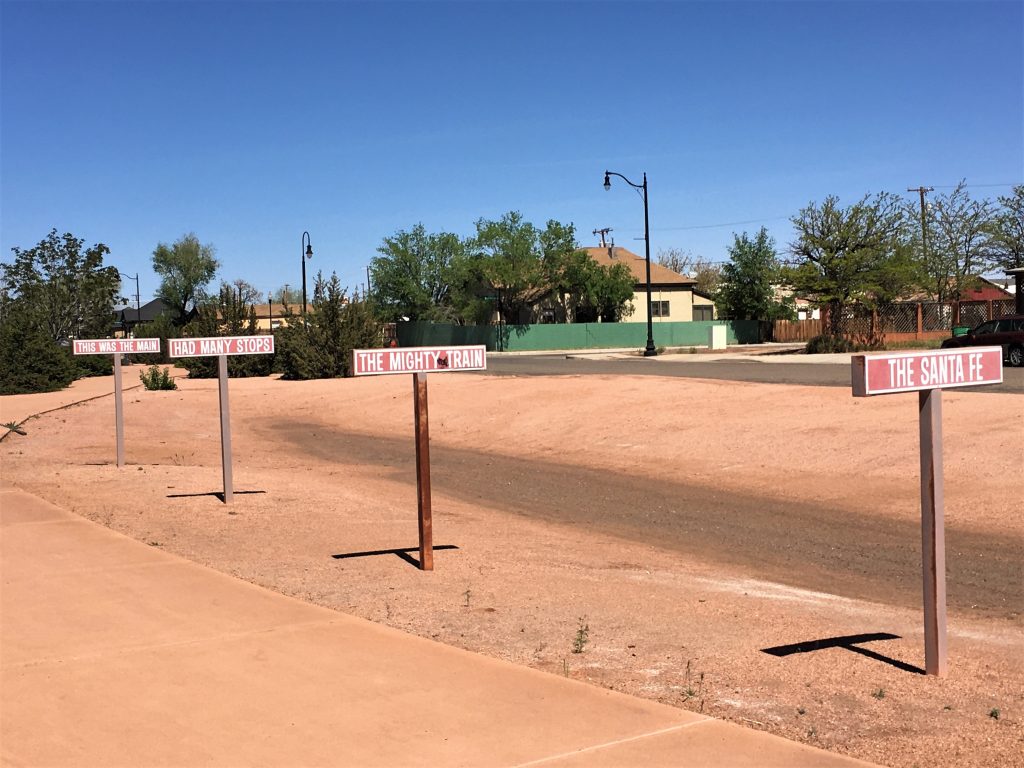
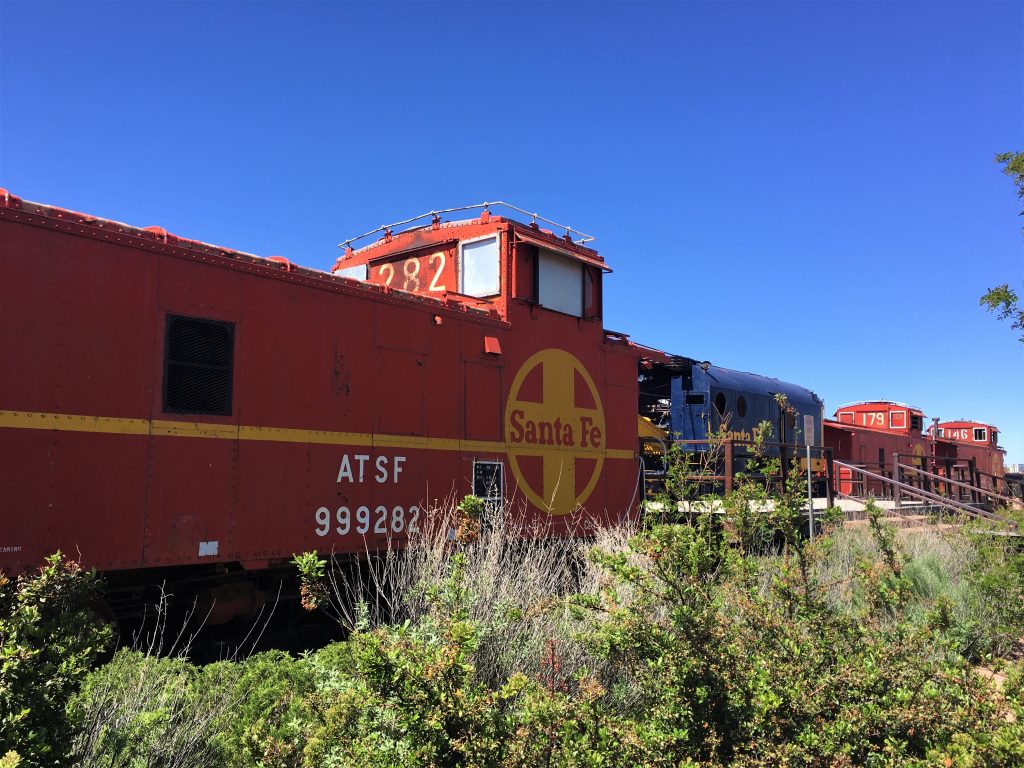
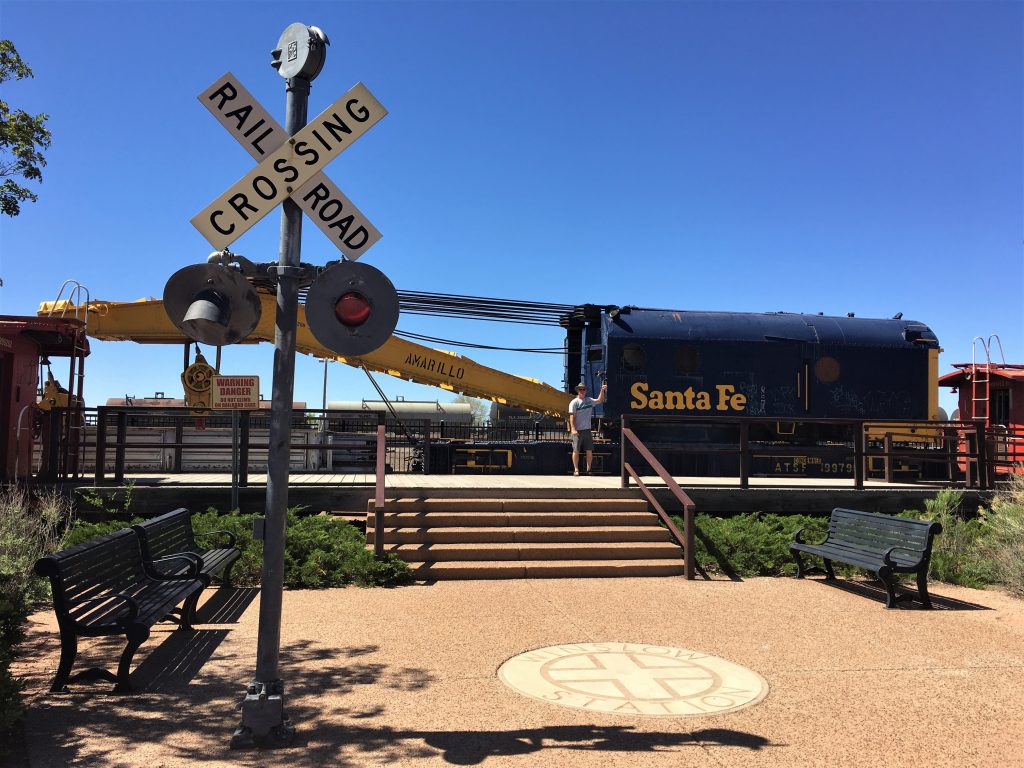
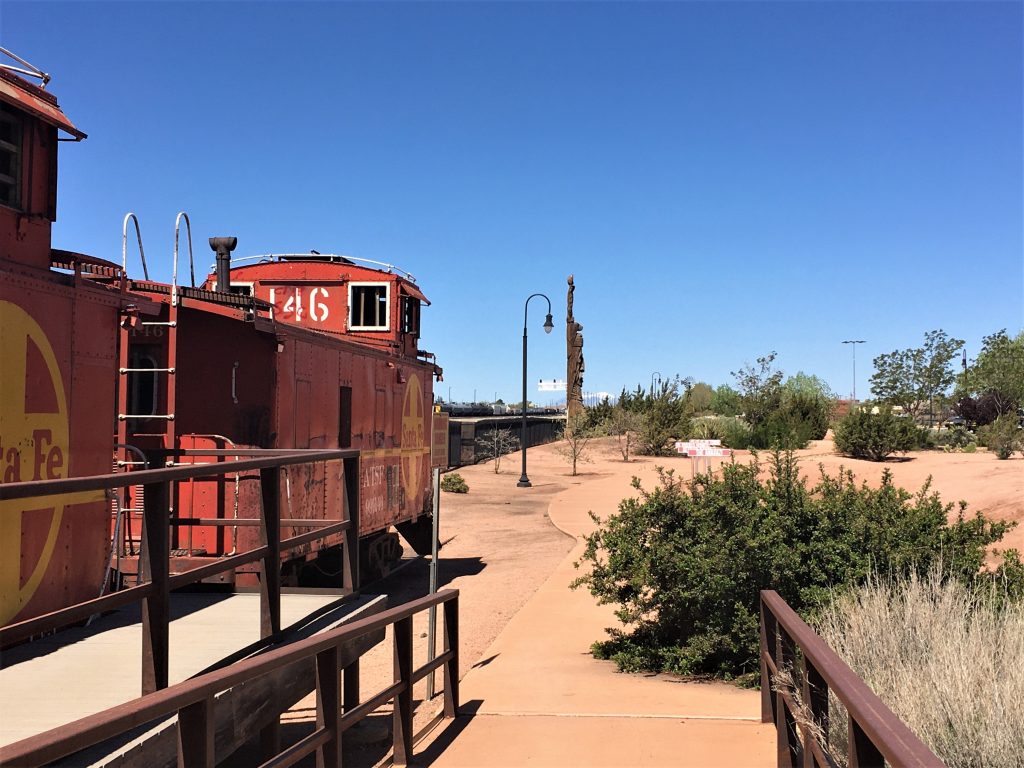
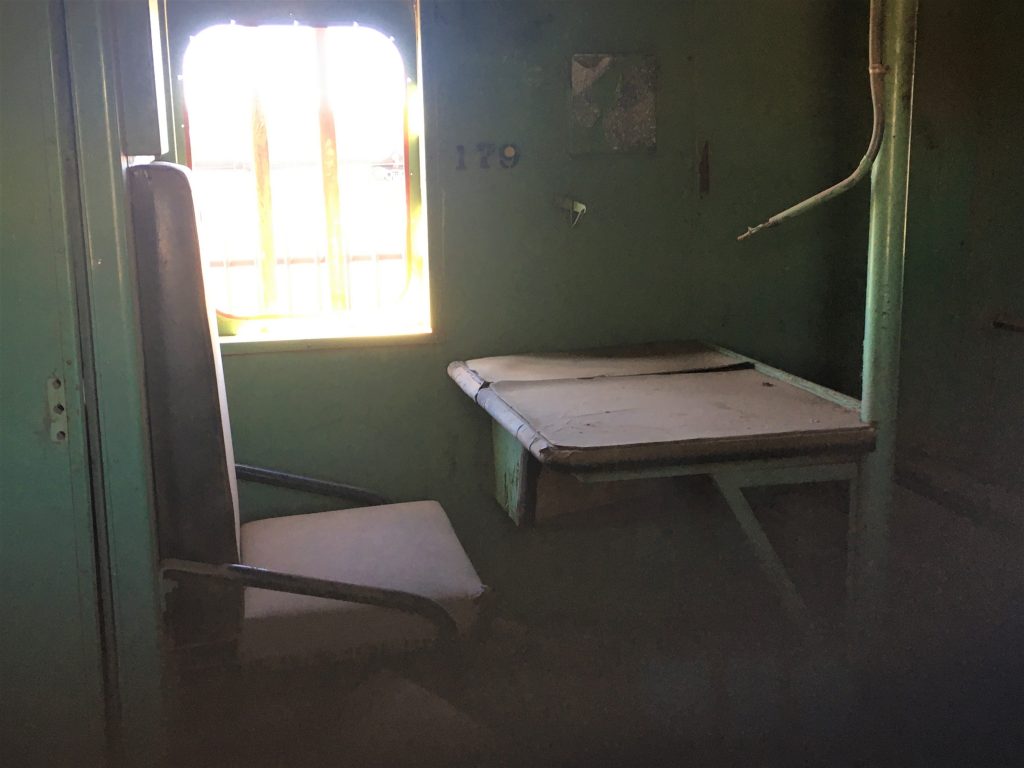
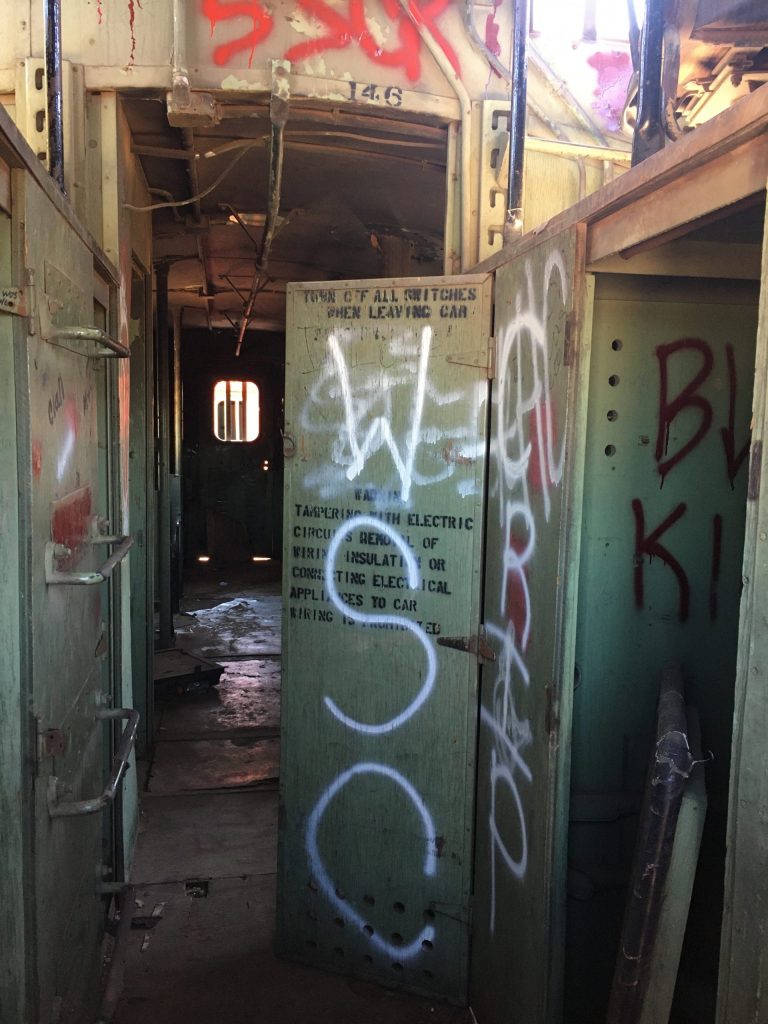
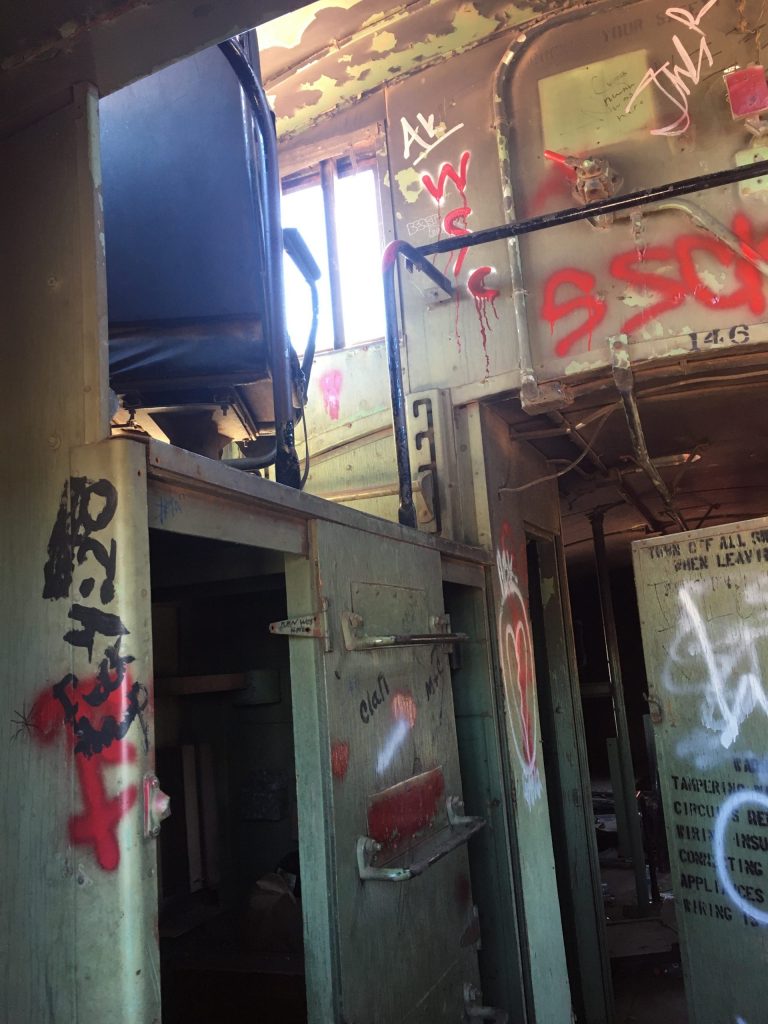
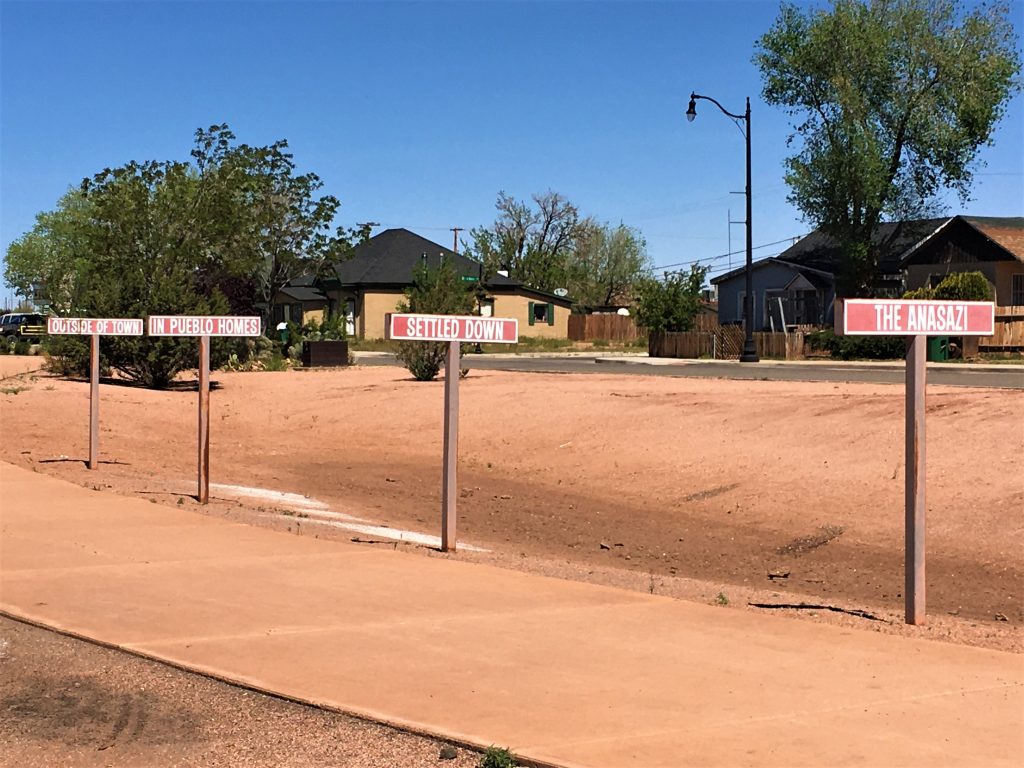
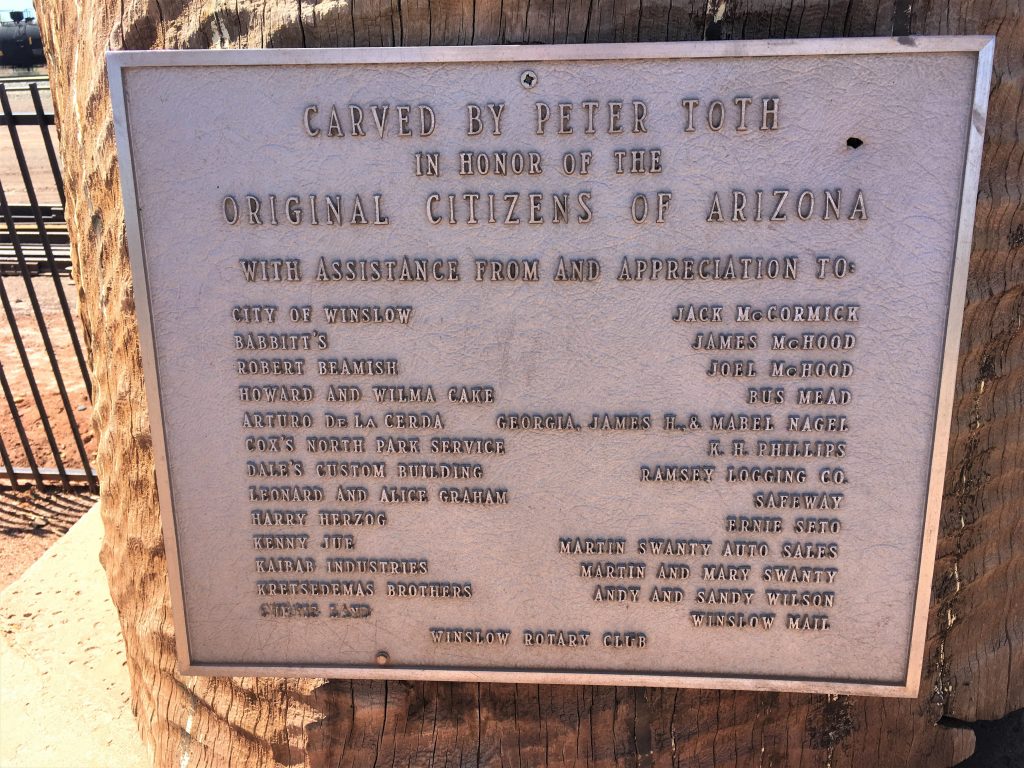
He chose Winslow for Arizona.
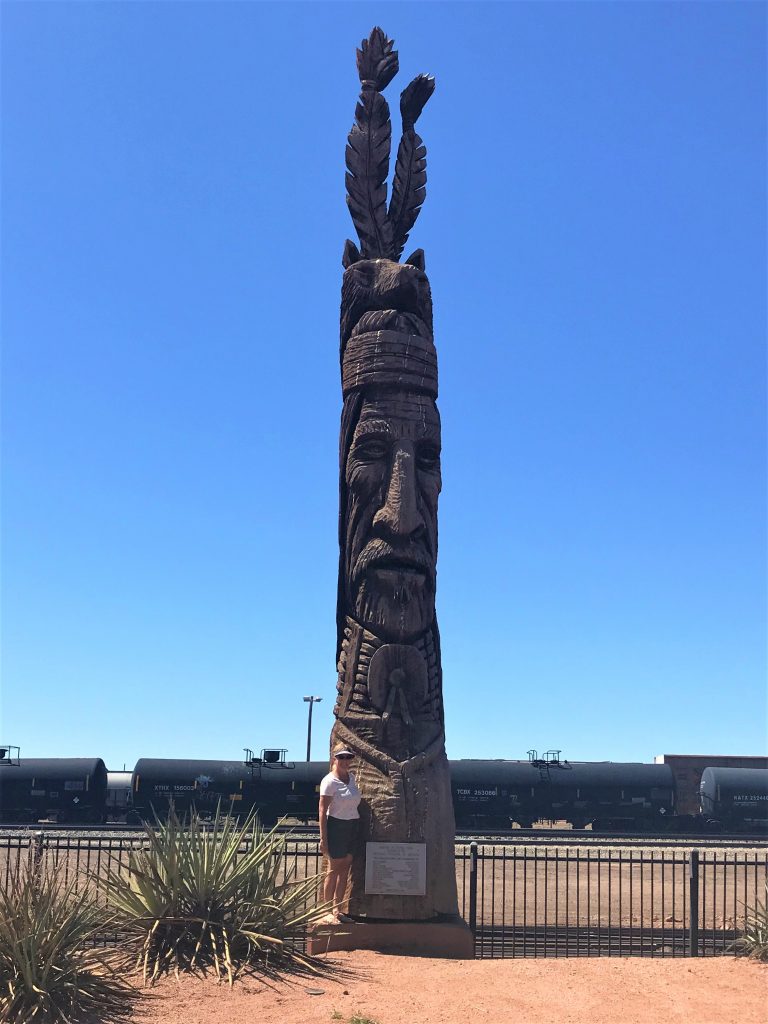
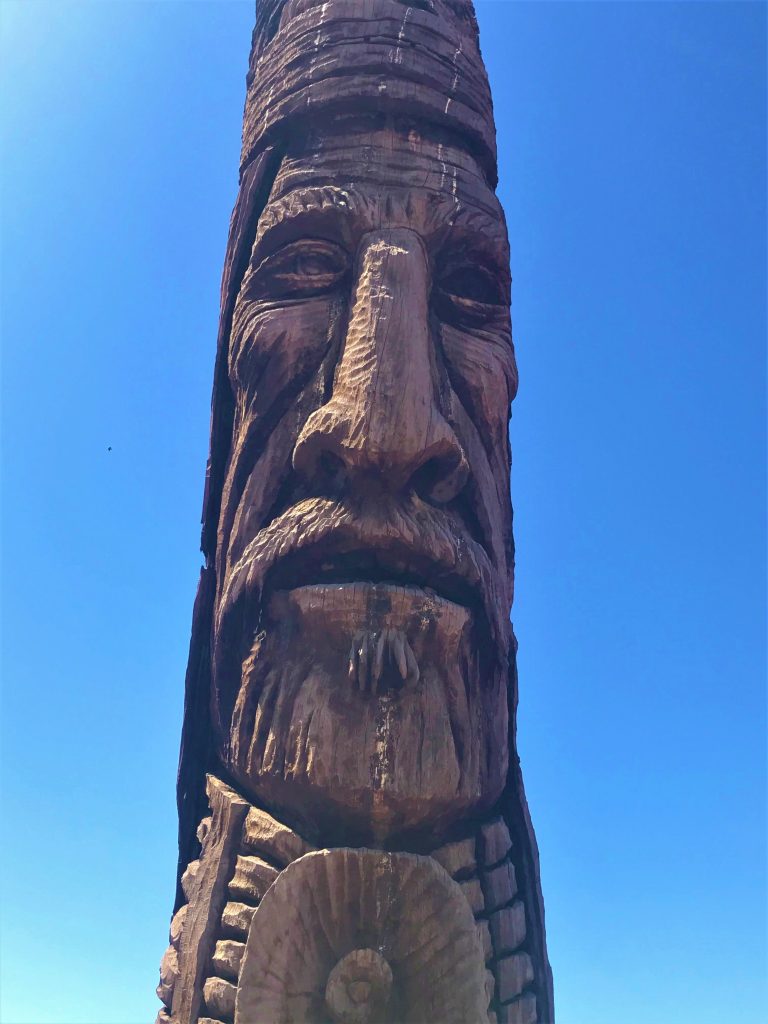
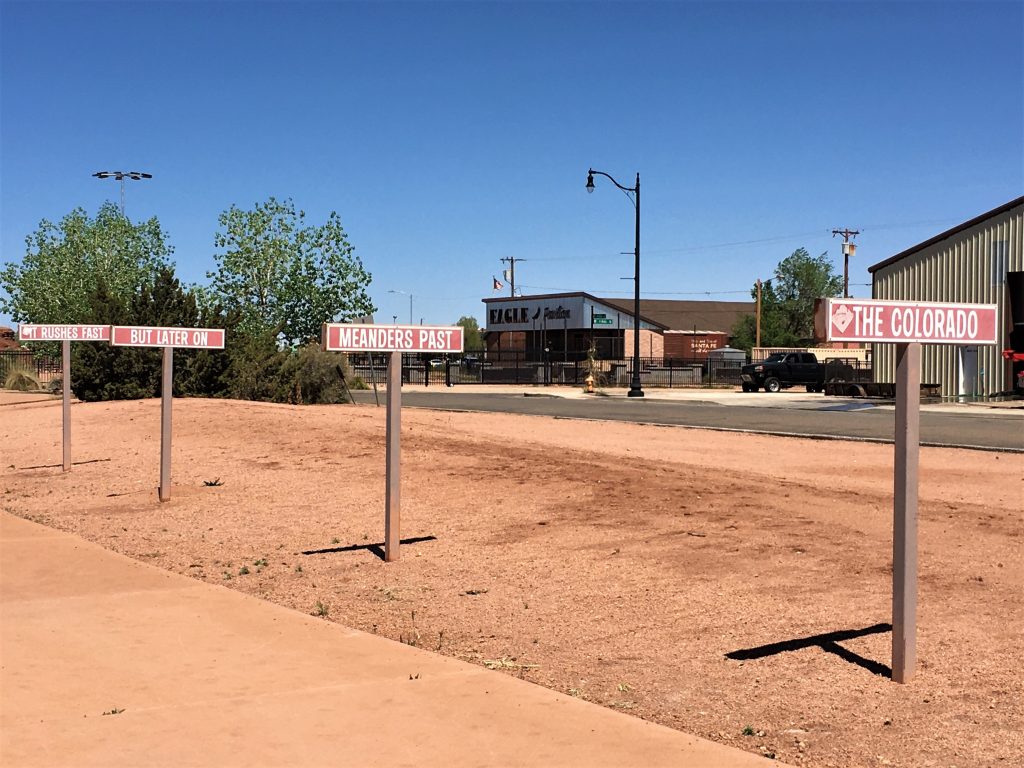
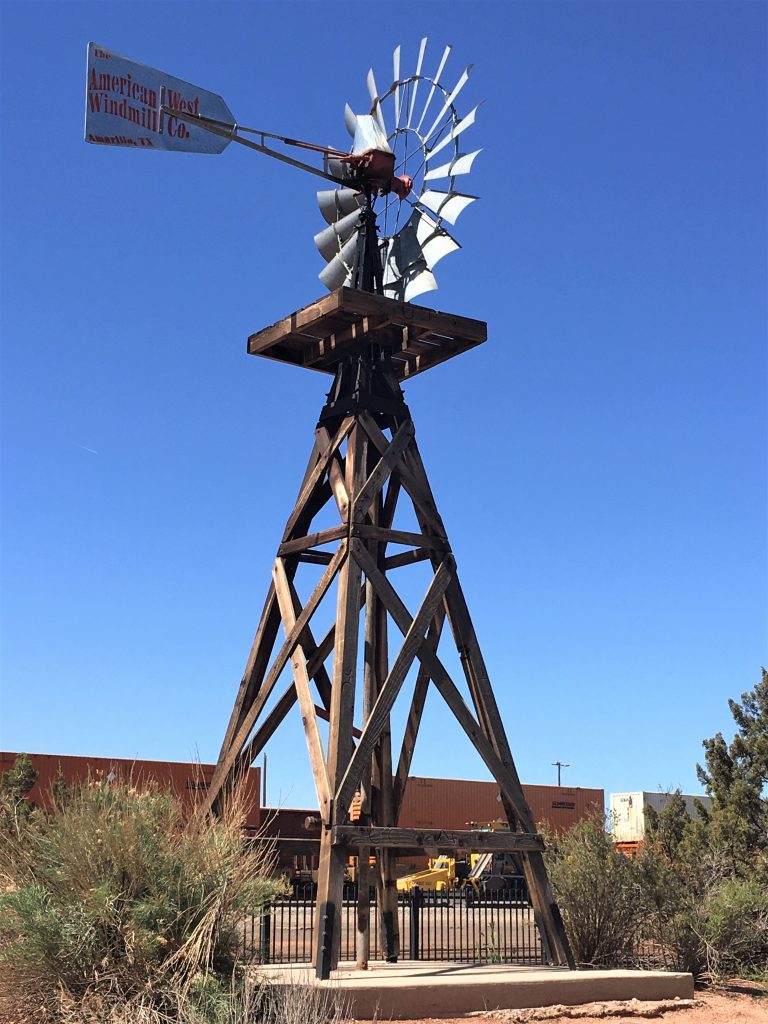
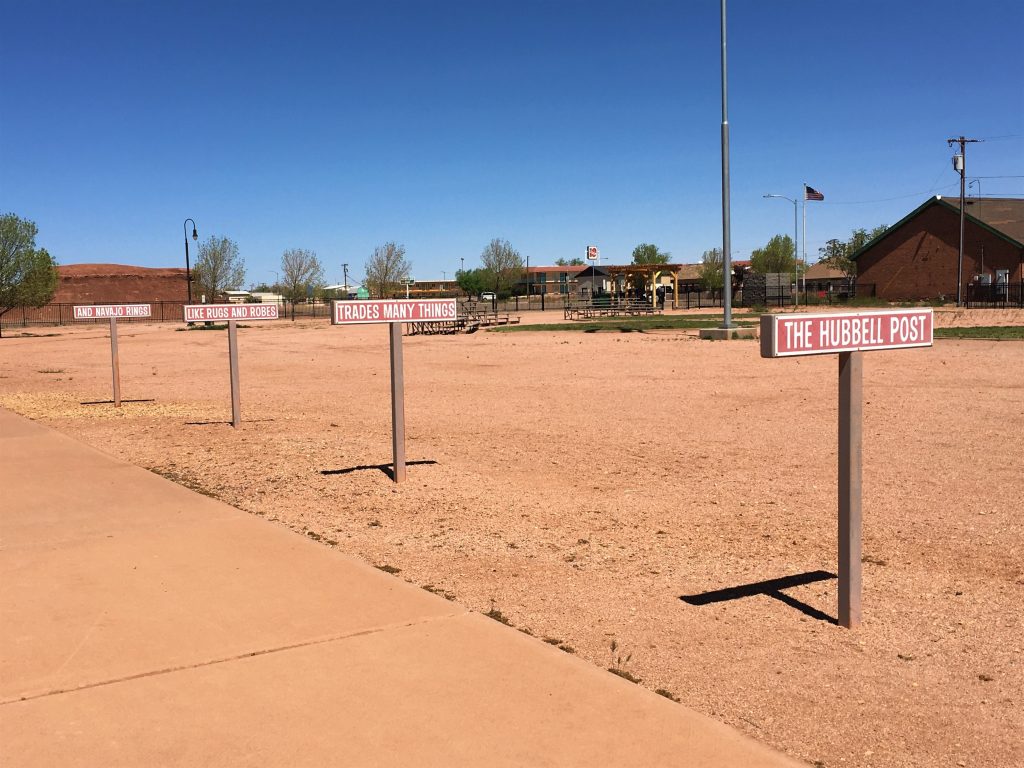
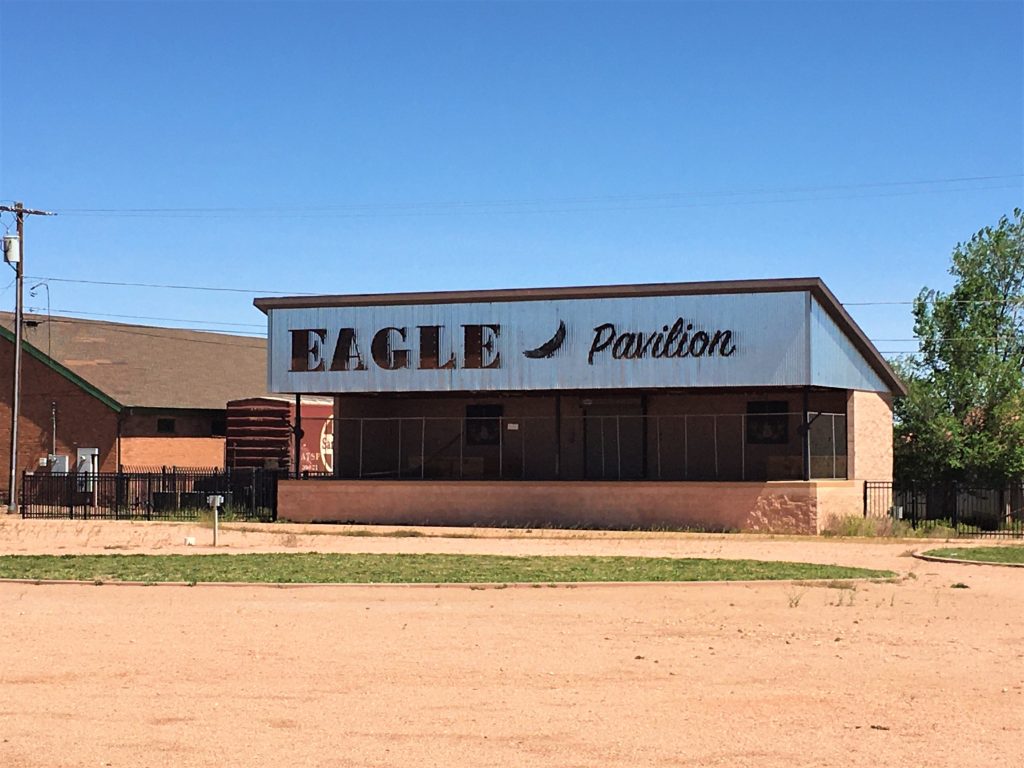
We’re kinda surprised their mascot’s a bulldog.

Do you supposed it has toilet paper in it?
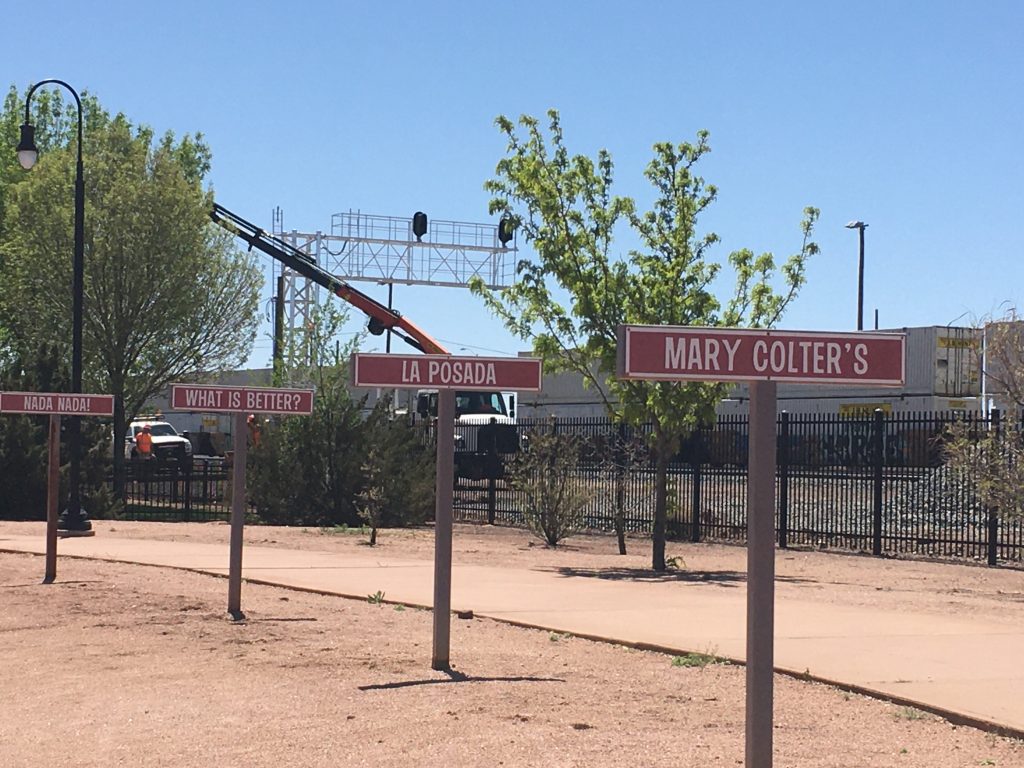
5. Apache Death Cave – – This place has a really interesting history! Enjoy!
In 1878, a group of Apache raiders attacked a Navajo encampment near the Little Colorado river. Almost every Navajo man, woman, and child was killed in the raid. When the Apache finished looting the encampment, only three girls remained and they were swiftly taken prisoner by the Apache.
When the Navajo leaders got word of this attack, they sent out 25 men to avenge the fallen encampment. They employed their usual strategies, tracking the Apache across the land, and blocking the borders to the region. However their efforts failed and the trails went cold, disappearing into the river and volcanic cinder.
News arrived that another nearby Navajo encampment had been raided, which meant that the Apache were still in the area. Scouts were deployed again, two of which were sent to check the short arm of Canyon Diablo. The scouts had found nothing until they were startled by a blast of hot air that was coming from underneath the ground. Upon further investigation, the scouts discovered that the hot air was coming from an Apache campfire in an underground cavern beneath them, large enough to house both the Apache raiding party and their horses. The scouts returned with news of their discovery, and the Navajo came back with a vengeance.
After they killed two unsuspecting watchmen at the mouth of the cave, they gathered up the dry sagebrush and driftwood on the canyon floor and started a fire at the entrance of the cave. Now aware of the attack as smoke billowed into their hideaway, the Apache slit the throats of their horses and used what was left of their water to put out the flames, doing their best to seal off the entrance with corpses of their former mounts.
A lone Apache man escaped from the fiery barrier and begged for mercy. The Navajo, as per tradition, proposed the customary payment of goods and stock in exchange for forgiveness. The spokesman agreed, and it seemed that the Apaches’ lives would be spared.
However, when the Navajo asked about the three girls that they had taken prisoner, the Apache spokesman hesitated, which confirmed the Navajo’s worst fears; the girls had already met their end. Enraged, the Navajo shot their guns into the cave and added more fuel to the fire. It wasn’t long until smoke and the sound of the Apache singing their death songs filled the air.
When the songs faded and the smoke cleared, the Navajo broke through the charred horse-corpse barrier. They retrieved their goods, and stripped off the valuables of the 42 Apaches that suffocated inside of the cave.
From that point on, no Apache has used that cave for any reason. Apaches would never again raid the Navajo people.
Local tribes would warn would-be pioneers about the cave, saying that the land around it was cursed, but it was often passed off as silly superstition by the settlers. The pioneers who lived there would later report hearing disembodied groans and ghostly footsteps outside their cabins, the horrendous stories of the massacre at the cave finally burrowing their way into their imaginations.
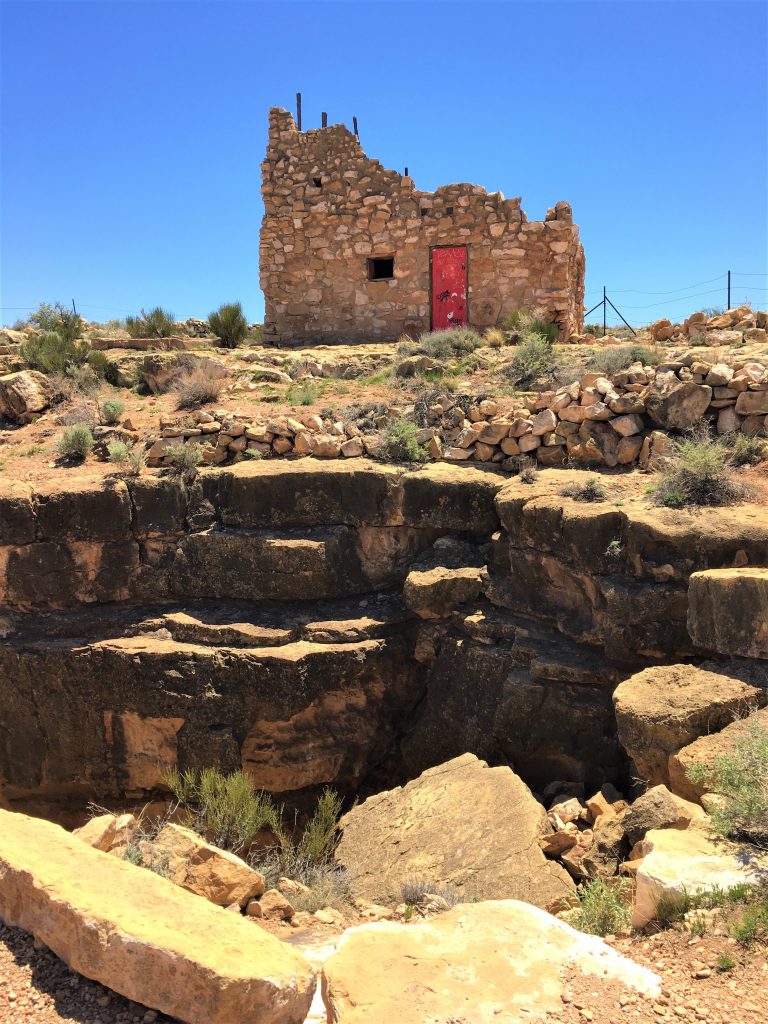
There were no signs.
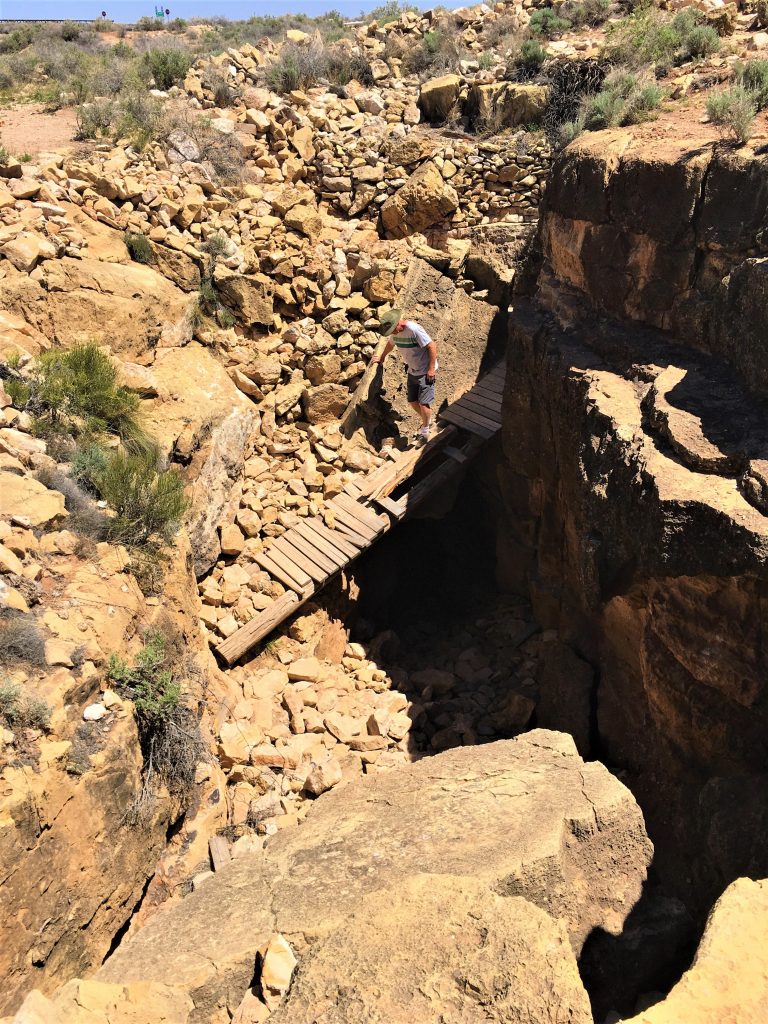
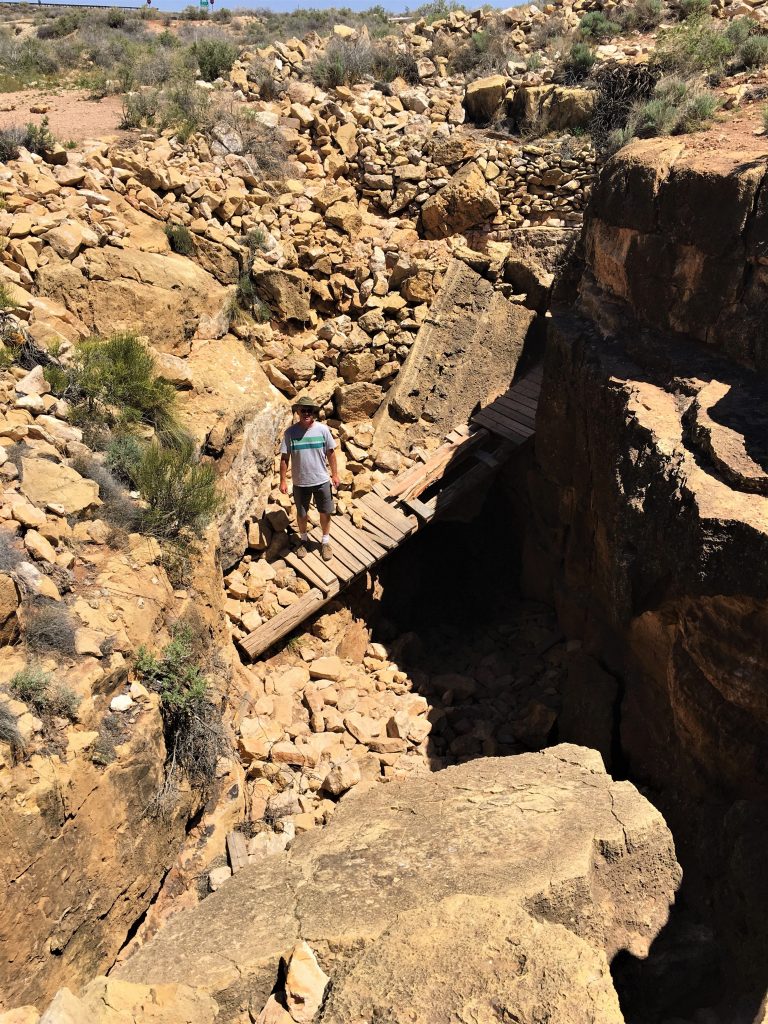
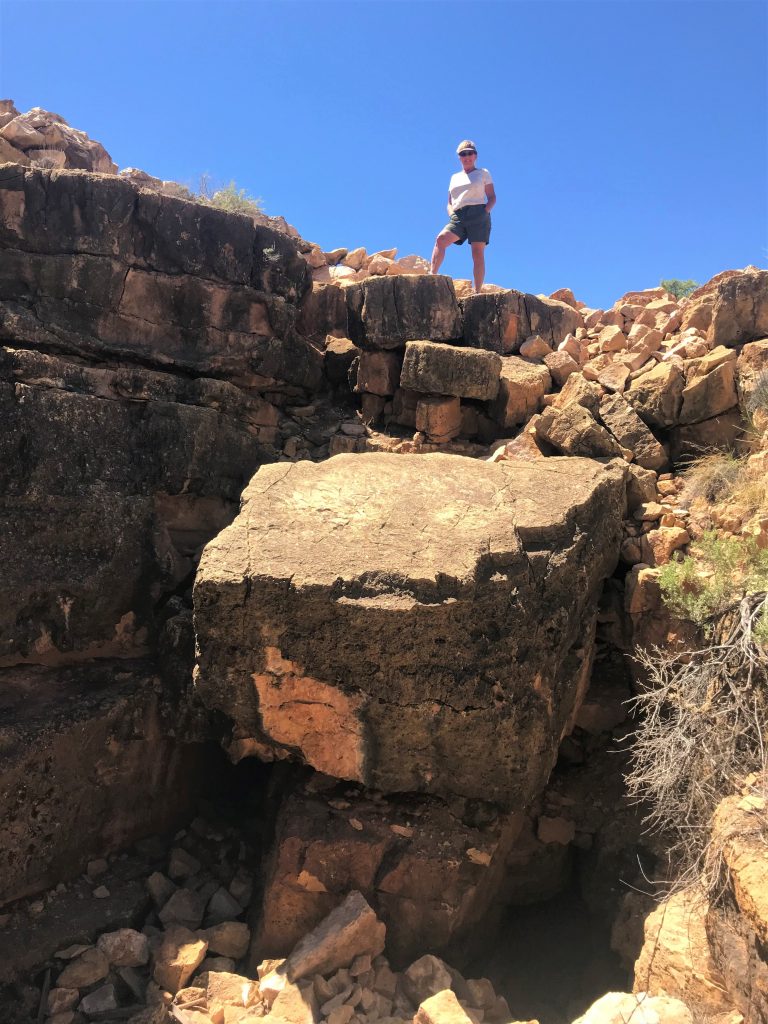
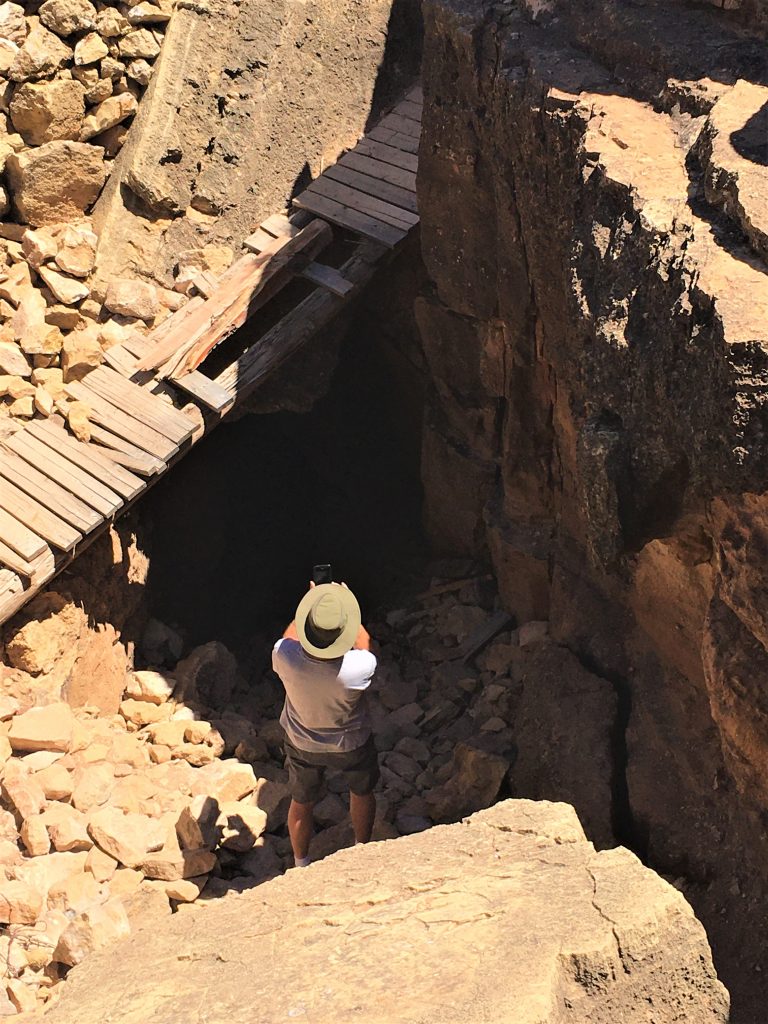
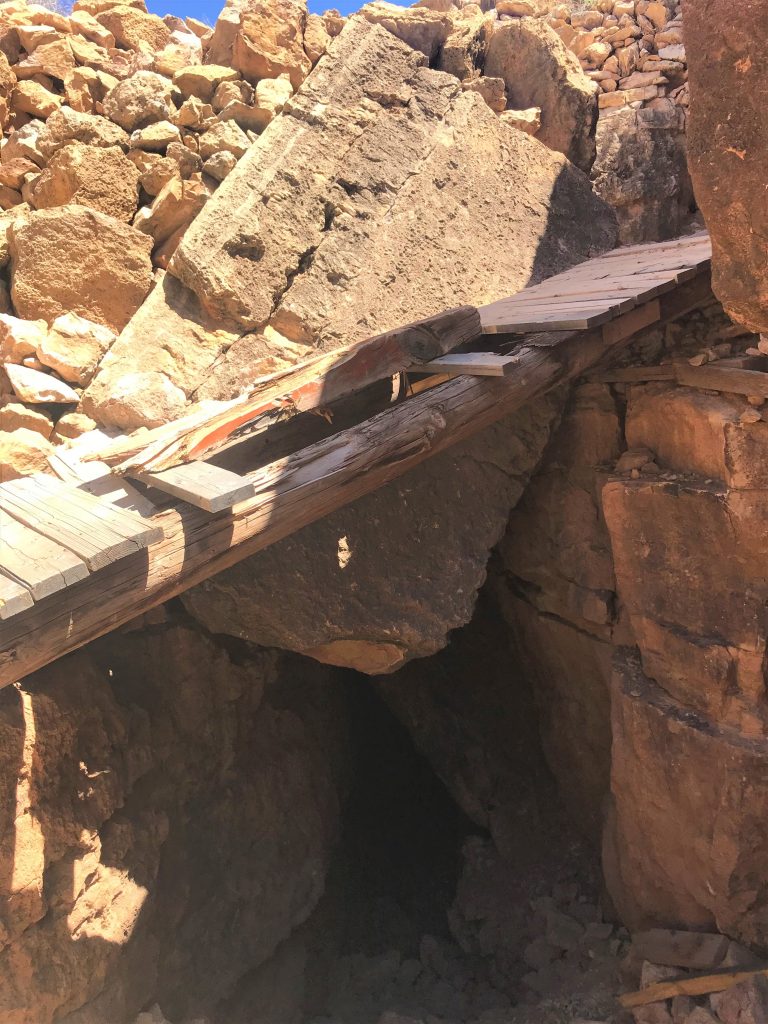
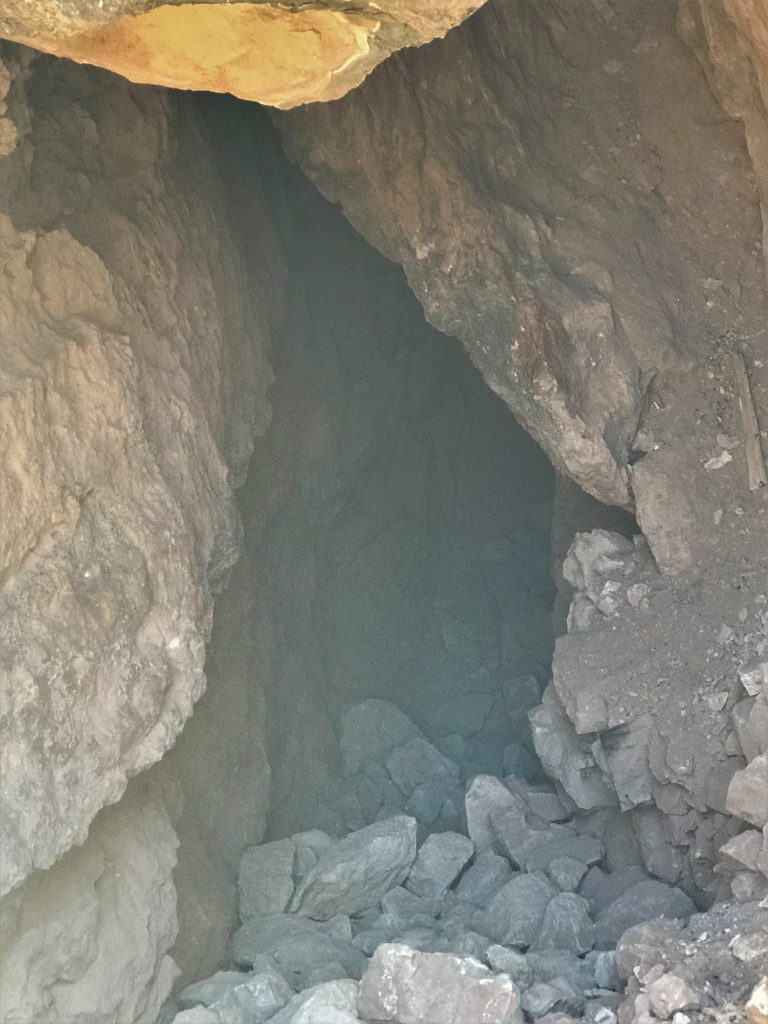
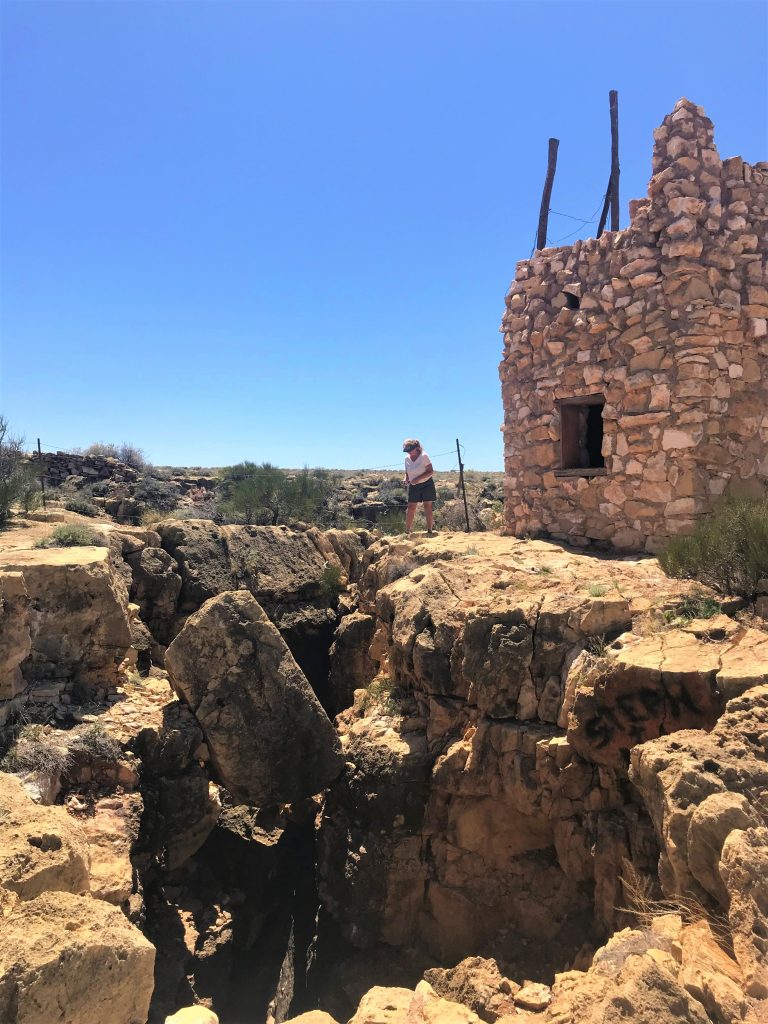
6. Two Guns Trading Post – – And this one has even more! The former trading post and the Apache cave are within close walking distance of each other. This is actually where we began our walk-around, but you kinda needed to know the Apache Death Cave story first. Enjoy the story!
It’s got all the workings of a modern-day Hamlet – murder, madness, and supernatural superstition dotting its colorful history.
Two Guns, originally known as Canyon Lodge, started out as a modest trading post at the beginning of the 19th century, run by a couple of homesteaders by the names of Mr. and Mrs. Daniel B. Oldfield. A few more westward pioneers staked claim to the area over the years, and by the early 1920s the road through town, known as the National Trail Highway, became the preferred route across Diablo Canyon. When Earle and Louise Cundiff blew into town, they swooped up 320 acres of the land, making Canyon Lodge a busy stop for travelers. By the late ’20s, what was once the National Trail Highway was blossoming into the famed Route 66, and the once-isolated trading post was evolving into a bustling stop for incoming drivers needing gas, food, and oil.
This quickly escalating prosperity caught the attention of a man named Harry Miller. A well-educated veteran of the Spanish-American War and an ostentatious publicist, Miller was an eccentric man who claimed to be full-blooded Apache, and was known for his garish and unpleasant demeanor. Wanting a piece of the action, Harry “Two Guns” Miller allegedly struck a deal with the Cundiffs to lease a business site for ten years.
Under Miller’s watch, the trading post was turned into a full-blown tourist trap, renamed Two Guns. He grew out his hair and braided it, taking on a persona by the name of Chief Crazy Thunder. He started a zoo with chicken-wire cages that held mountain lions and other native Arizona animals, and started tours down into a canyon cave now called Apache Death Cave, where 42 Apache men met their death in battle.
The story of the cave was interesting in its own right, but Miller believed that the tale needed something more. He cleaned up the remaining bones he found in the cave, built fake ruins, and repurposed the tomb into a “cave dwelling.” In a macabre commercial stroke of genius, he saved the skulls of the ill-fated Apache and sold them as souvenirs. In order to make the cave a bit more tourist-friendly, he also strung up some electric lighting, threw in a soda stand, and renamed the death cave the “Mystery Cave.”
It was around this time that people say the curse of Two Guns began.
With Miller’s tourist-attracting efforts, Two Guns grew even faster, but it was only a year before the town became overwhelmed with misfortune, starting with a drifter couple who stayed in Two Guns for a night, and then stole a large amount of merchandise from the trading post. This set Miller back quite a bit, but it was only the beginning.
The terms and broad wording of Miller’s ten-year lease had always been a source of tension between him and Earl Cundiff, and that tension would finally snap on March 3, 1926. During a heated dispute over the lease, Miller shot Cundiff in cold blood. For unknown reasons, Miller was acquitted at the trial.
While Miller didn’t go to prison, he suffered in other ways. Shortly after his trial, Miller was mauled by a mountain lion – twice – on two separate occasions. He also was bitten by a Gila monster, a poisonous bite that led to an illness and a completely swelled-up arm, which, following two mountain lion attacks, must have been not quite so bad in comparison.
In 1929, a huge fire would gut the trading post at Two Guns, and when the widow Cundiff tried to prove her claim on the homestead land, Miller protested, claiming that the land was his because he was there before them, which was a bold-faced lie. After $15,000 worth of court actions later, Cundiff managed to keep ownership of the land – Miller would leave soon after.
Even without Miller, Two Guns and its inhabitants continued to suffer. Route 66 was rerouted to the opposite canyon, taking its travelers and their money with it. Louise Cundiff and her new husband, Phillip Hersch, had to rebuild everything in Two Guns, including the zoo, on the opposite canyon just to keep the town going.
Two Guns was finally sold in the 1950s, and doomed to be leased and abandoned numerous times until 1960, when a man named Dreher revitalized the area with a restaurant, gift shop, gas station, and even another shot at a zoo. He created tourist trails to the cave, and began exploring the possibilities of touring the cavern where all of those Apache warriors Miller claimed to be descended from lost their lives.
It seemed that Dreher was immune to the Two Guns curse, or perhaps it was finally broken. With Interstate 40 on its way to completion, Two Guns would have its own dedicated exit ramp, which meant tourists would once again be passing through the town. All was going splendidly – until a huge inferno swallowed up the entire place in 1971.
That was be the last time Two Guns would ever be inhabited.
Here’s a couple of old pictures I was able to find. . . .
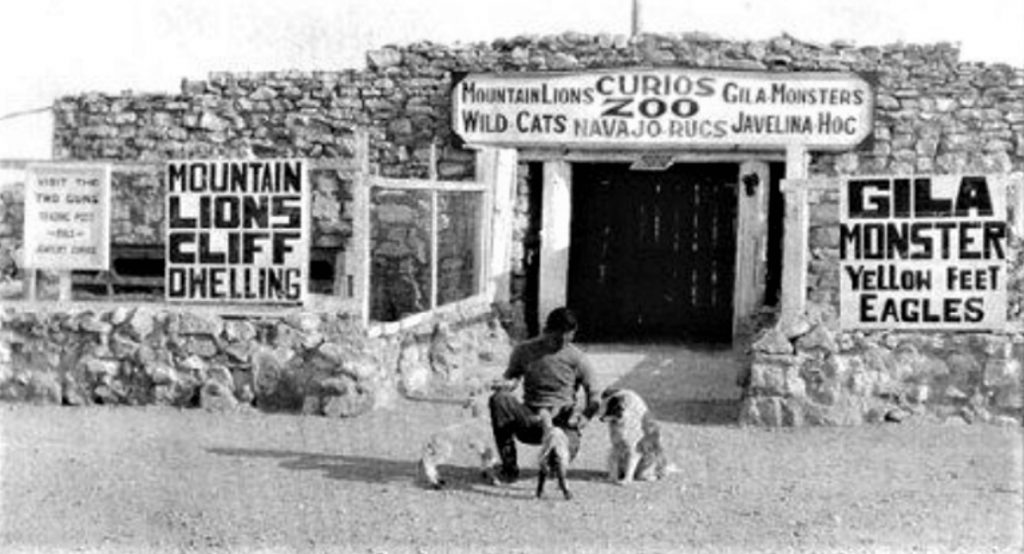
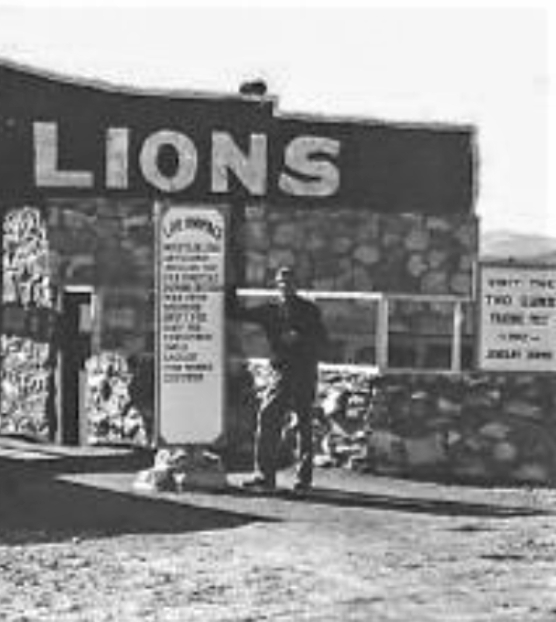
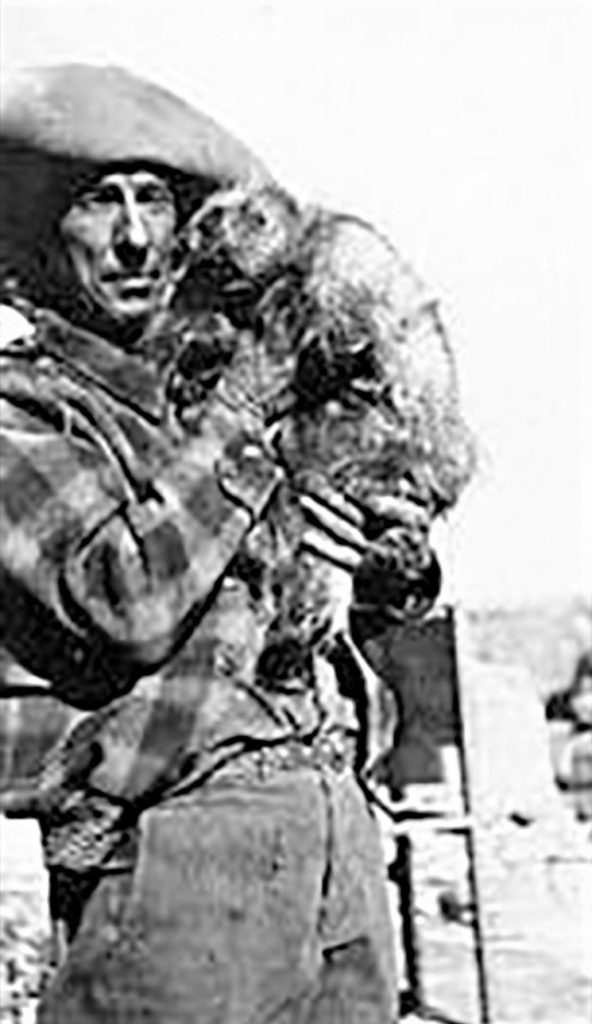
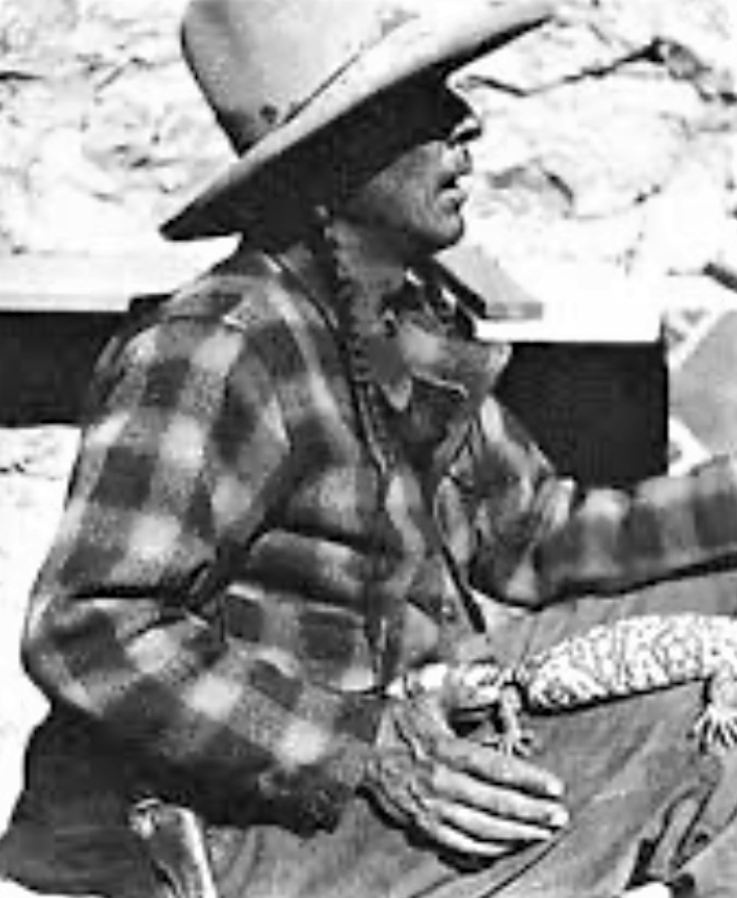
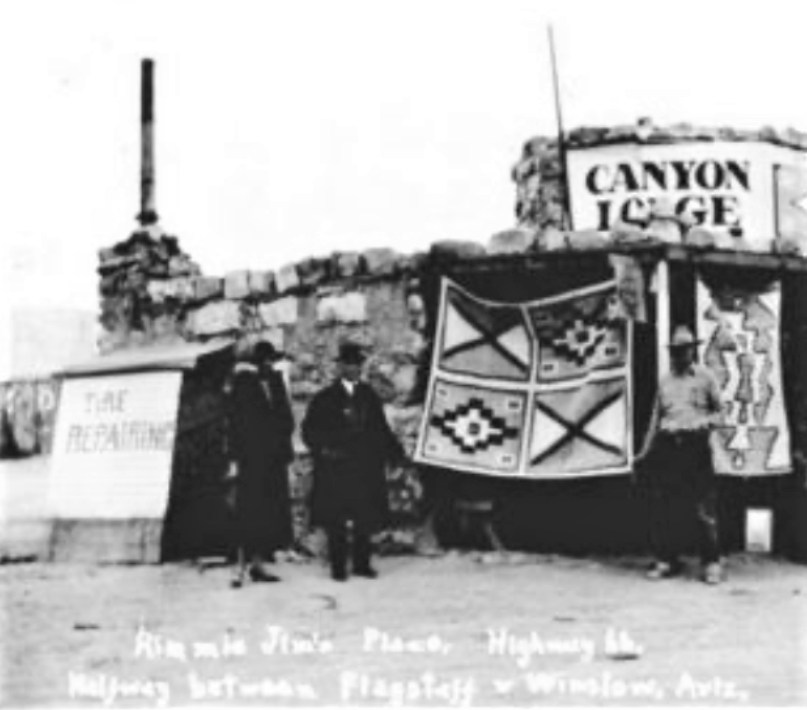
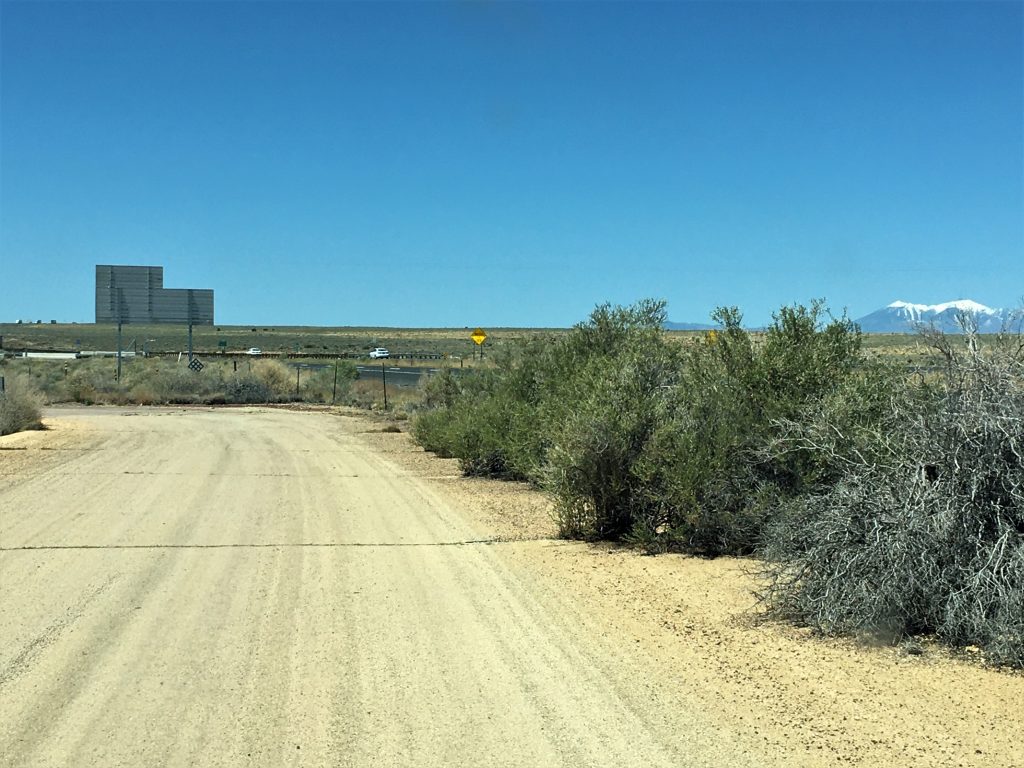
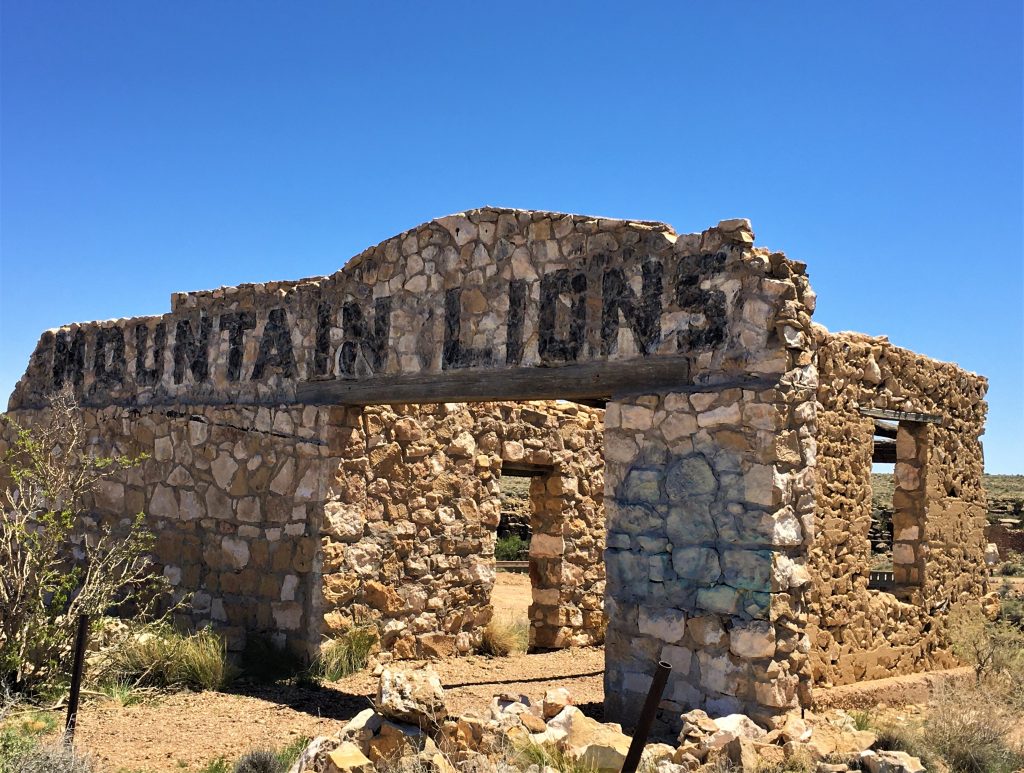
There are no signs or anything telling you what you’re looking at, etc.
It’s just abandoned property.
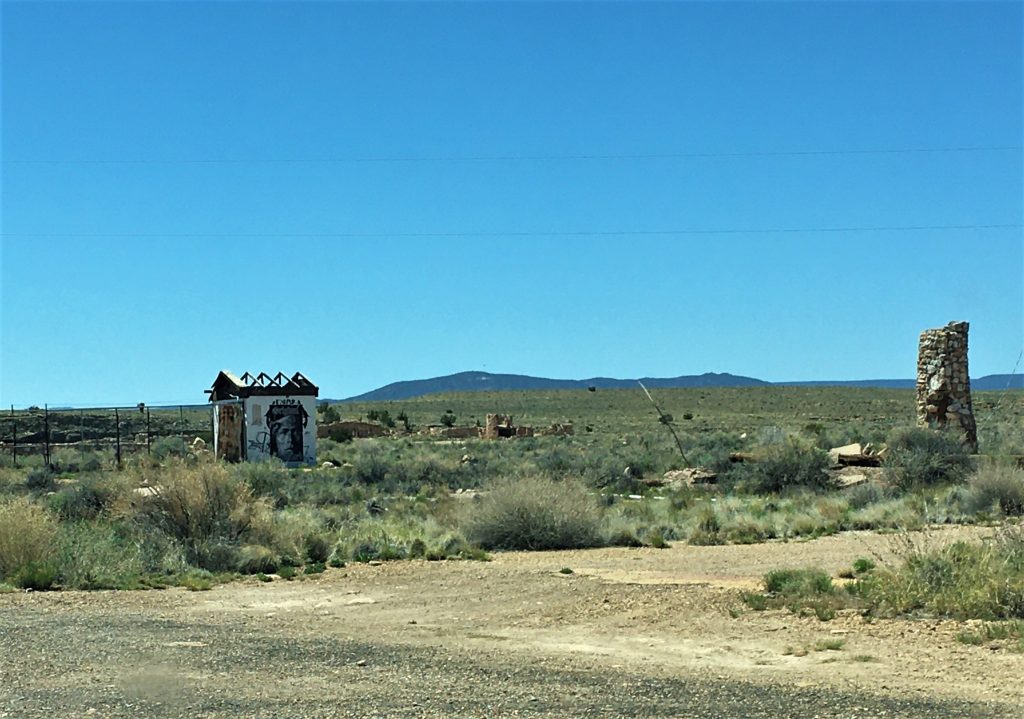
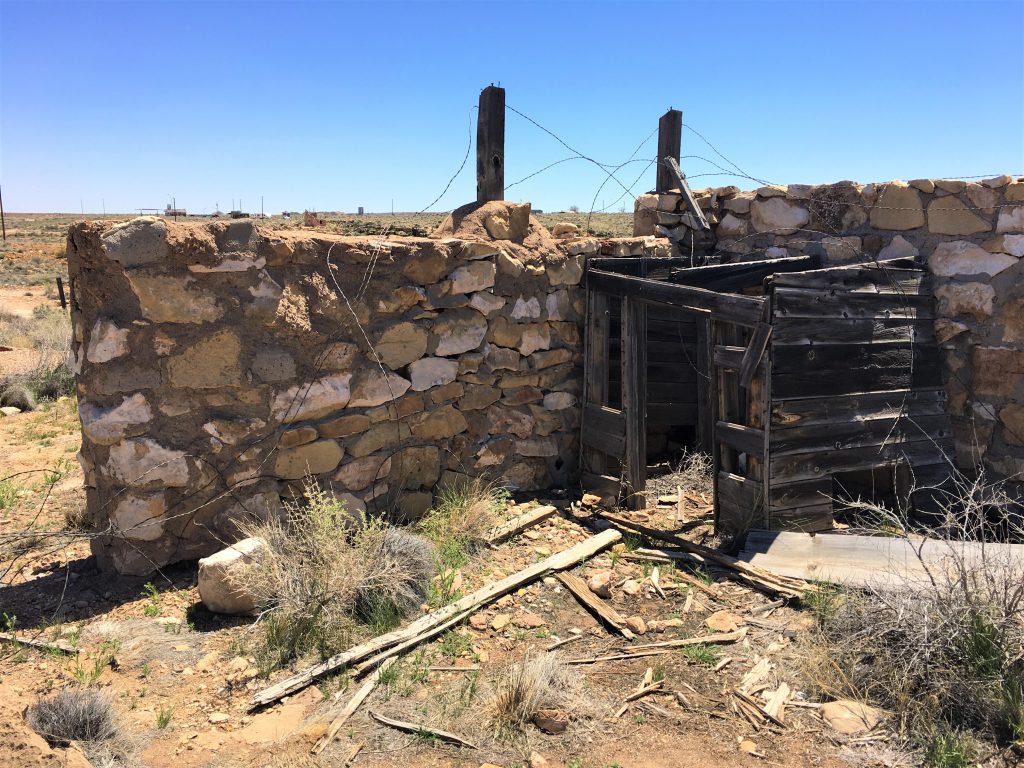
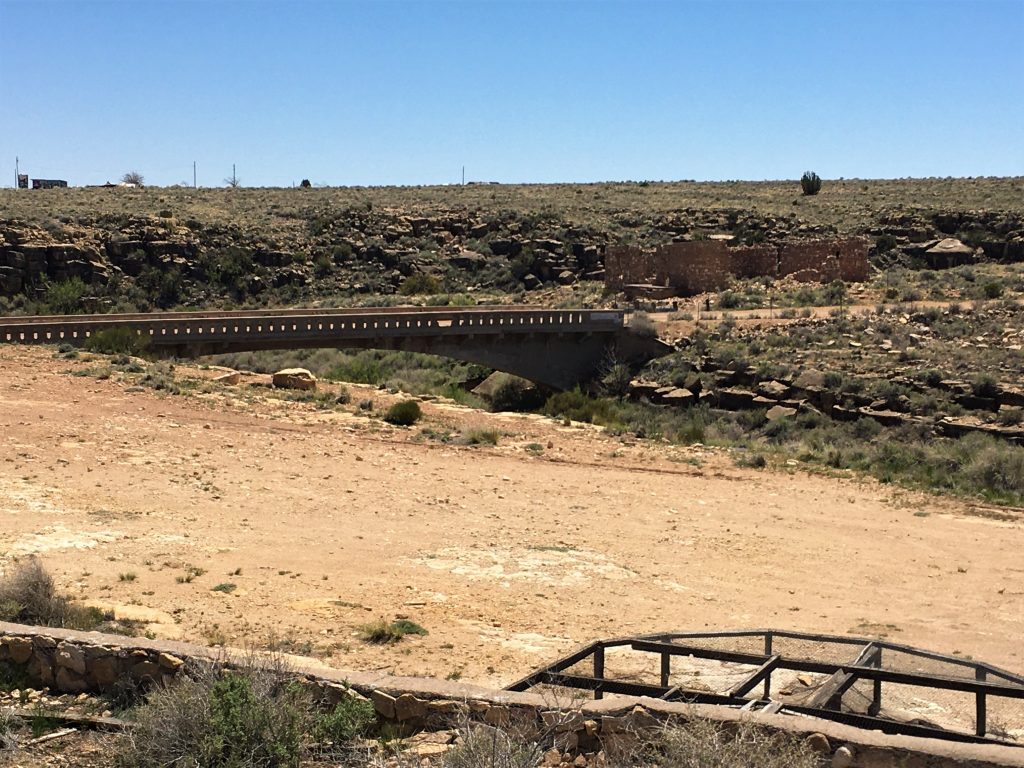
we don’t really know which are authentic and which were constructed
to look like ruins. . . .
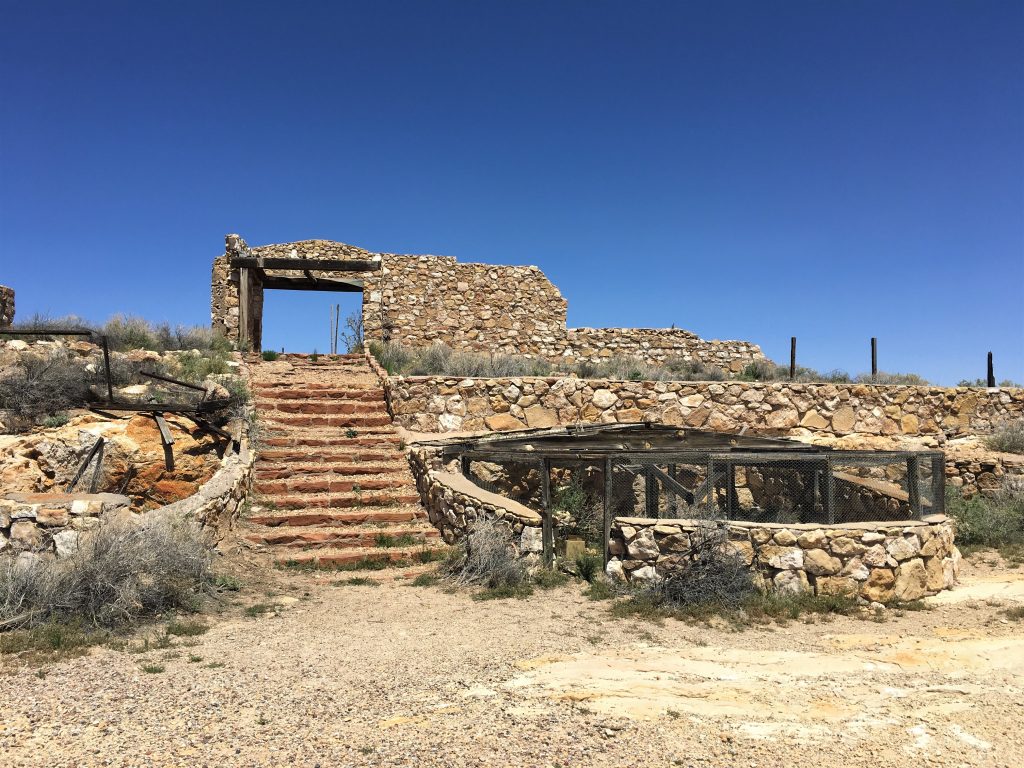
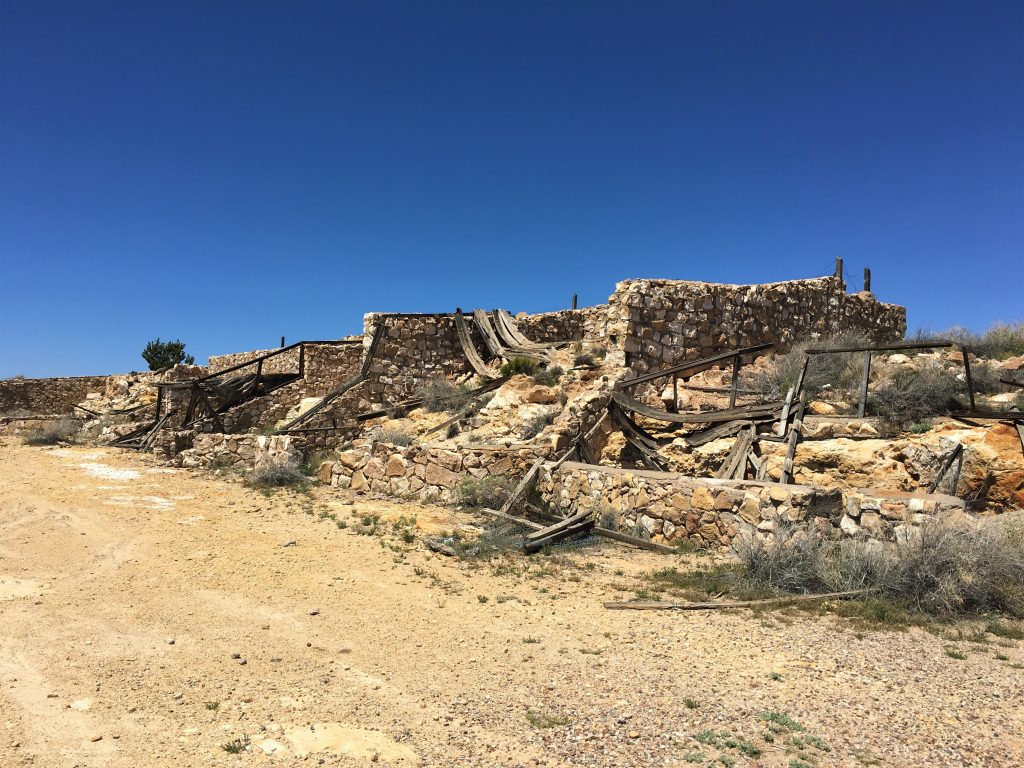
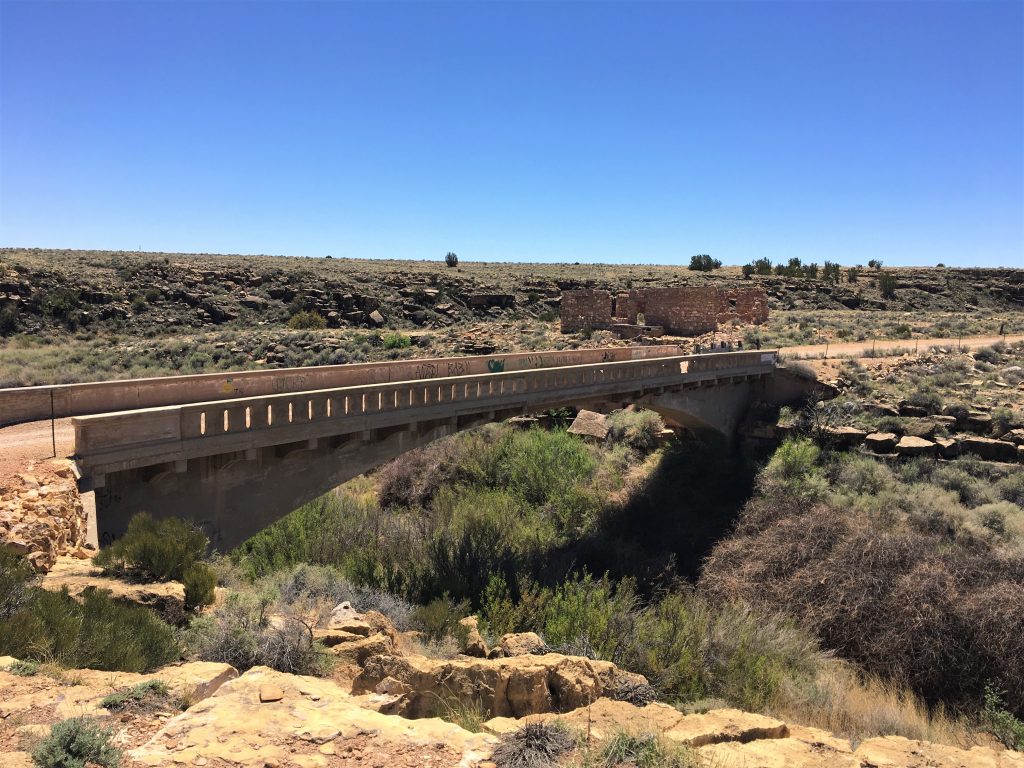
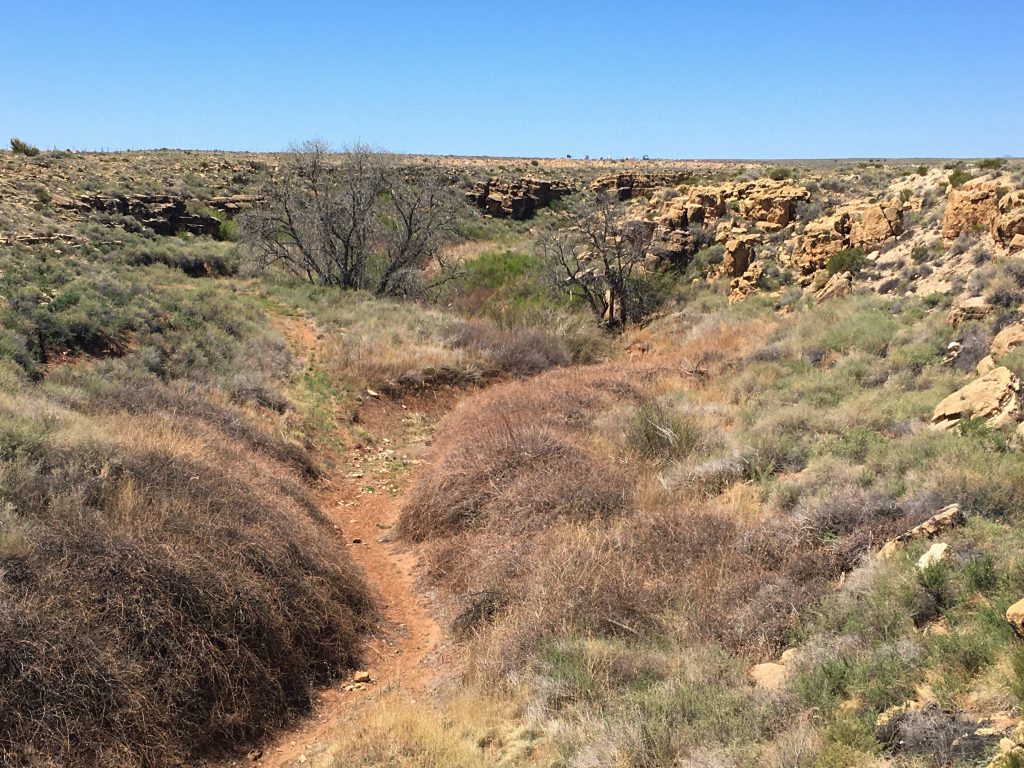
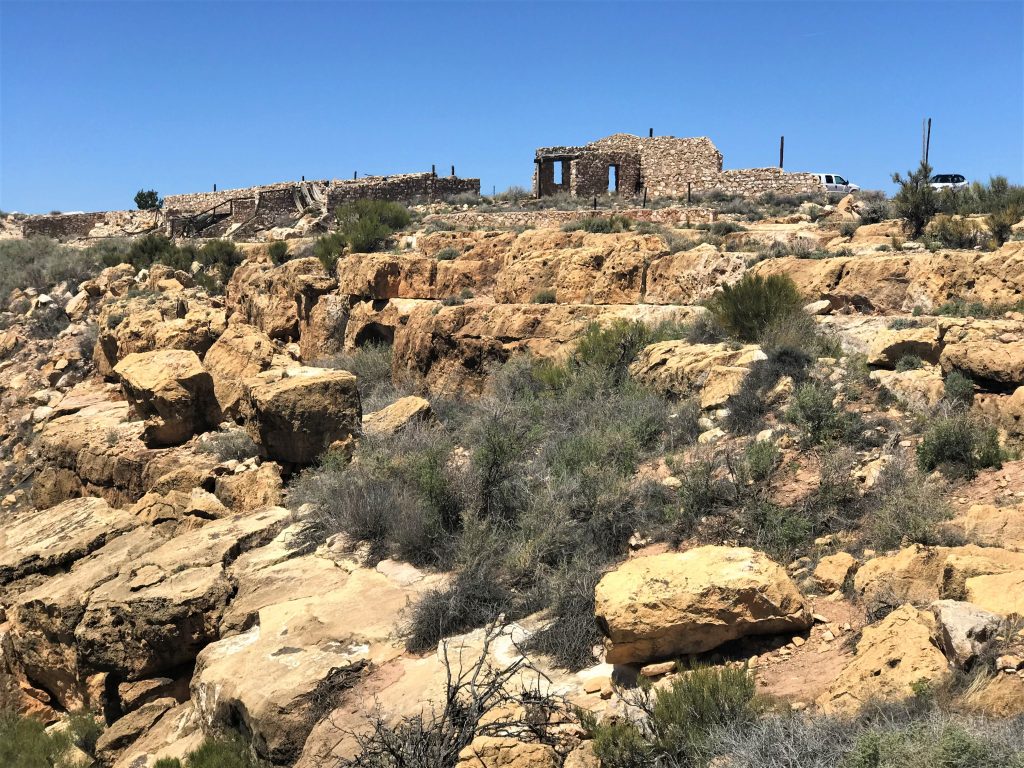
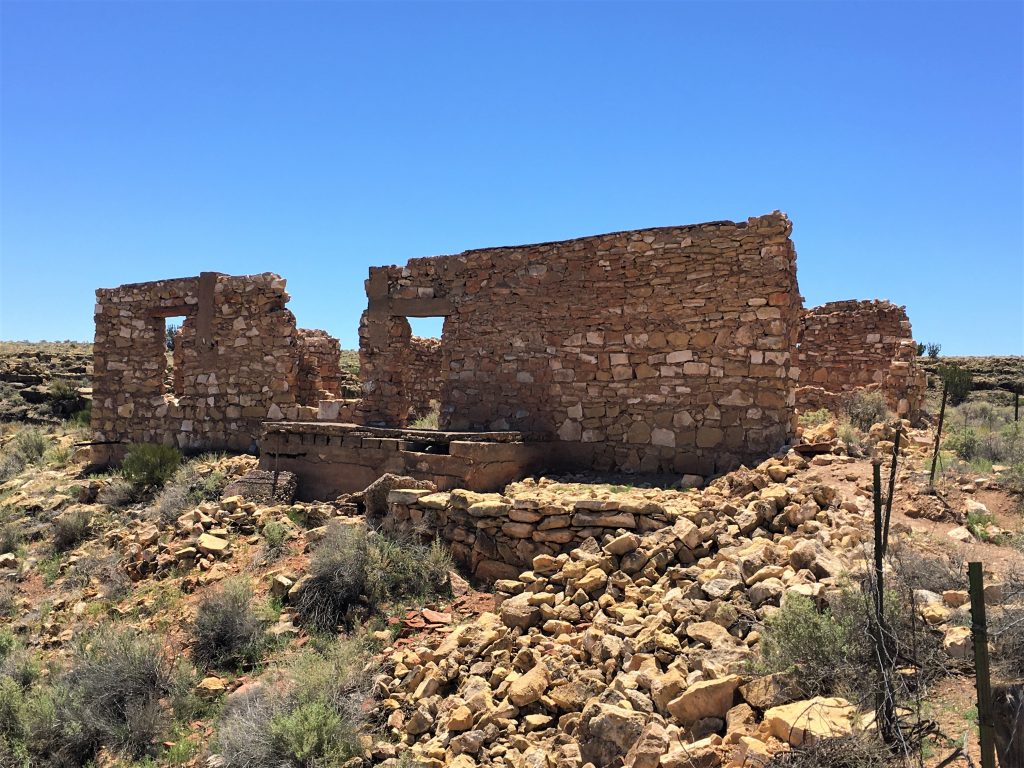
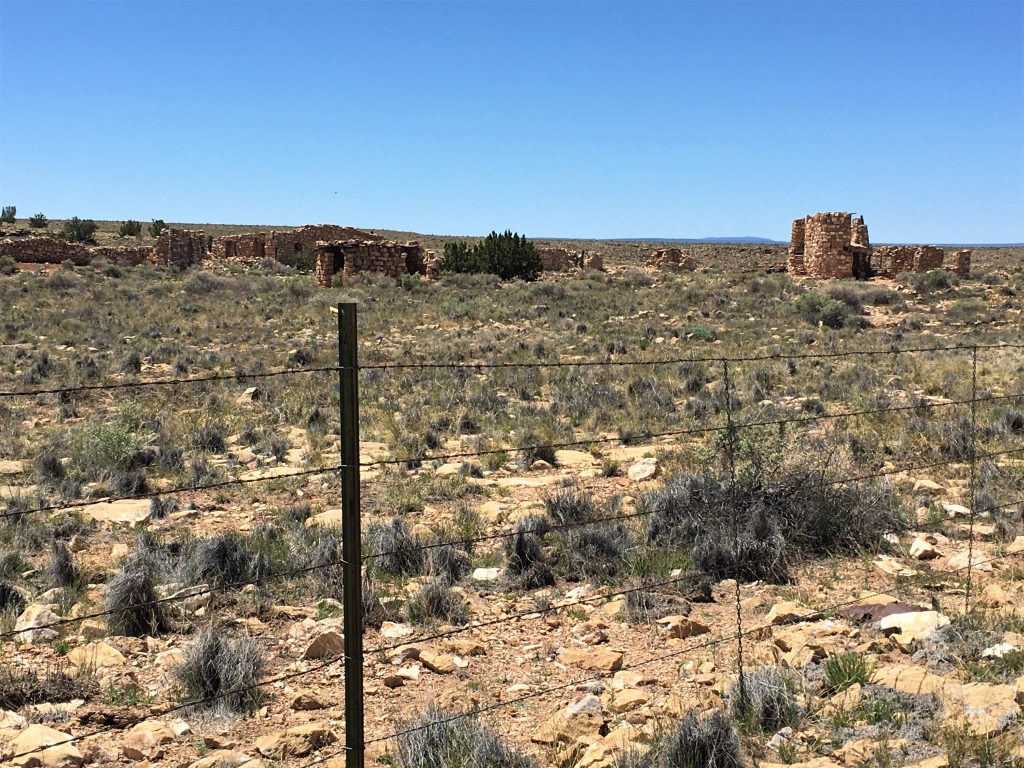
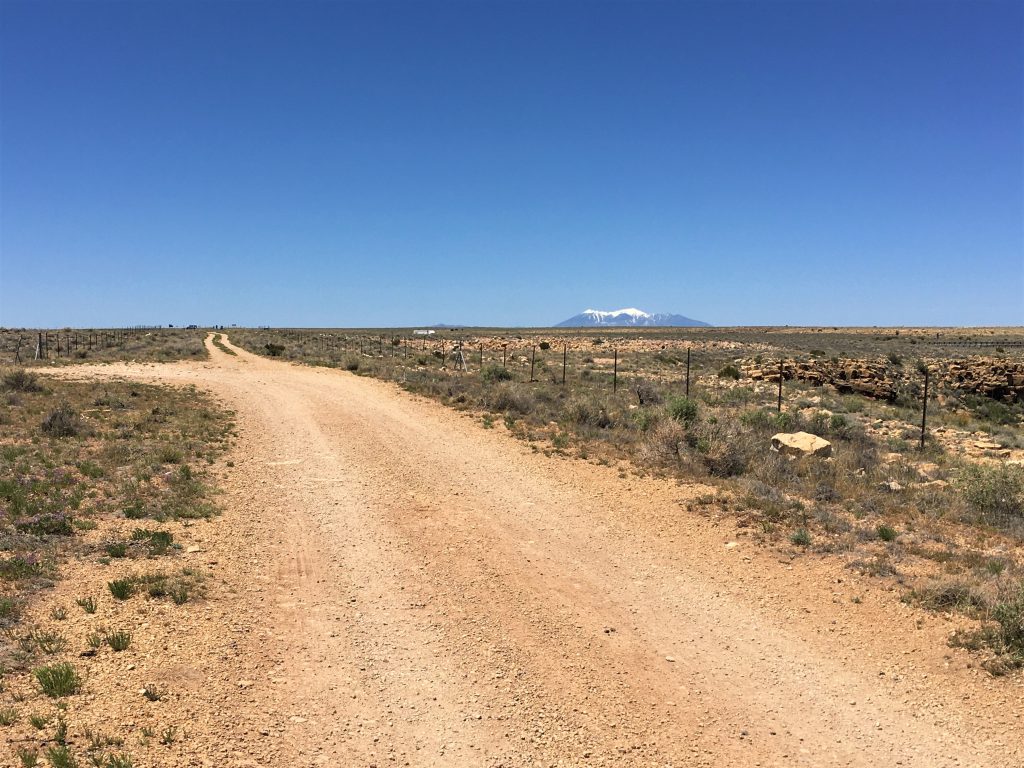
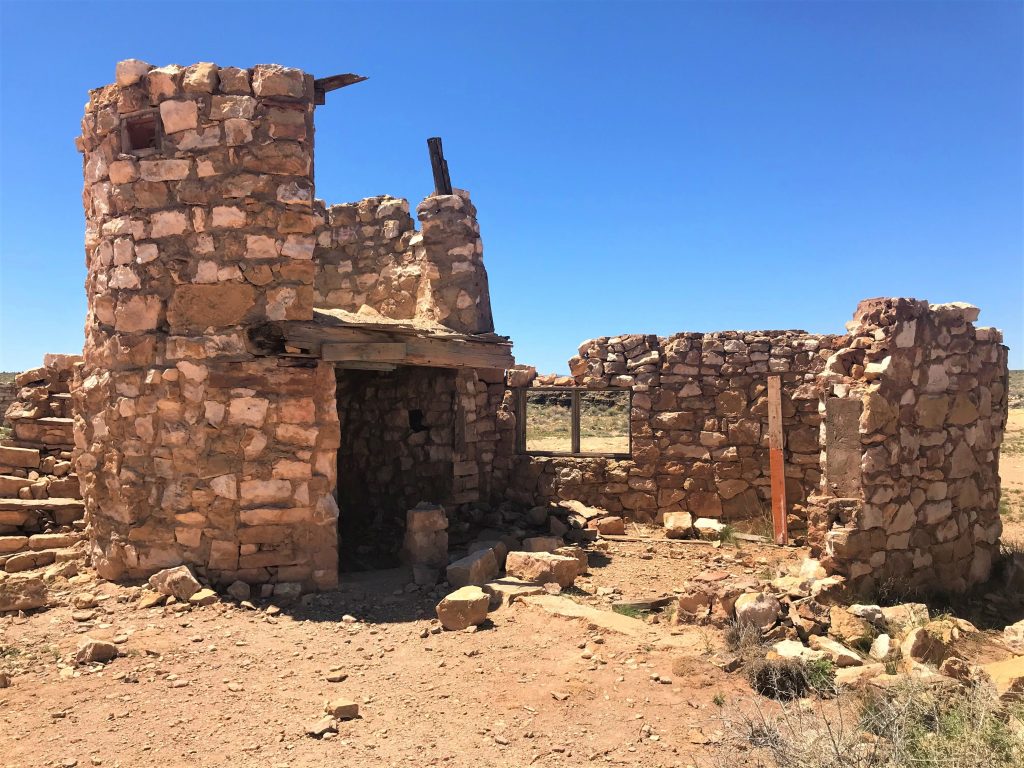
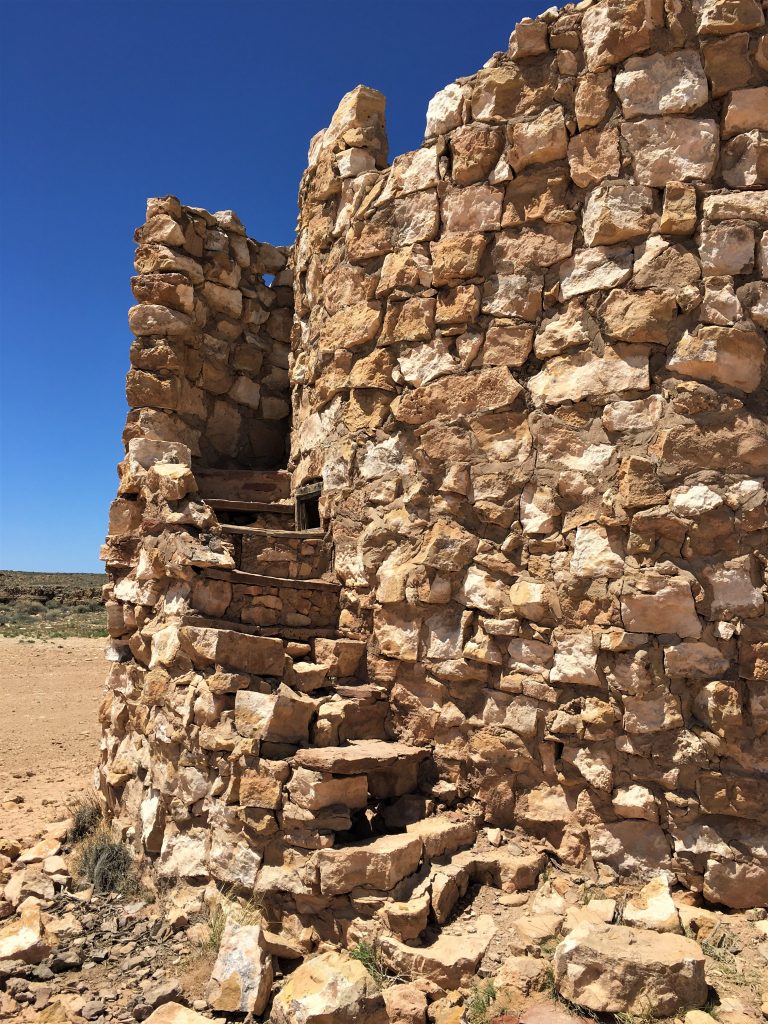
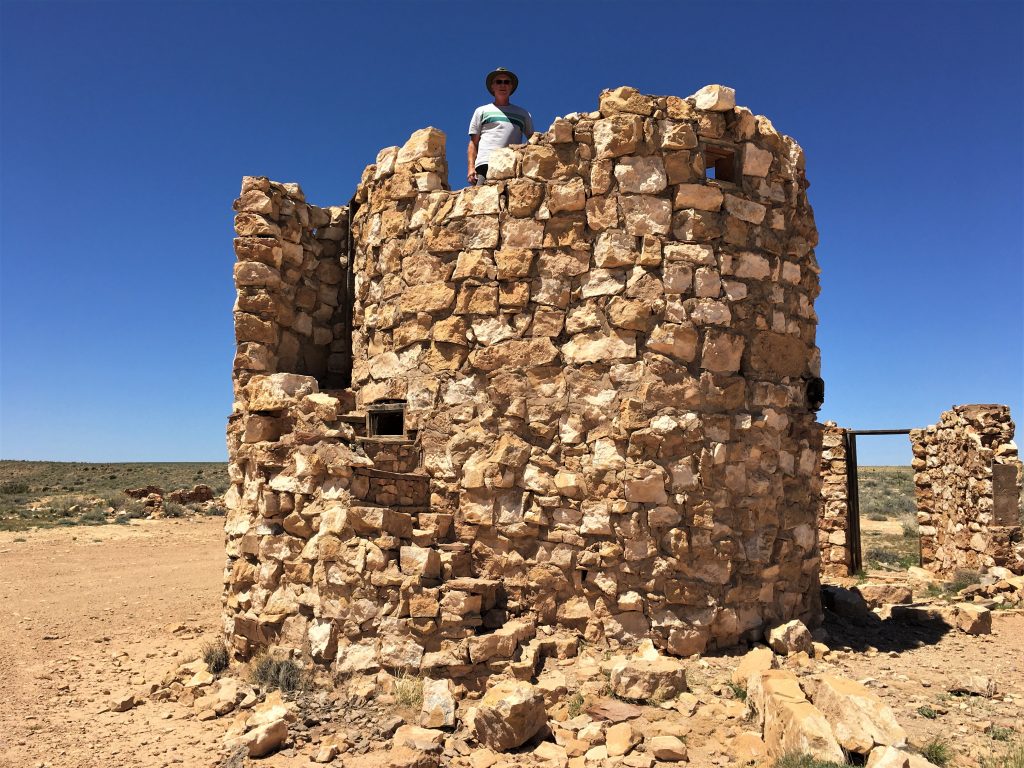
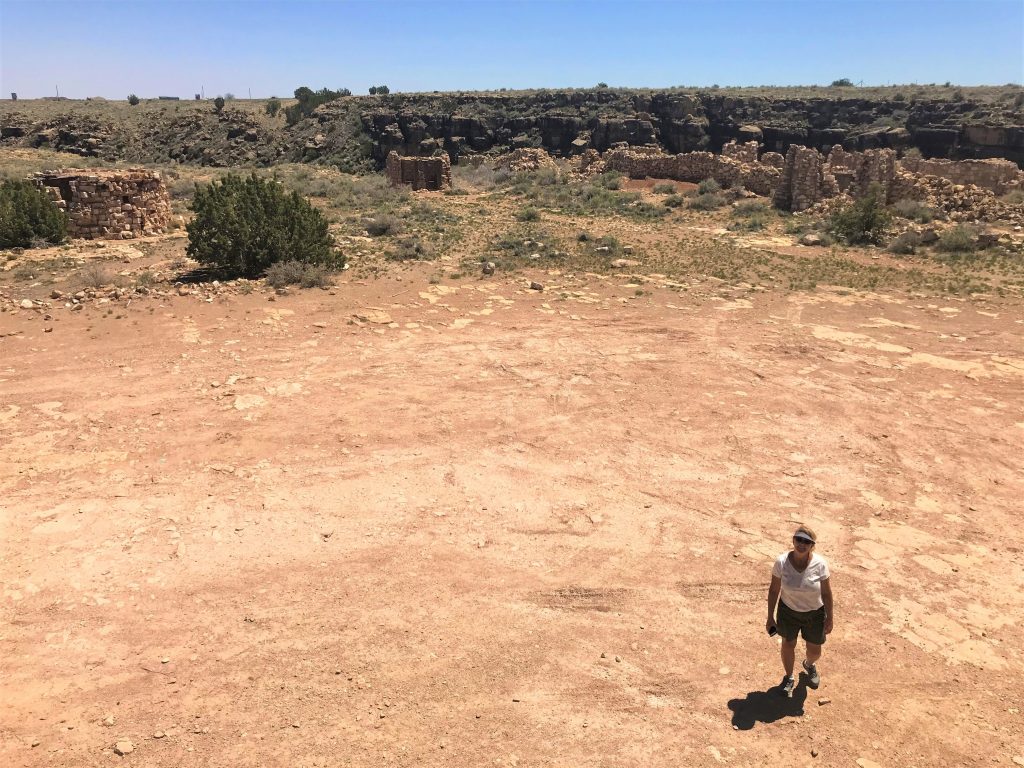
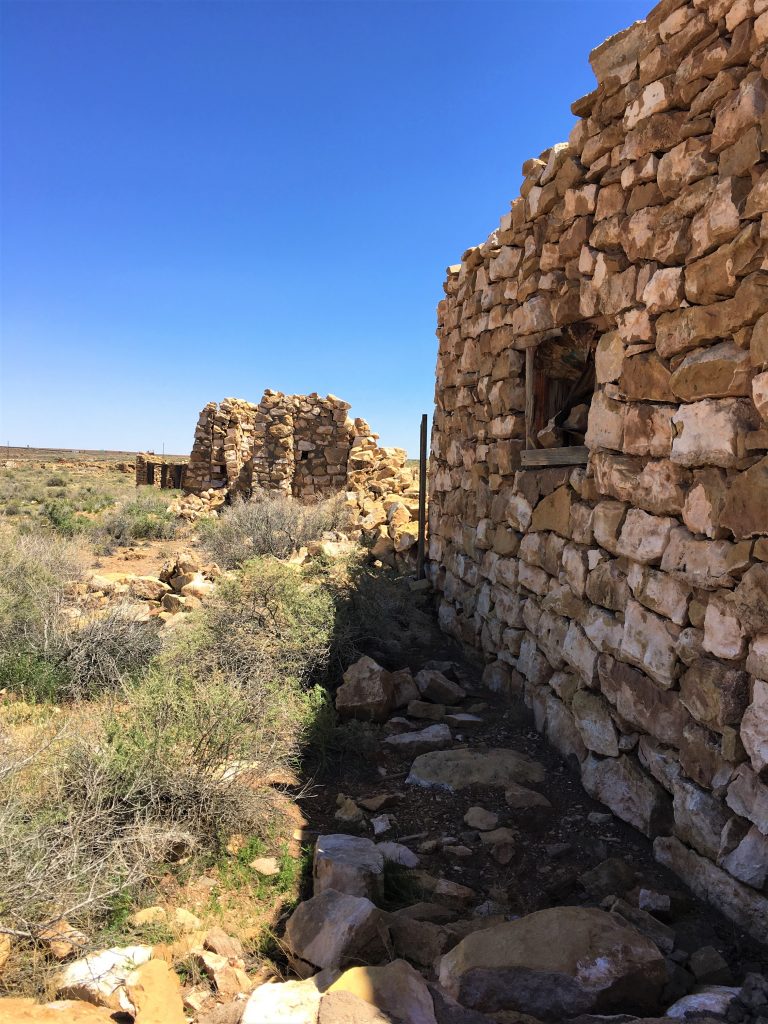
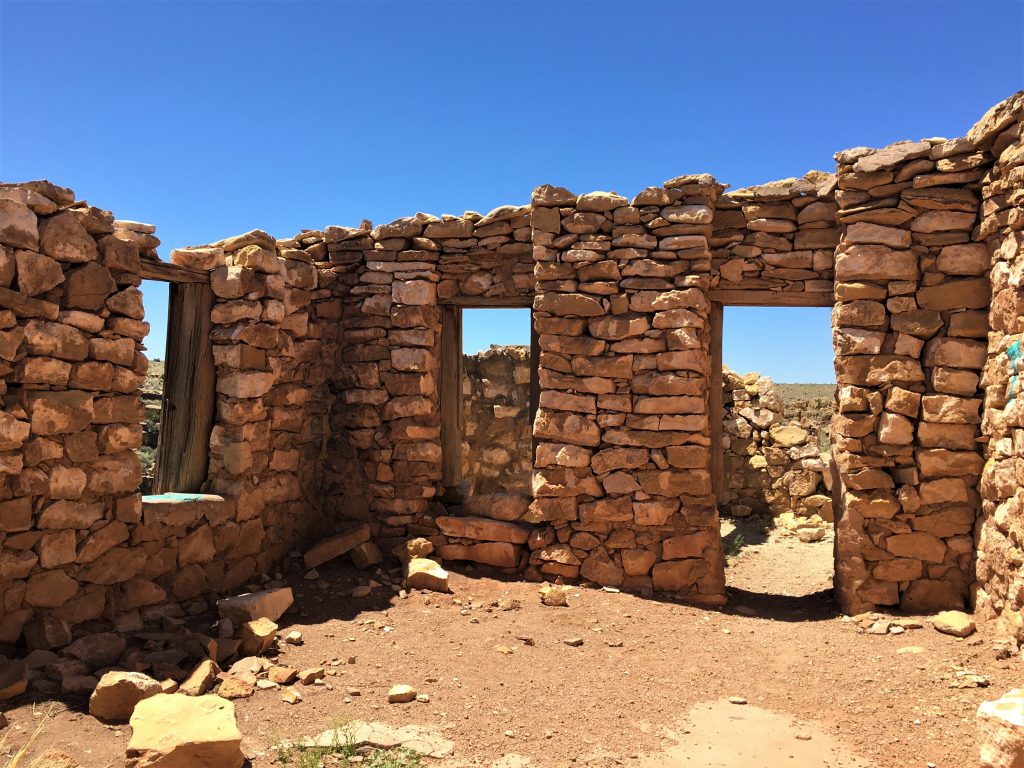
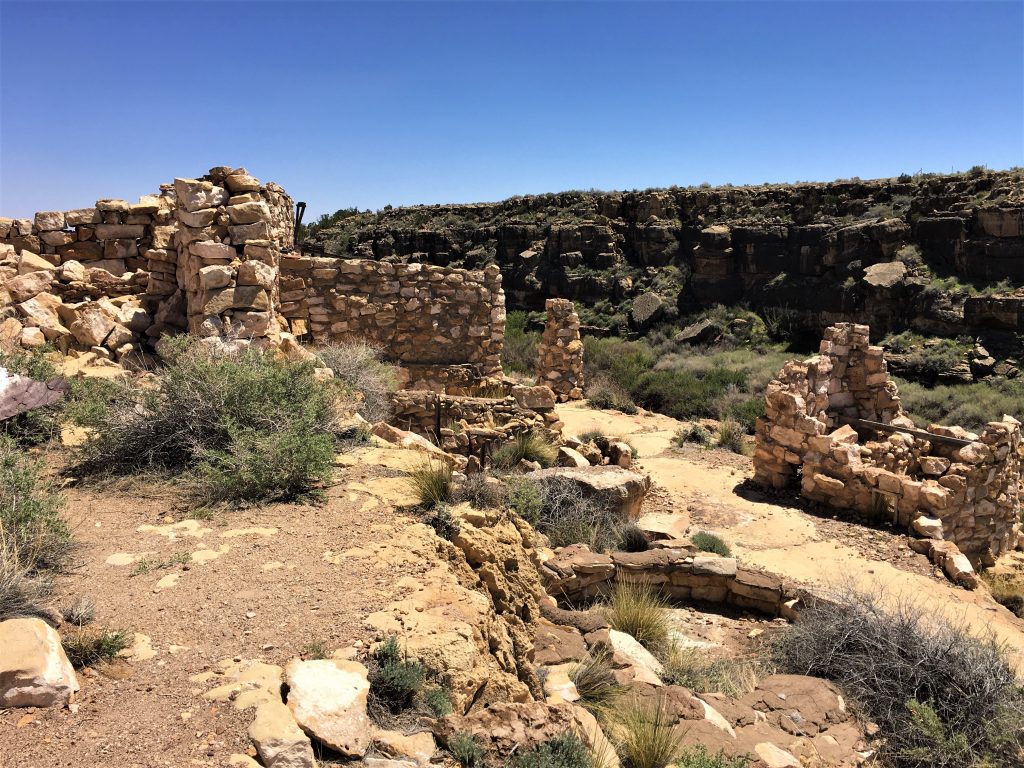
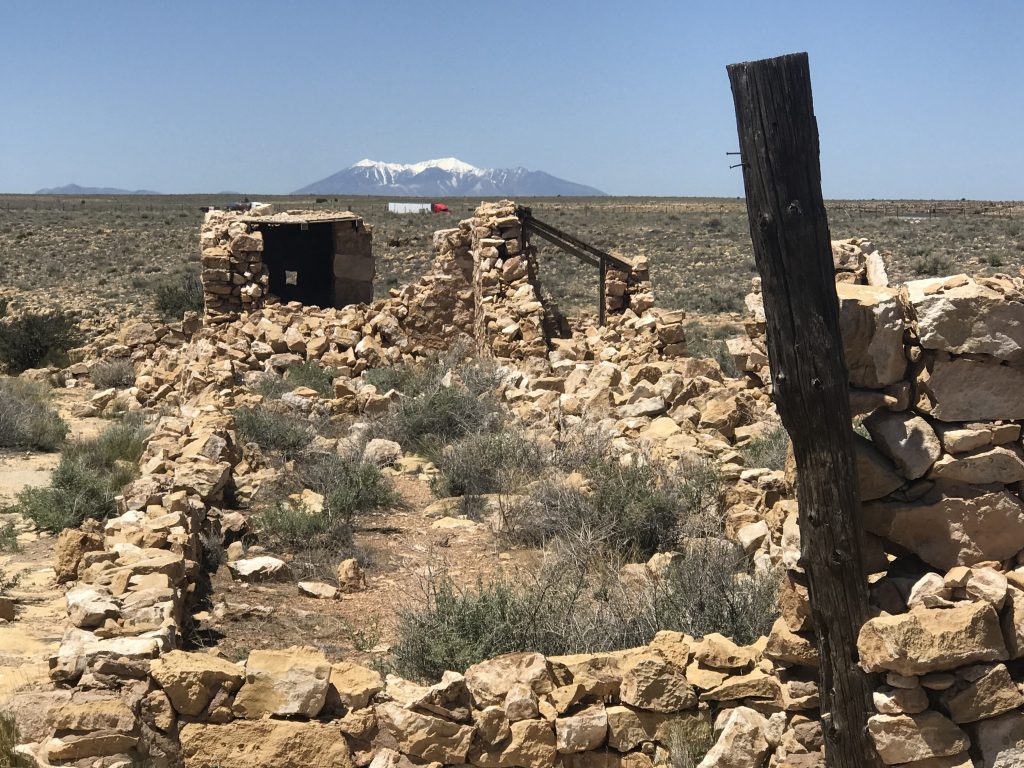
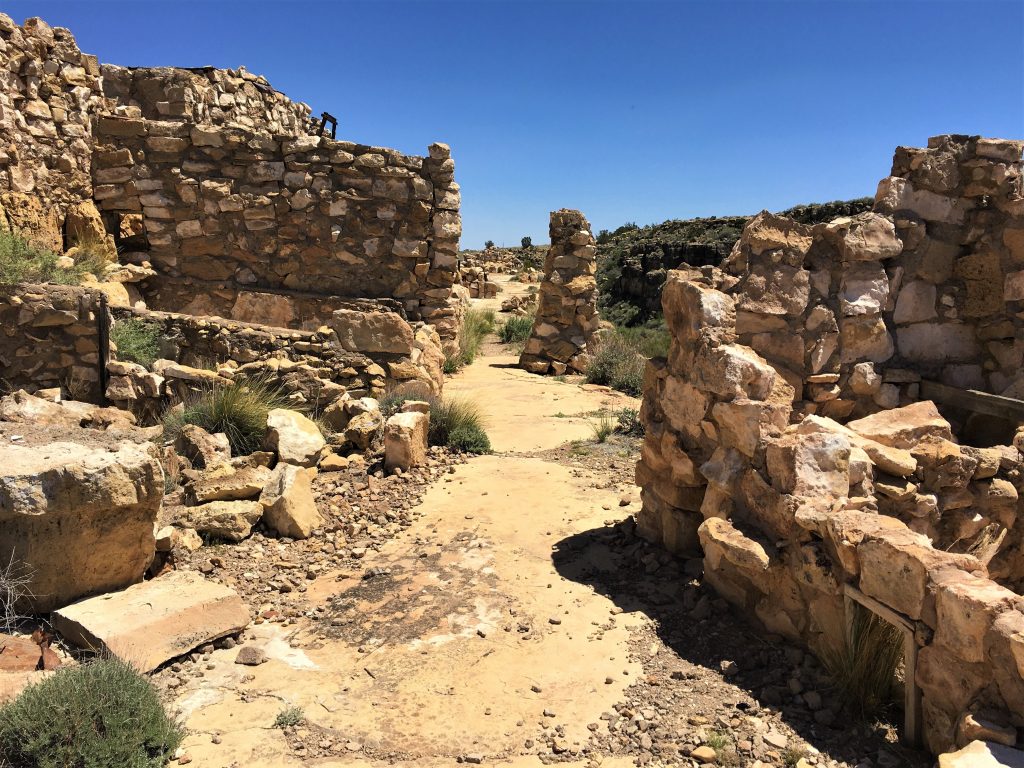
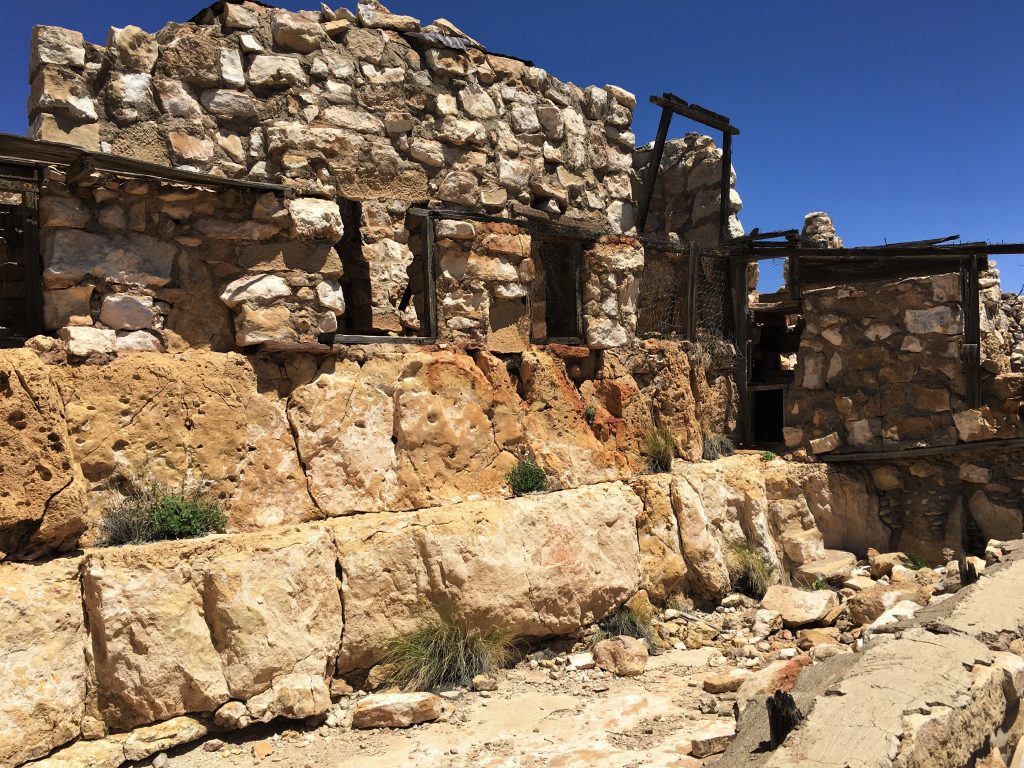
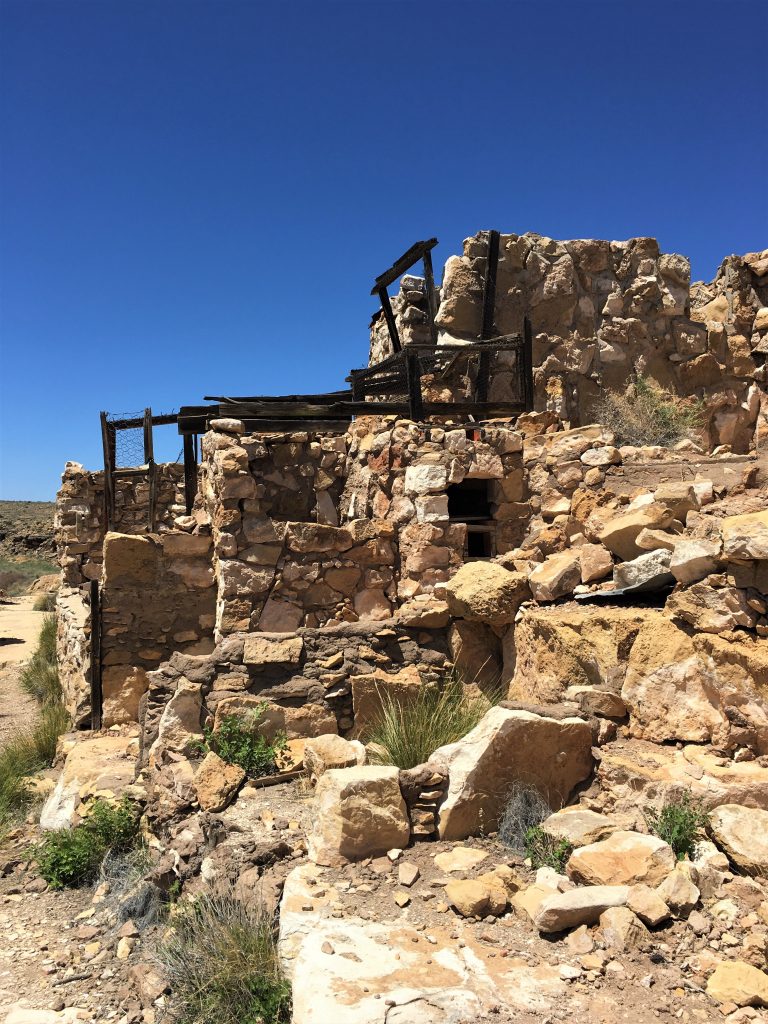
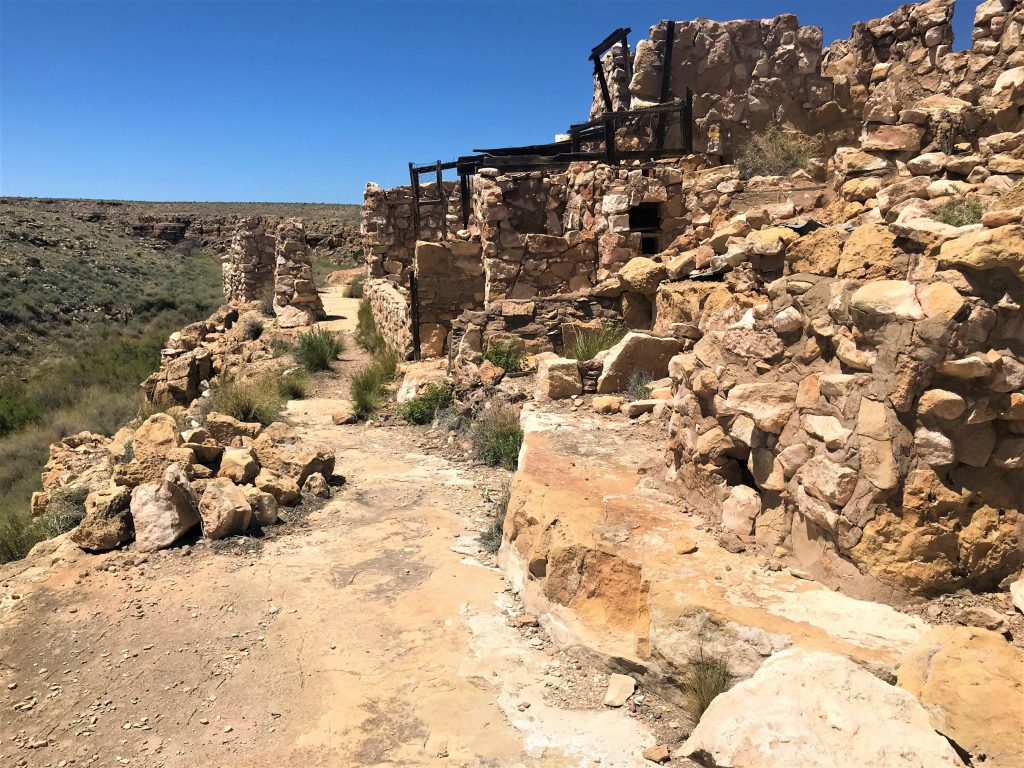
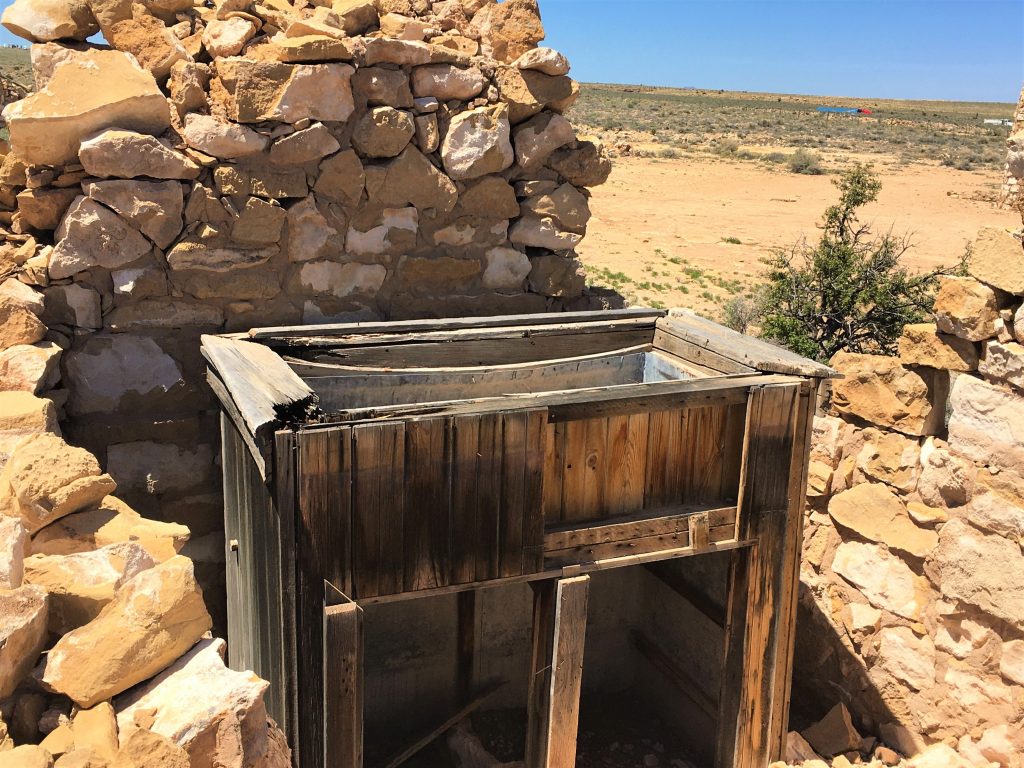
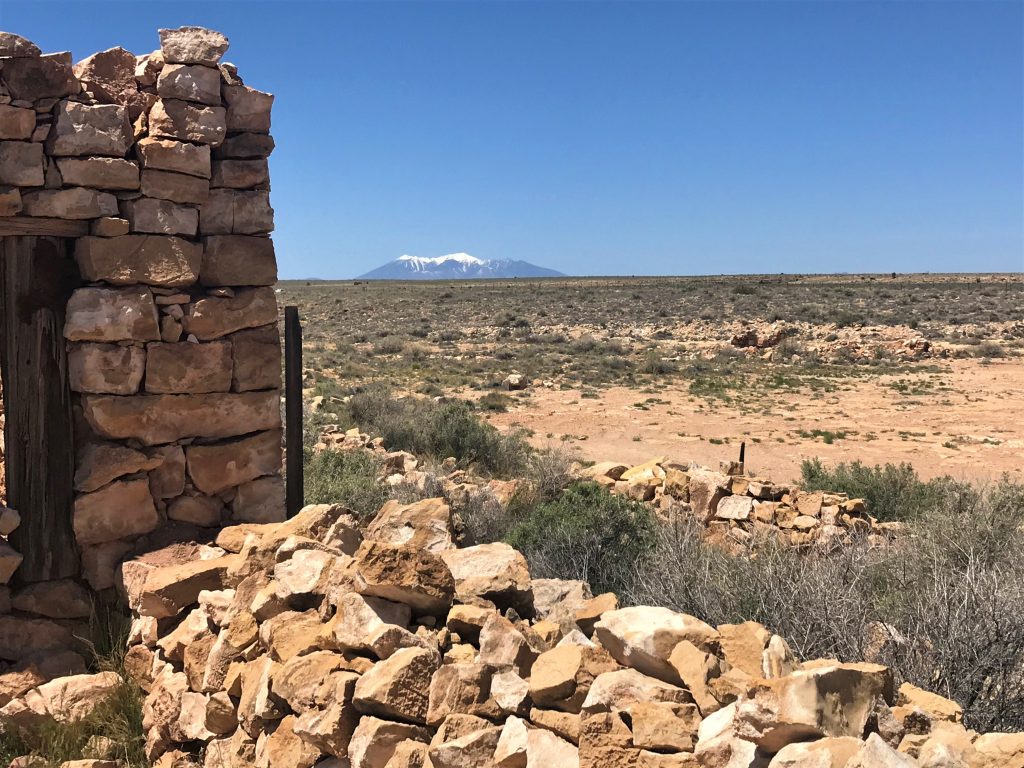

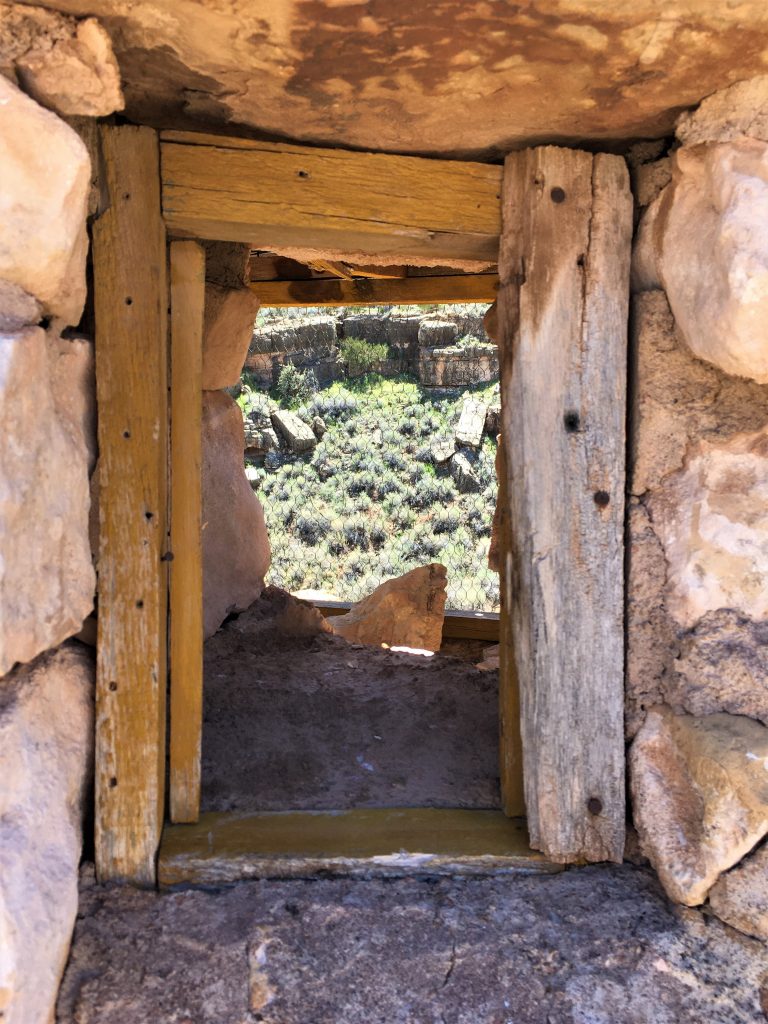
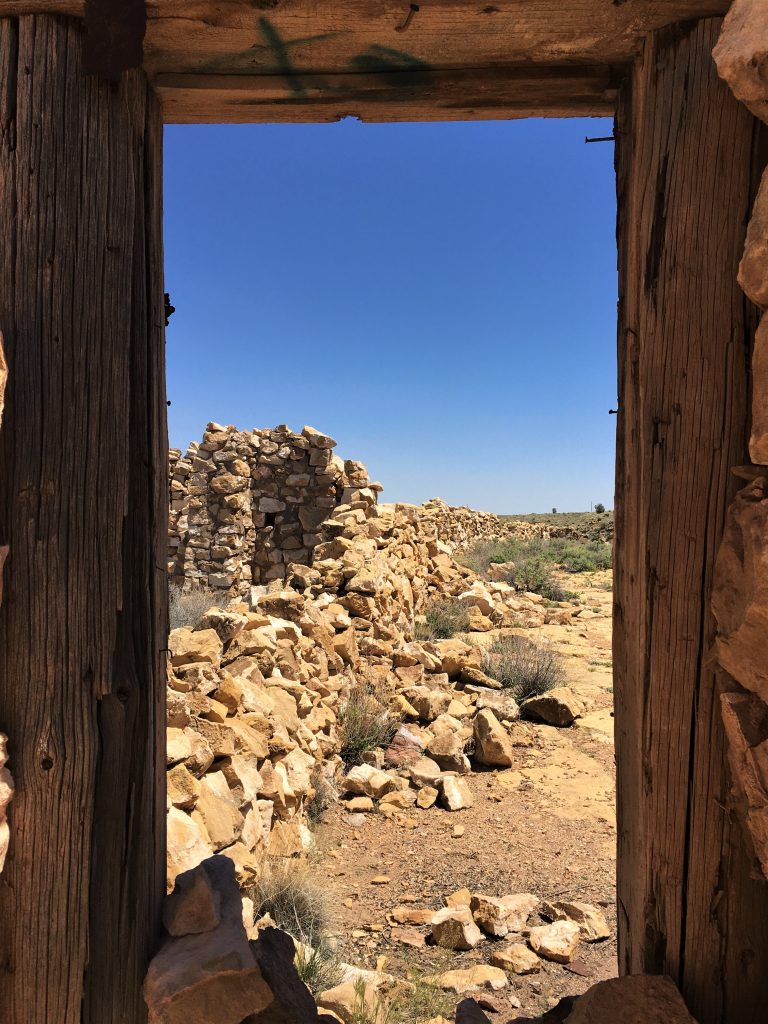
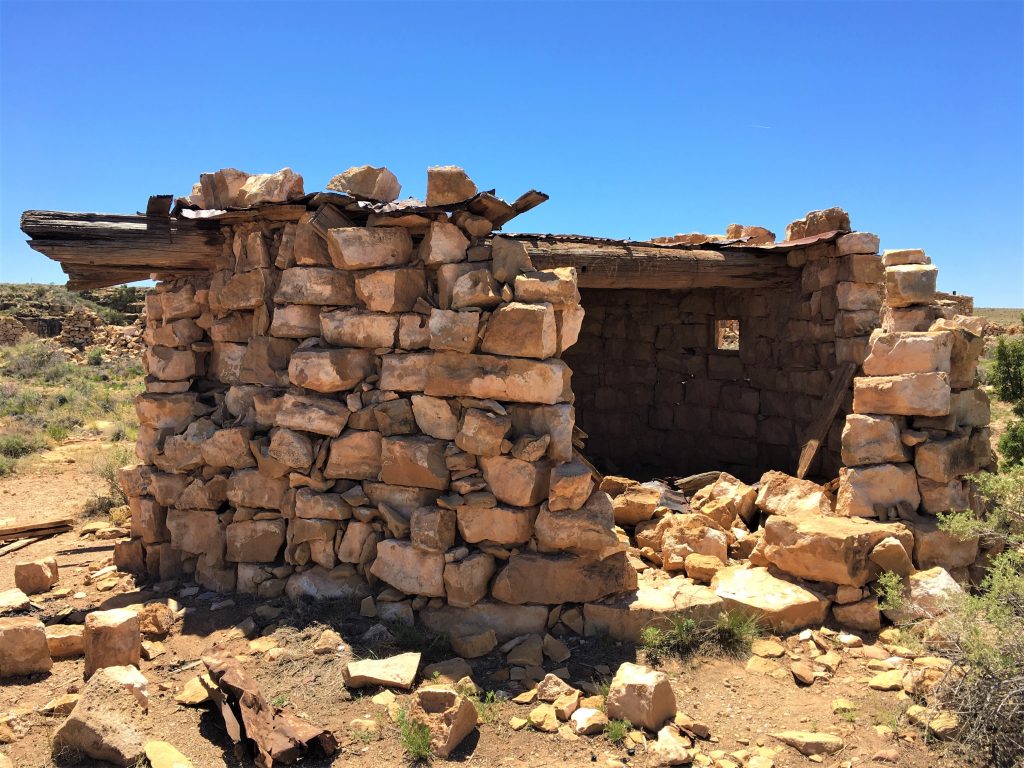
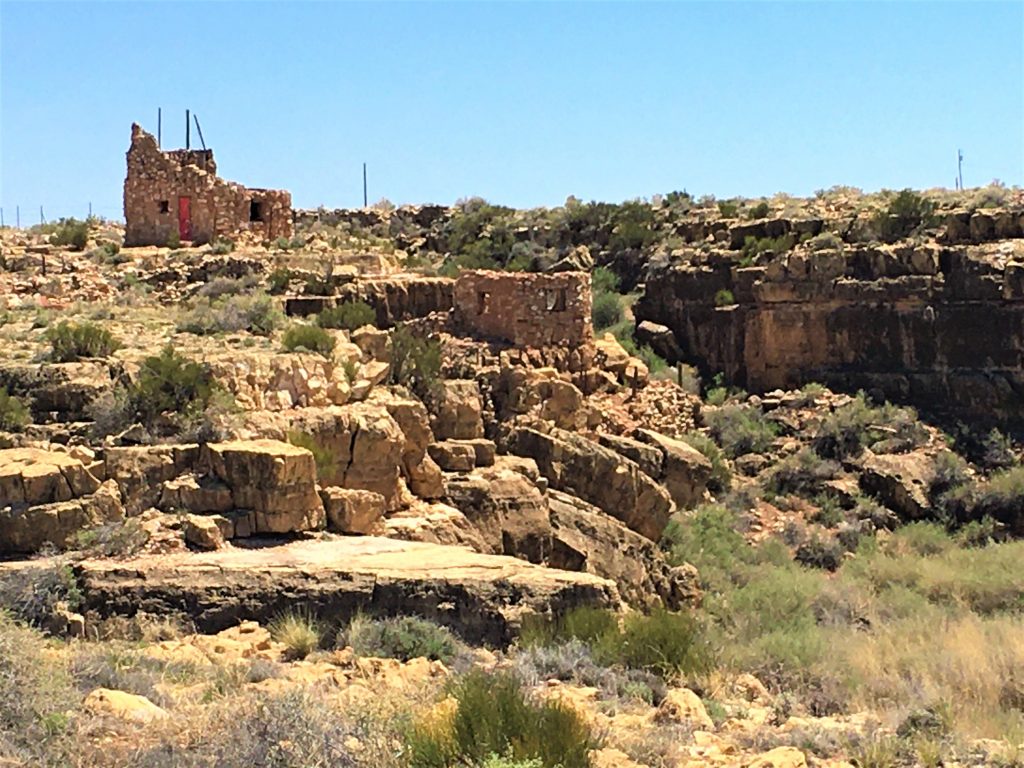
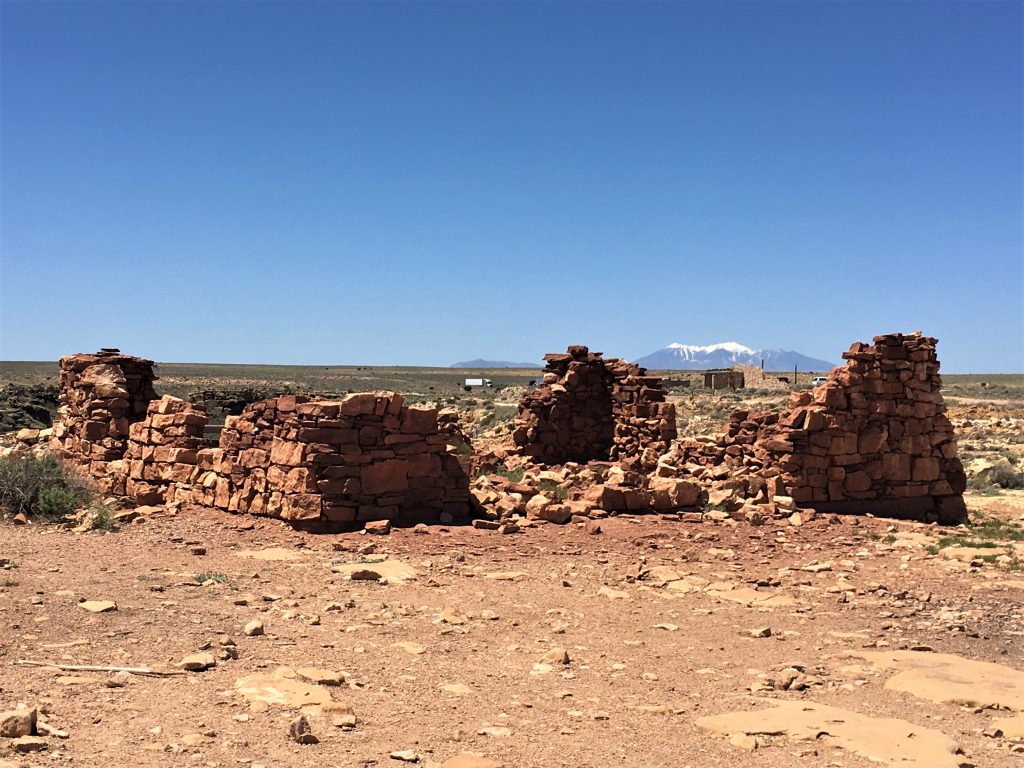
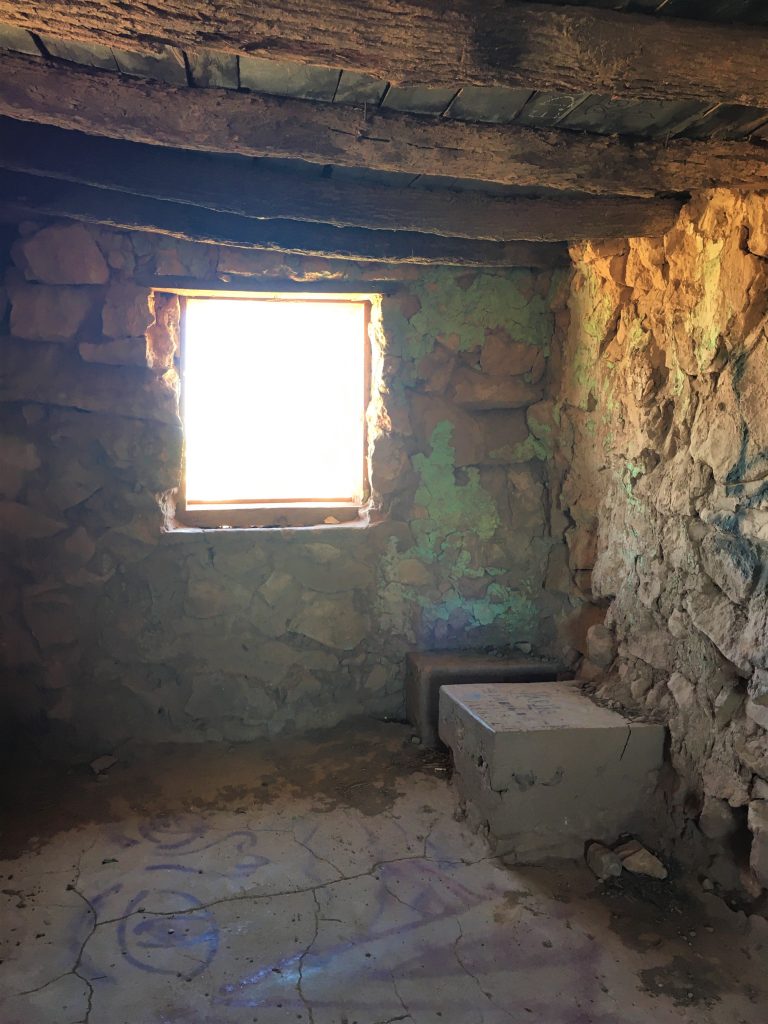
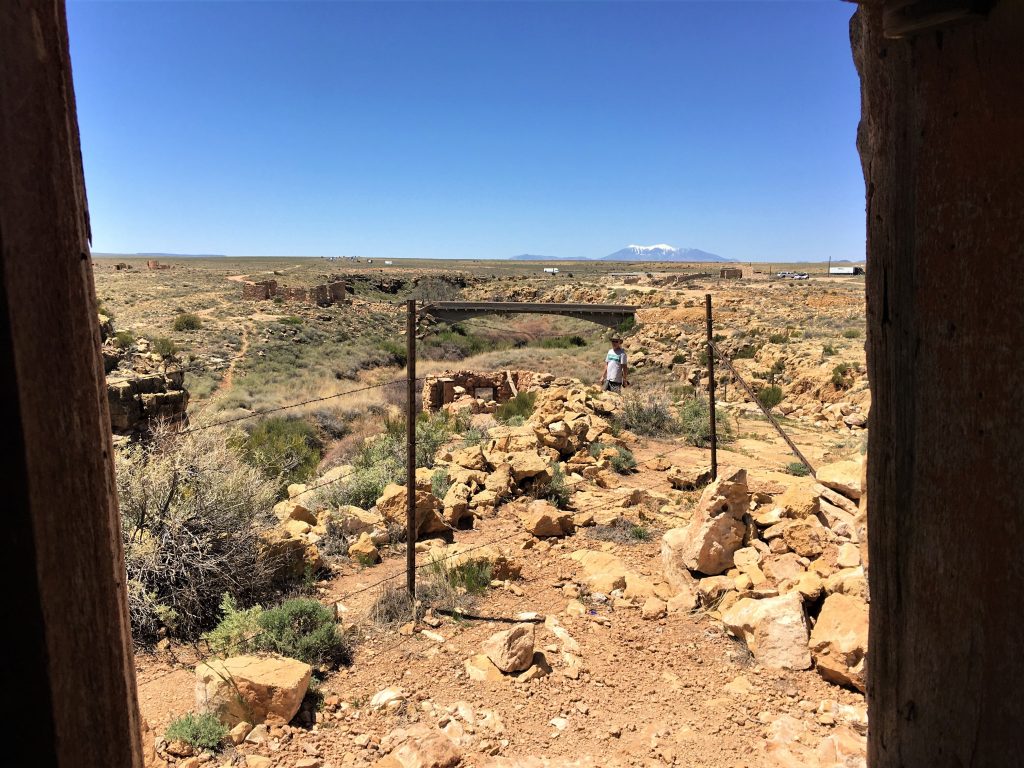
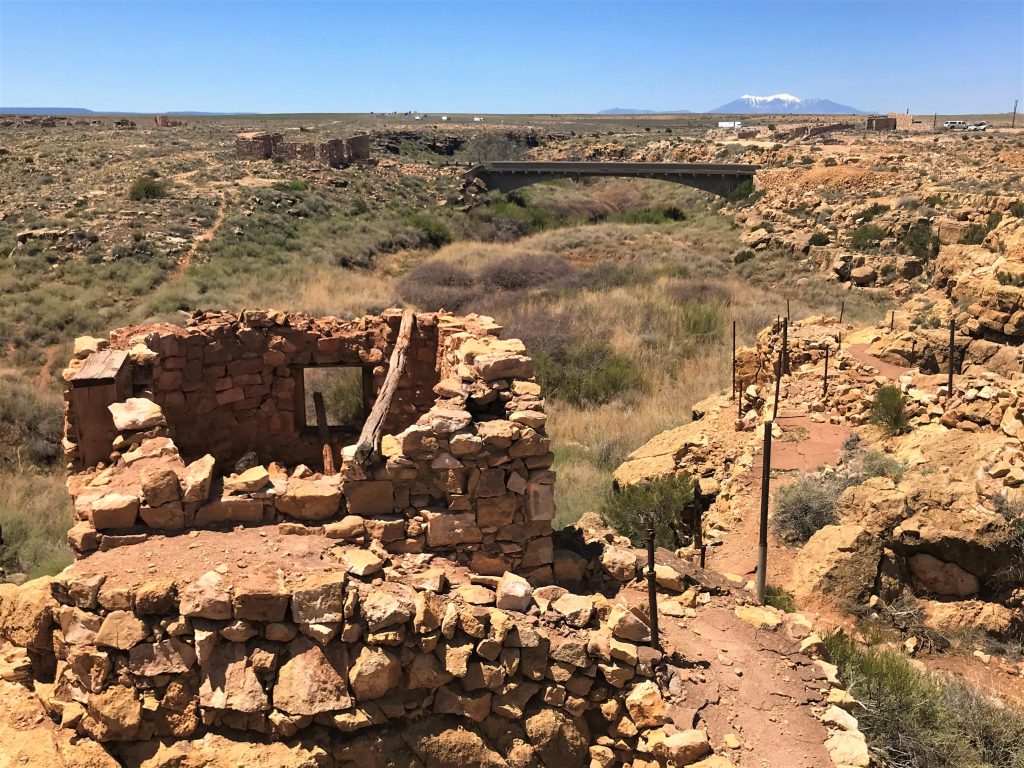
either for the animals to get around, or people to look at them.
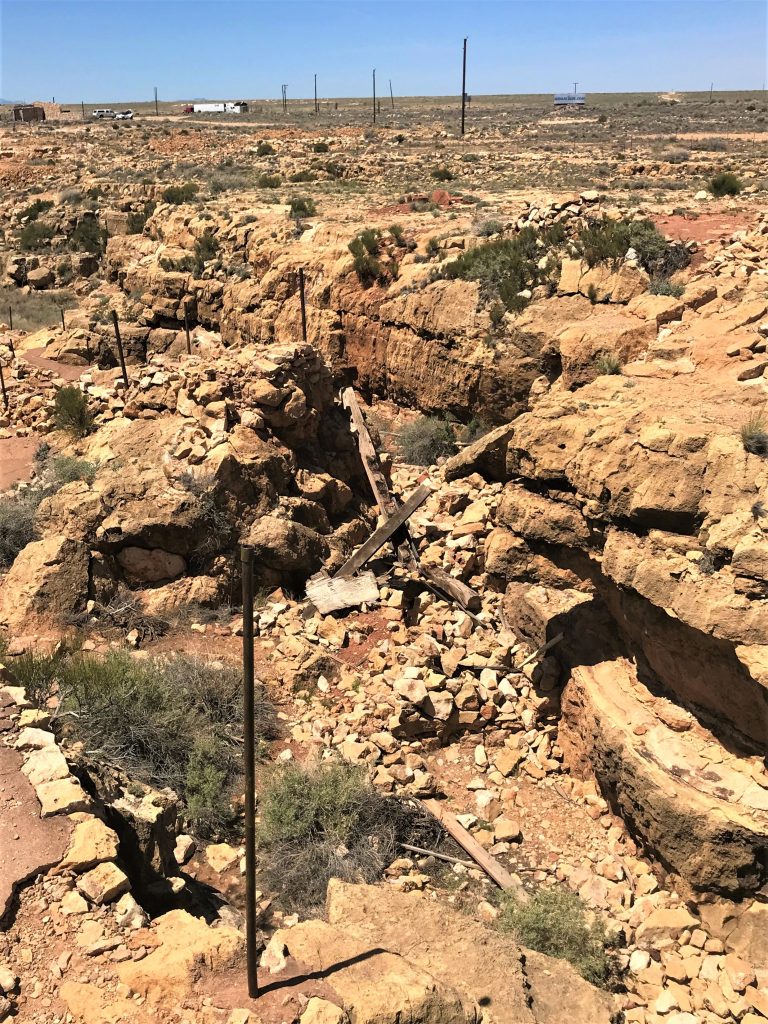
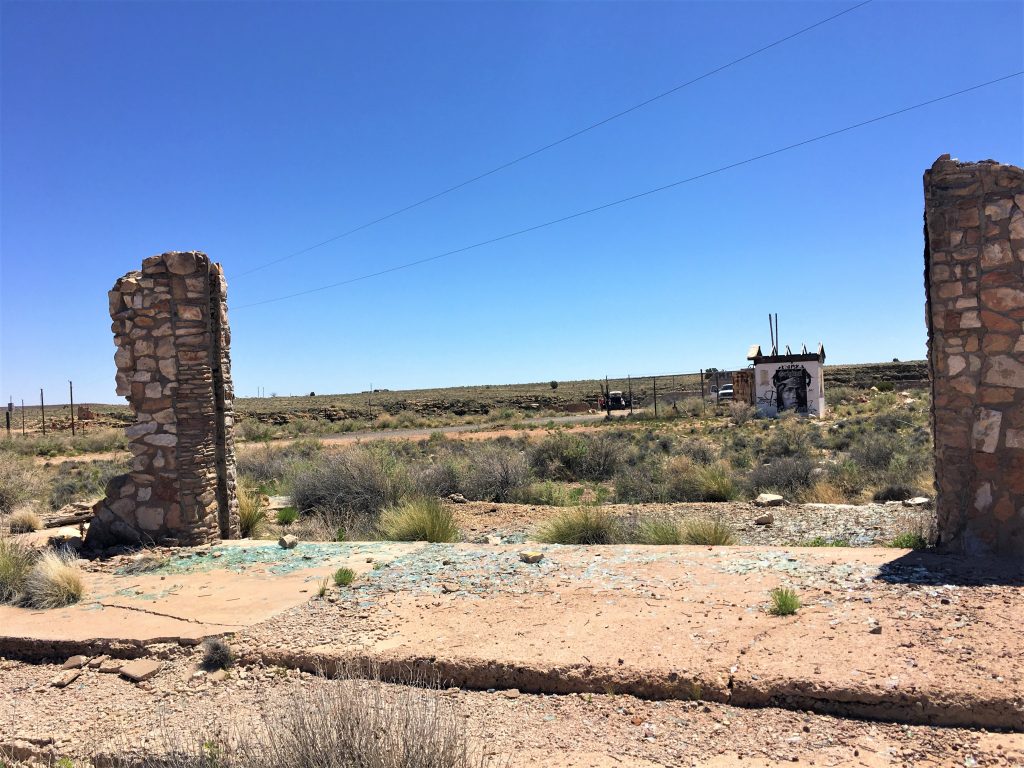

Russell Crowe currently owns it – for the paultry sum of $3 million back in 2010. You can’t help it. Ya gotta ask yourself . . . why?? Rumor has it, he was/is planning on a remake of the movie “WestWorld”.
Above additional information sources provided by either thecrazytourist.com and/or atlasobscura.com.
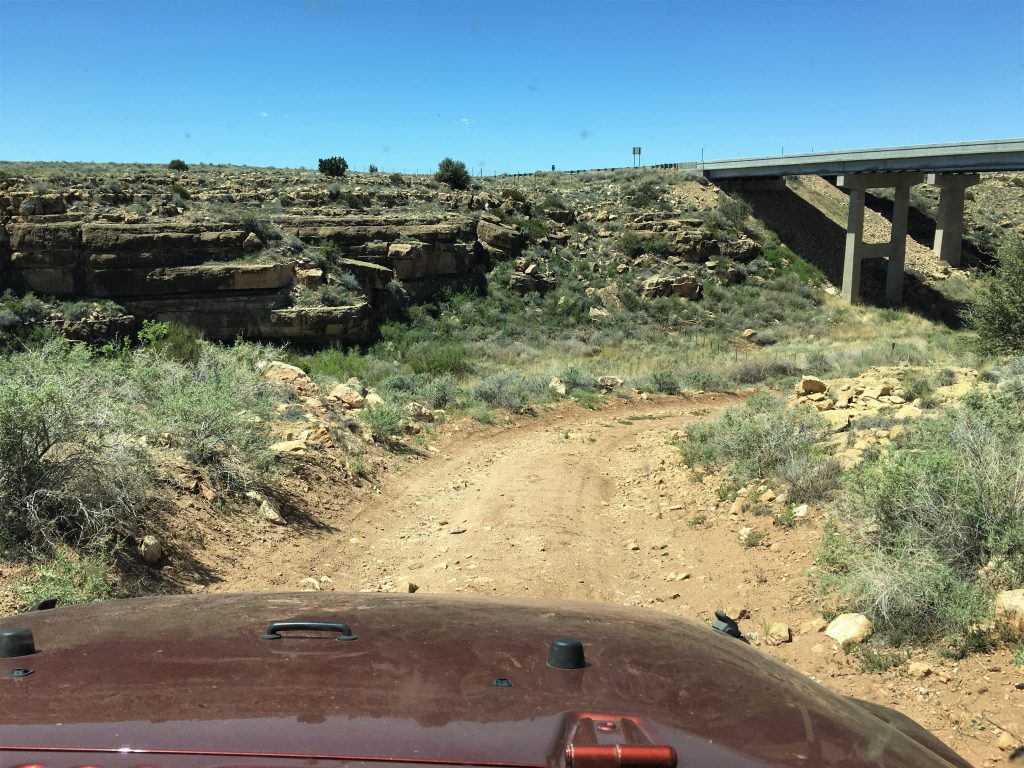
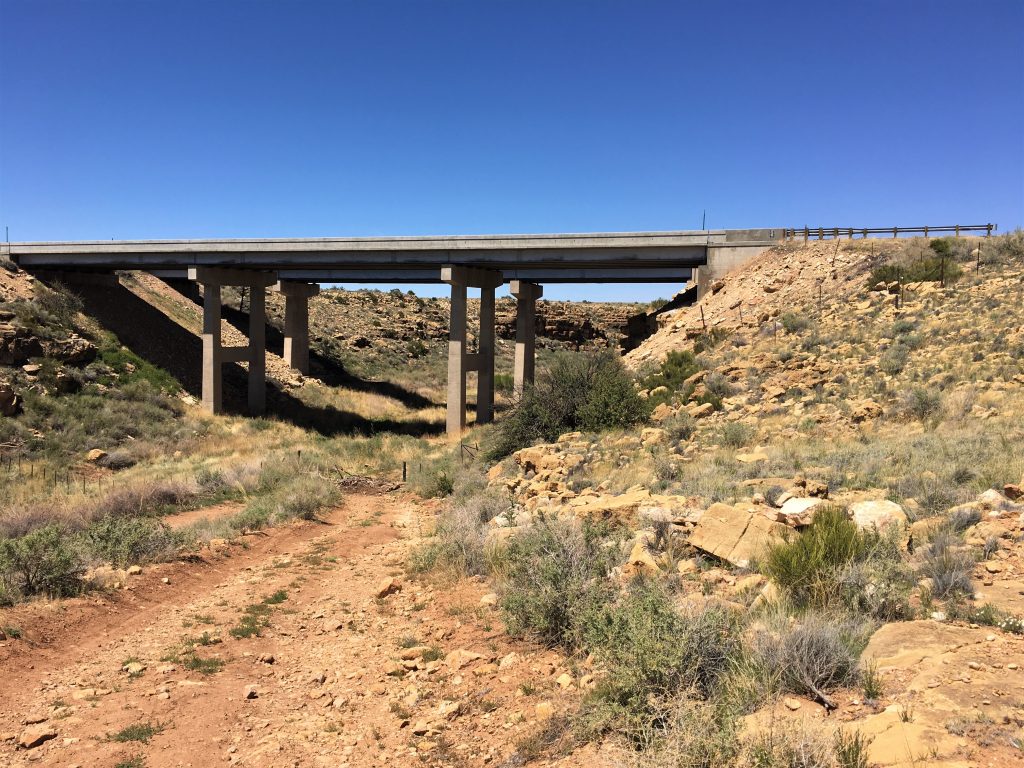
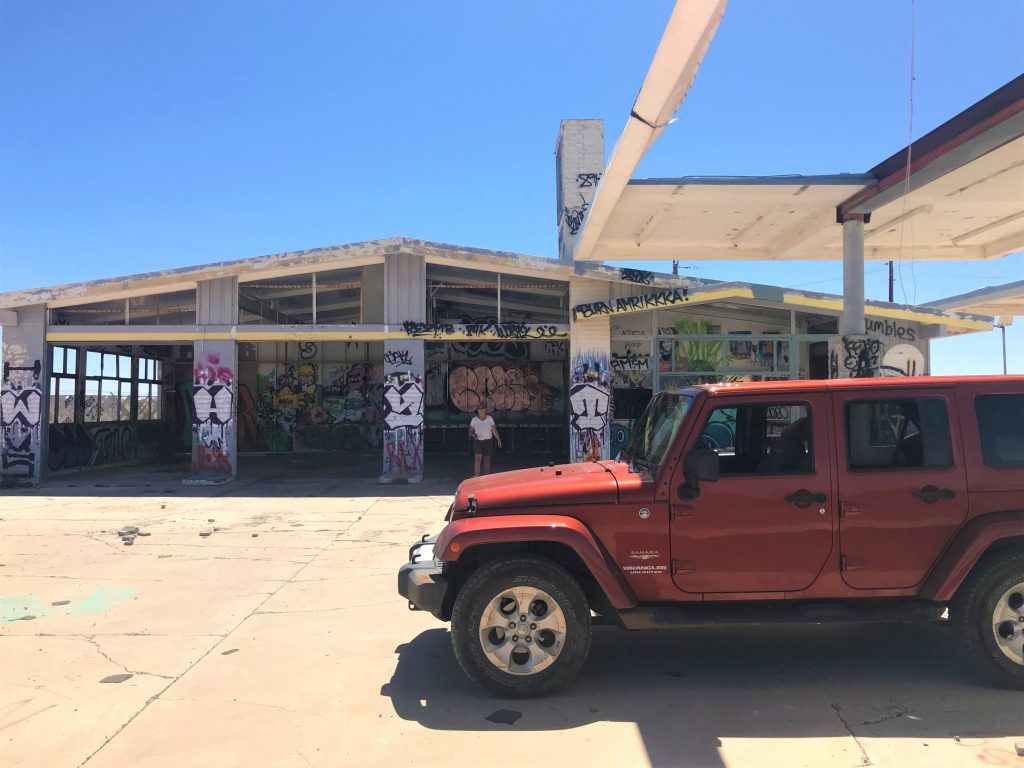
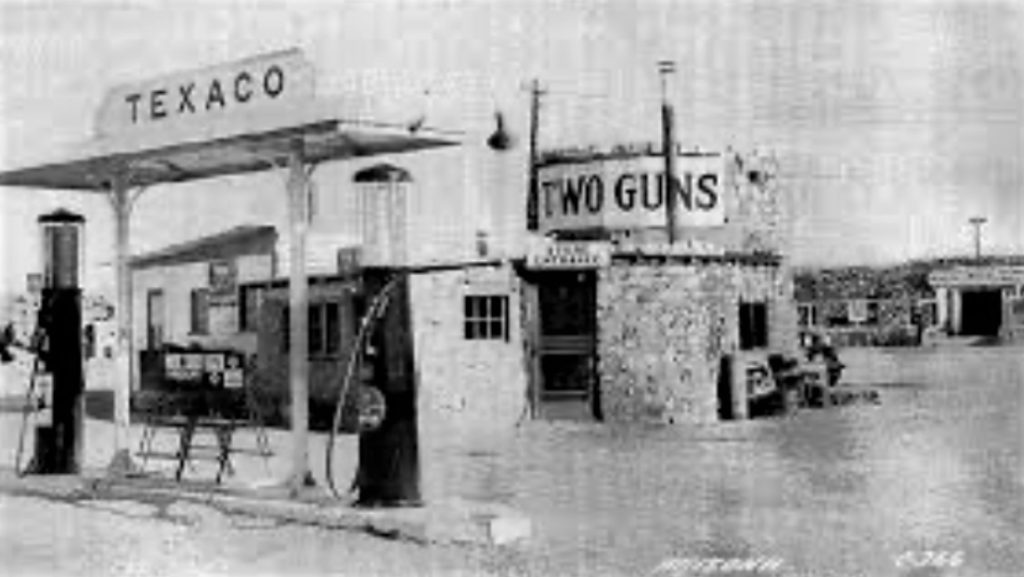
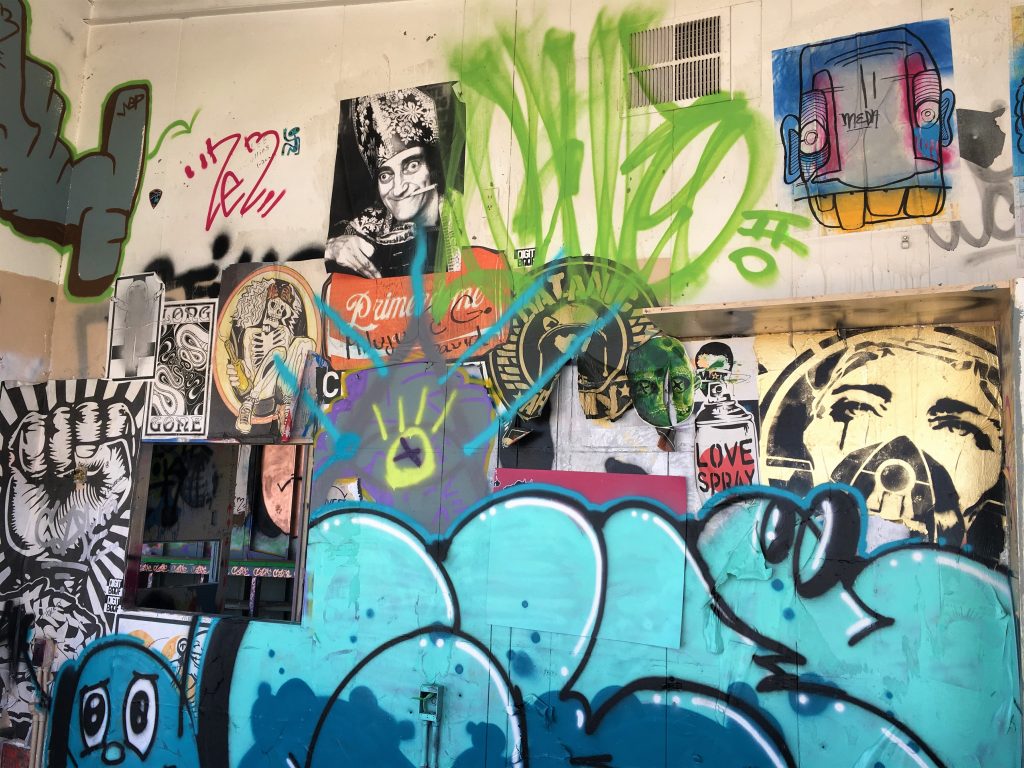
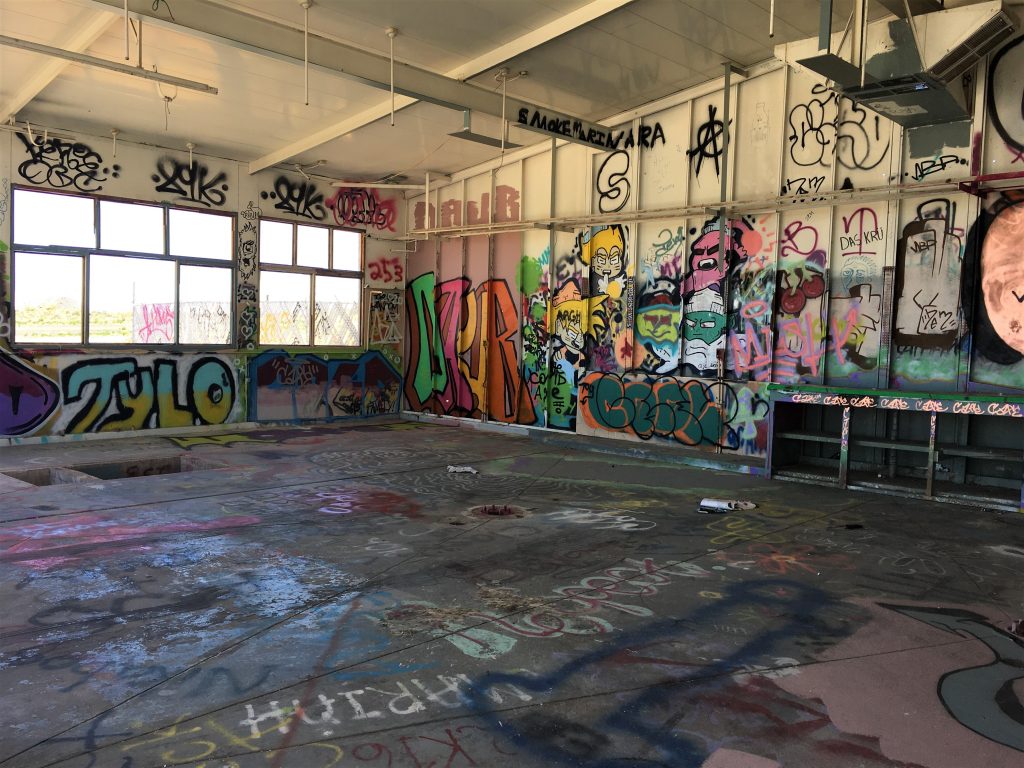
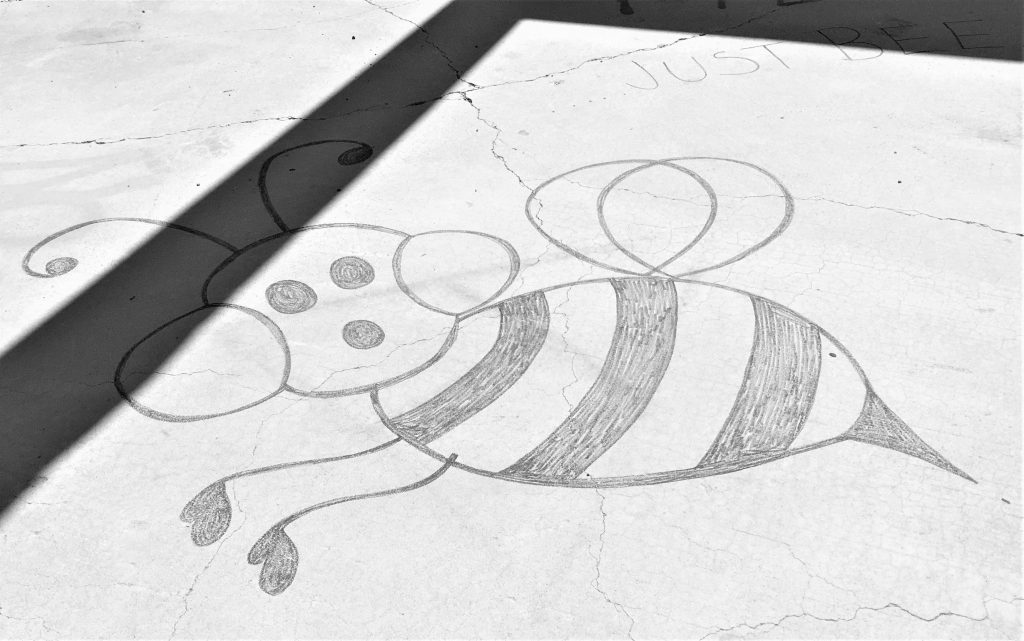
This one’s on the cement at the gas pumps.
Must be a high school kid thing around here. : )
We’d planned on stopping at the grocery store on the way home, but after we got all suited up (masks and gloves) and began the walk from the Jeep to the store, we noticed the long line waiting to get in. No thanks! We’re not quite that desperate! So we drove a short distance to the WalMart and discovered the same thing. We didn’t even get out of the Jeep. Lesson for today? Buy groceries early in the morning, or not at all.
After we abandoned our shopping trip and were on our way home, “Take It Easy” came on the radio! I kid you not!
We came home to find that the high winds that kick up around here in the afternoon had wrecked havoc at our neighbor’s.
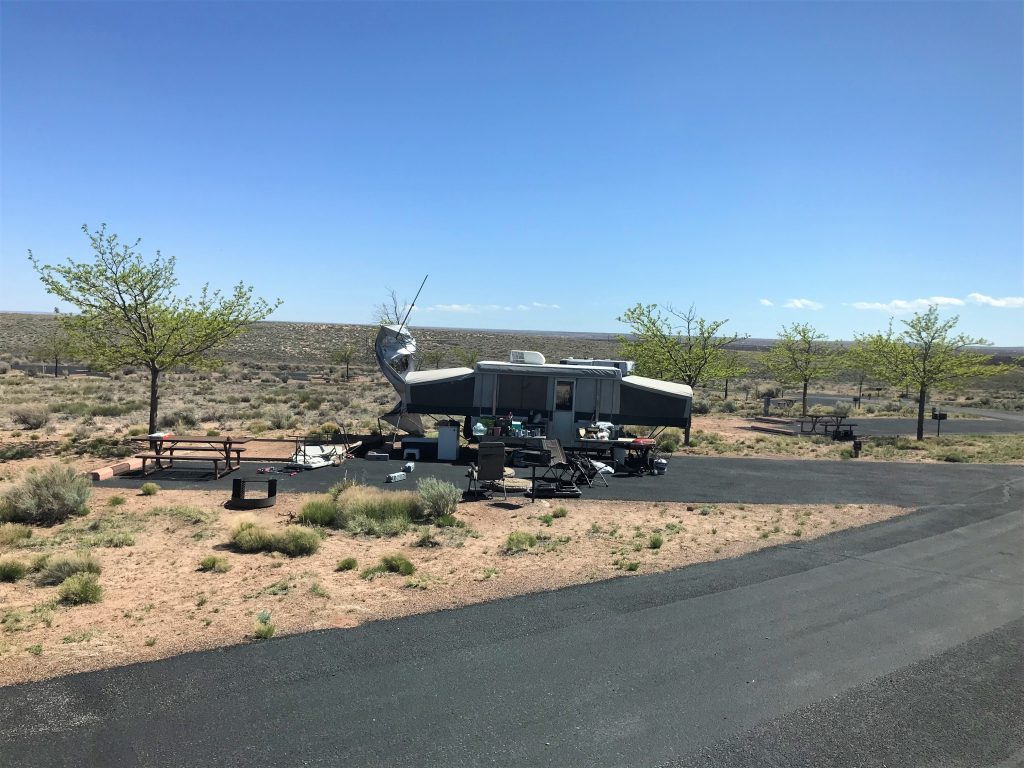

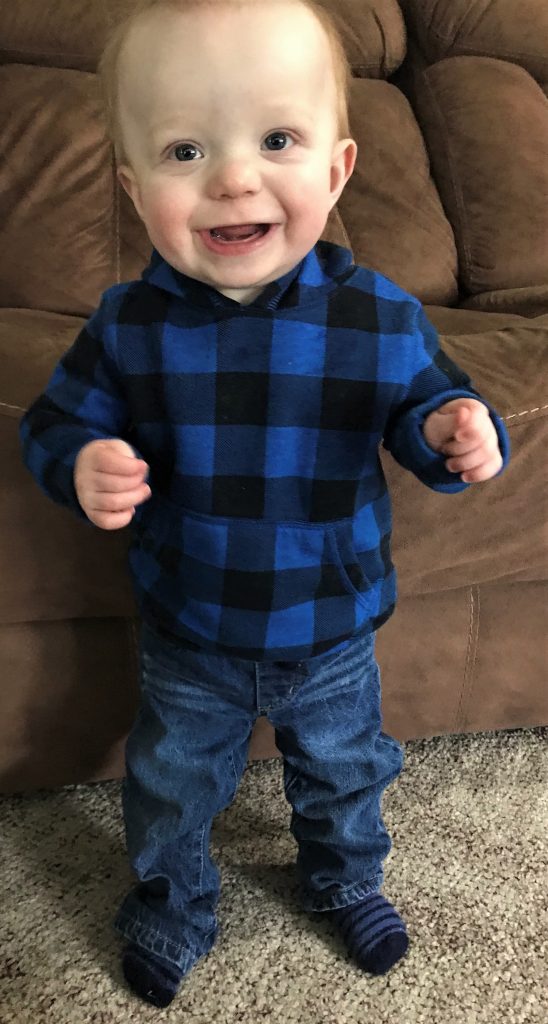
Cooper! Way to go, buddy!
Some think he looks like Blaine. What do you think?
God chose to grace us with a beautiful sunset to end our day!
